D Link AP2230A1 Wireless N PoE Access Point User Manual Part 1
D Link Corporation Wireless N PoE Access Point Users Manual Part 1
D Link >
Contents
- 1. Users Manual Part 1
- 2. Users Manual Part 2
Users Manual Part 1


iD-Link DAP-2230 User Manual
D-Link reserves the right to revise this publication and to make changes in the content hereof without obligation to notify any
person or organization of such revisions or changes.
Manual Revisions
Trademarks
D-Link and the D-Link logo are trademarks or registered trademarks of D-Link Corporation or its subsidiaries in the United
States or other countries. All other company or product names mentioned herein are trademarks or registered trademarks of
their respective companies.
Copyright © 2015 by D-Link Corporation, Inc.
All rights reserved. This publication may not be reproduced, in whole or in part, without prior expressed written permission
from D-Link Corporation, Inc.
Revision Date Description
1.00 June 30, 2015 • Initial release for revision A1
Preface

iiD-Link DAP-2230 User Manual
Table of Contents
Preface ................................................................................. i
Product Overview ..............................................................1
Package Contents .........................................................................1
System Requirements ................................................................. 2
Introduction ...................................................................................3
Features ............................................................................................4
Hardware Overview .....................................................................5
Top Panel .................................................................................5
Hardware Overview .....................................................................6
Bottom Panel ..........................................................................6
Physical Installation ..........................................................7
Before You Begin ...................................................................7
Connect to your Network .......................................................... 8
Method 1 - Powered by PoE Switch ............................... 8
Method 2 - Powered by PoE Injector ............................. 9
Method 3 - DC Adapter .....................................................10
Mounting the AP ........................................................................11
Wireless Installation Considerations .................................... 12
Four Operational Modes .................................................13
Conguration ...................................................................14
Web-based Conguration Utility ..........................................14
Save and Activate Settings ...................................................... 15
Basic Settings ...............................................................................16
Wireless .................................................................................16
Access Point mode ........................................................16
WDS with AP mode ......................................................18
WDS mode .......................................................................20
Wireless Client mode ....................................................22
Authentication Types ........................................................24
Open System/Shared Key Authentication ...........24
WPA/WPA2-Personal Authentication ...................... 25
WPA/WPA2-Enterprise Authentication ..................26
802.1x Authentication .................................................. 27
LAN .........................................................................................28
IPv6 ..........................................................................................29
Advanced Settings .....................................................................30
Performance .........................................................................30
Wireless Resource Control .......................................................32
Multi-SSID ..............................................................................34
VLAN ........................................................................................35
VLAN List ...........................................................................35
Port List ..............................................................................36
Add/Edit VLAN ................................................................37
PVID Setting .....................................................................38
Intrusion .................................................................................39
Schedule ................................................................................40
Internal RADIUS Server .....................................................41
ARP Spoong Prevention Settings ...............................42
Bandwidth Optimization .................................................43
AP Array ..................................................................................45
Table of Contents

iiiD-Link DAP-2230 User Manual
Table of Contents
AP Array Scan ..................................................................45
Conguration Settings ................................................. 46
Auto-RF .............................................................................. 47
Load Balance ...................................................................48
Captive Portal Authentication........................................49
Web Redirection Only ..................................................49
Username/Password .....................................................50
Username/Password .....................................................50
Passcode ...........................................................................51
Remote Radius ................................................................52
LDAP ...................................................................................53
POP3 ...................................................................................55
Login Page Upload .............................................................56
Login Page Upload .............................................................56
IP Filter ....................................................................................57
MAC Bypass...........................................................................58
DHCP Server ........................................................................59
Dynamic Pool Settings ................................................. 59
Static Pool Setting .........................................................60
Current IP Mapping List ...............................................61
Filters .......................................................................................62
Wireless MAC ACL ..........................................................62
WLAN Partition ...............................................................63
Trac Control ....................................................................... 64
Uplink/Downlink Settings ..........................................64
QoS ...................................................................................... 65
Trac Manager ...............................................................66
Status .............................................................................................67
Device Information ............................................................67
Client Information ..............................................................68
WDS Information ................................................................69
Channel Analyze .................................................................70
Statistics .................................................................................71
Ethernet ............................................................................. 71
WLAN Trac ....................................................................72
Log ...........................................................................................73
View Log ............................................................................73
Log Settings .....................................................................74
Maintenance ...............................................................................76
Administration Settings ...................................................76
Limit Administrator .......................................................77
System Name Settings .................................................78
Login Settings .................................................................79
Console Settings ............................................................80
SNMP Settings ................................................................81
Status: ................................................................................. 82
Ping Control .....................................................................82
Central WiFiManager Settings ...................................83
Firmware and SSL Certication Upload ..............................84
Conguration File Upload .......................................................85
Time and Date .............................................................................86
System ....................................................................................87
System Settings ..............................................................87
Help .................................................................................................88
Wireless Security .............................................................89
What is WEP? ................................................................................90
Congure WEP .............................................................................91

ivD-Link DAP-2230 User Manual
Table of Contents
What is WPA? ................................................................................92
Congure WPA/WPA2 Personal .............................................93
Congure WPA/WPA2 Enterprise ..........................................94
Connect to a Wireless Network ....................................... 95
Using Windows® XP ....................................................................95
Congure WPA-PSK .................................................................... 96
Using Windows Vista® ...............................................................98
Congure WPA-PSK .................................................................100
Using Windows® 7 .................................................................... 101
Troubleshooting ............................................................104
Wireless Basics ...............................................................108
What is Wireless? ......................................................................109
Tips ................................................................................................111
Wireless Modes .........................................................................112
Networking Basics .........................................................113
Check your IP address ............................................................113
Statically Assign an IP address ............................................114
Technical Specications ................................................115
Antenna Pattern ............................................................117
Regulatory Information ................................................118

1D-Link DAP-2230 User Manual
Section 1 - Product Overview
Note: Using a power supply with a dierent voltage rating will cause damage and void the warranty for this product.
Package Contents
DAP-2230 Wireless N PoE Access Point
Quick Installation Guide
12 V DC, 1 A Power Adapter (included with
some models)
Wall mounting bracket with
mounting kit
If any of the above items are missing, please contact your reseller.

2D-Link DAP-2230 User Manual
Section 1 - Product Overview
System Requirements
Network Requirements
• An Ethernet-based Network
• IEEE 802.11n/g wireless clients (AP Mode)
• IEEE 802.11n/g wireless network (AP Mode)
Web-based Conguration
Utility Requirements
Computer with the following:
• Windows®, Macintosh, or Linux-based operating system
• An installed Ethernet adapter
Browser Requirements:
• Microsoft Internet Explorer® 7, Mozilla® Firefox® 12.0,
Google® Chrome 20.0, or Safari® 4 or higher
Windows® Users: Make sure you have the latest version of Java installed.
Visit www.java.com to download the latest version.

3D-Link DAP-2230 User Manual
Section 1 - Product Overview
Introduction
The D-Link DAP-2230 Wireless N PoE Access Point is an 802.11n compliant device that delivers real world performance of up to
300 Mbps* while still maintaining backwards compatibility with slower 802.11g and 802.11b devices. The DAP-2230 increases
productivity by allowing you to work faster and more eciently. With the DAP-2230, bandwidth-intensive applications like
graphics or multimedia will benet signicantly because large les are now able to move across the network more quickly.
Create a secure wireless network to share photos, les, music, video, printers, and network storage outside of your normal
internal networking environment. Built to withstand harsh environments, the DAP-2230 also excels in connecting separate
networks that cannot be joined physically using a traditional medium. The built-in omni-directional 3 dBi antenna is designed
to deliver high performance, ensuring that wireless coverage will cover even hard to reach locations. The DAP-2230 is an ideal
solution for quickly creating and extending a wireless local area network (WLAN) in oces or other workplaces, hotels, resorts,
trade shows, and special events.
The DAP-2230 features four dierent operation modes: Access Point, Wireless Distribution System (WDS), WDS with AP, and
Wireless Client mode, allowing it to adapt to many situations. As a standard wireless Access Point (AP) the DAP-2230 can connect
to a wide range of devices that are 802.11 n/g/b compliant. In WDS mode it can expand current wireless coverage without the
need for a wired backbone link. As a wireless client it can connect to an existing AP, and expand the network physically with
the built-in 10/100 Ethernet port.
The DAP-2230 supports 64/128-bit WEP data encryption and WPA/WPA2 security functions. In addition, it provides MAC Address
Filtering to control user access, and the Disable SSID Broadcast function to limit unauthorized access to the internal network.
Network administrators have multiple options for managing the DAP-2230, including Web (HTTP) or Secured Web (HTTPS).
For advanced network management, administrators can use SNMP v1, v2c, v3 to congure and manage access points.
*Maximum wireless signal rate derived from IEEE Standard 802.11n and 802.11g specications. Actual data throughput may vary. Network conditions
and environmental factors, including volume of network trac, building materials and construction, and network overhead can lower actual data
throughout rate.

4D-Link DAP-2230 User Manual
Section 1 - Product Overview
• Faster Wireless Networking - The DAP-2230 provides an up to 300 Mbps* wireless connection with other 802.11n
wireless clients. This capability allows users to participate in real-time activities online, such as video streaming, online
gaming, and real-time audio.
• Compatible with IEEE802.11g Devices - The DAP-2230 is still fully compatible with the 802.11g standards, so it can
connect with existing 802.11g adapters.
• Four dierent operation modes - Capable of operating in one of four dierent operation modes to meet your wireless
networking needs: Access Point, WDS with AP, WDS, and Wireless Client.
• Power over Ethernet - The DAP-2230 supports IEEE 802.3af PoE (Power over Ethernet) which enables it to be supplied
with power over an Ethernet cable or IEEE 802.3af PoE switch.
• Comprehensive Web-Interface - Fine tune network settings using the DAP-2230’s robust network-based conguration
software.
• Central WiFiManager management software compatibility - The real-time display of the network’s topology and
AP’s information makes network conguration and management of multiple devices quick and simple.
• SNMP for management - The DAP-2230 supports SNMP v1, v2c, and v3 for better network management. Superior
wireless AP manager software is bundled with the DAP-2230 for network conguration and rmware upgrade.
Systems administrators can also set up the DAP-2230 easily with the Web-based conguration utility.
• Convenient Installation - The DAP-2230 features a wall mount in the rear for easy setup on walls.
Features
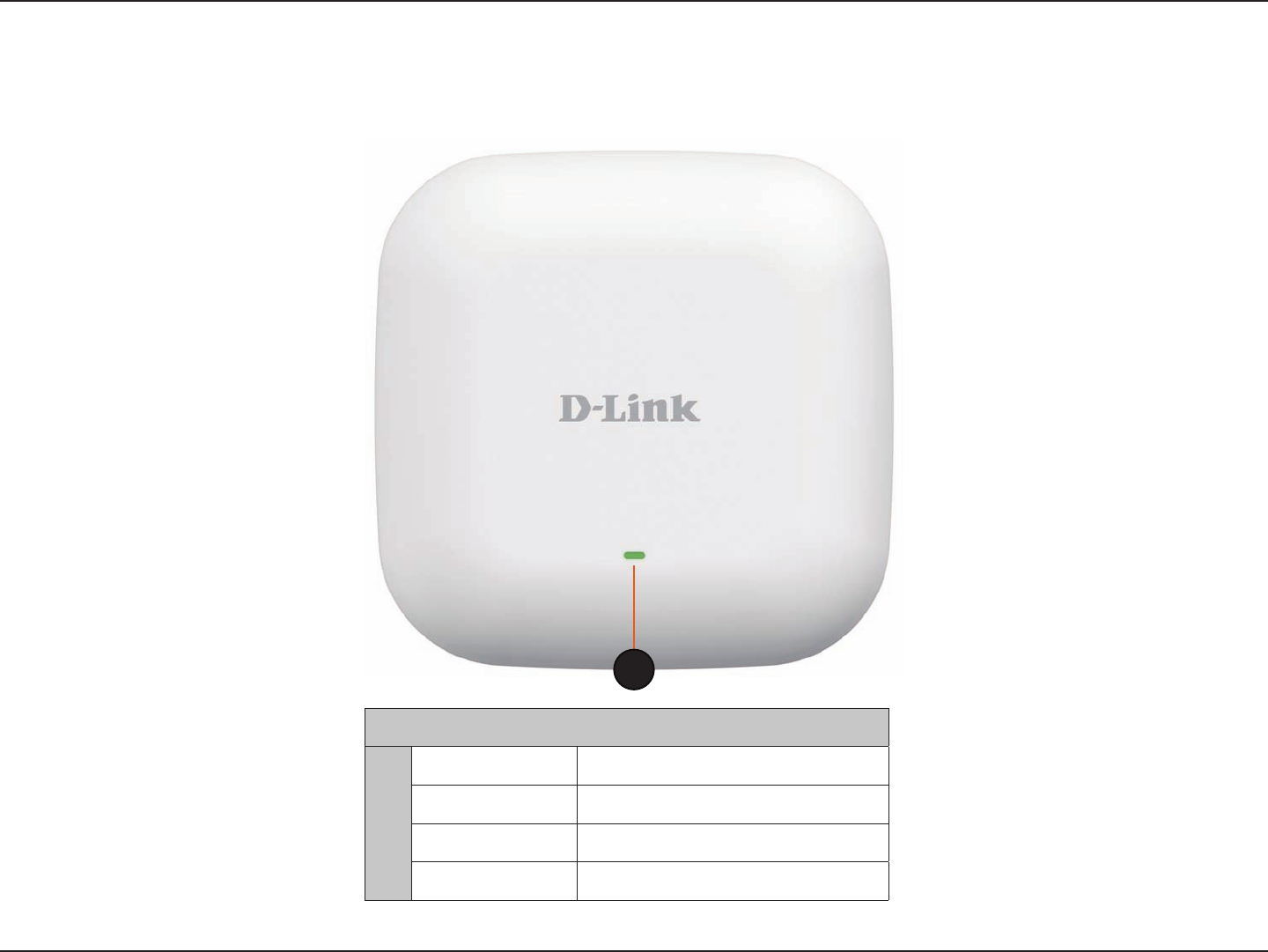
5D-Link DAP-2230 User Manual
Section 1 - Product Overview
Hardware Overview
Top Panel
Power/Status LED
1
Static Green Ready/Working Properly
Flashing Green Transmitting/Receiving data
Flashing Red Malfunction during boot
Solid Red Boot failure
1
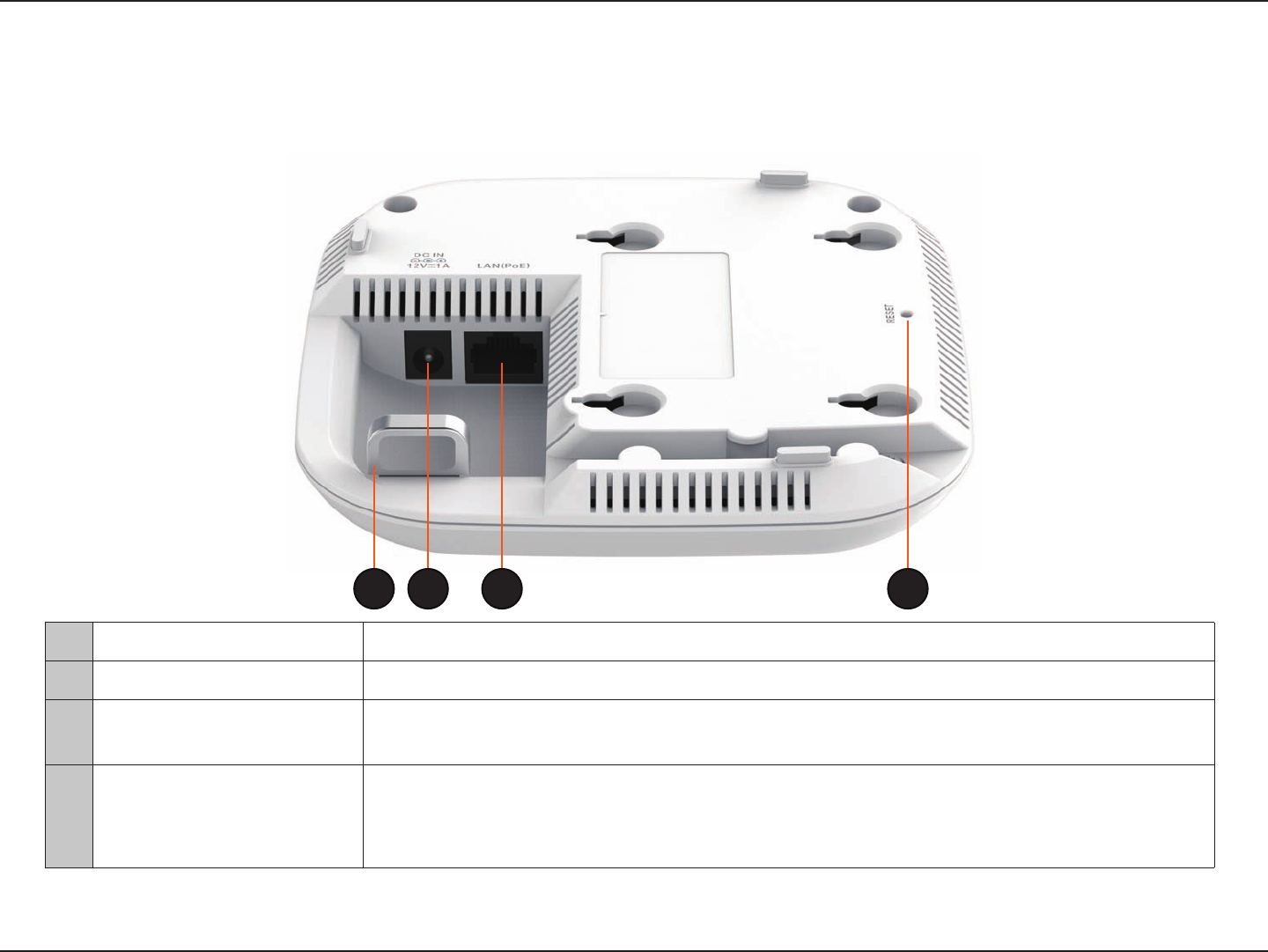
6D-Link DAP-2230 User Manual
Section 1 - Product Overview
Hardware Overview
Bottom Panel
1Security Lock Physically secure your device with this lock.
2Power Connector Connector for a power adapter.
310/100 LAN (PoE)Port Connect an Ethernet cable to this device and your network. Power may be supplied
to this port via a LAN cable that is connected to a PoE injector or PoE switch.
4Reset Button
Press and hold the reset button with a paperclip for at least 5 seconds to reset the
device back to the factory default settings. The LED will turn on for 2 seconds and
then begin the reboot process.
1 2 3 4

7D-Link DAP-2230 User Manual
Section 2 - Installation
This chapter describes safety precautions and product information that you must know and check before installing this product.
Physical Installation
Before You Begin
Professional Installation Required
1. Please seek assistance from a professional installer who is well trained in RF installation and knowledgeable about local
regulations.
2. This product is distributed through distributors and system installers with professional technicians and is not to be sold
directly through retail stores.
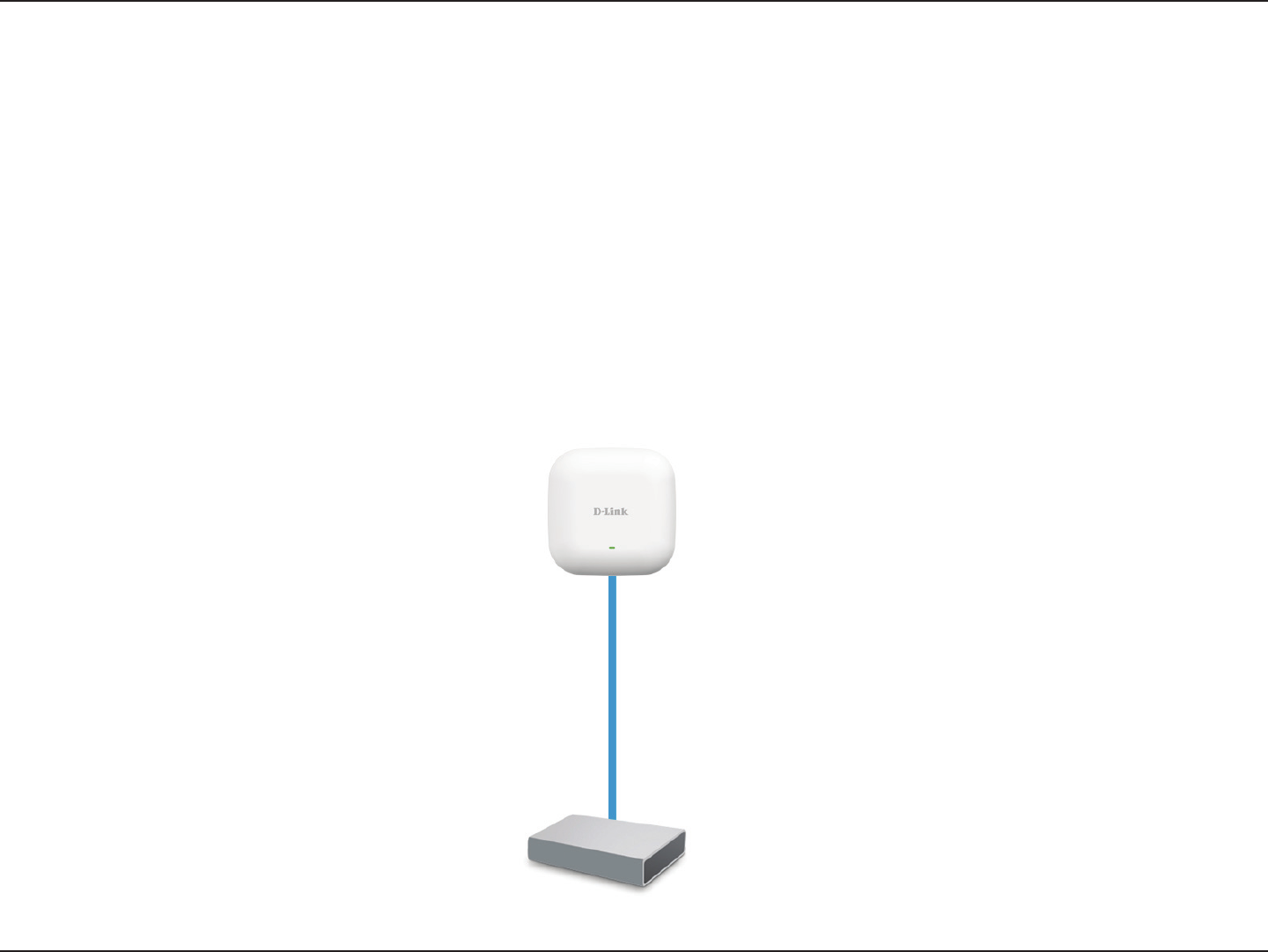
8D-Link DAP-2230 User Manual
Section 2 - Installation
Connect to your Network
Method 1 - Powered by PoE Switch
To power the access point, you can use one of the following 3 methods:
Method 1 - Powered by PoE Switch
Method 2 - Powered by PoE Injector
Method 3 - Powered by DC Adapter
1. Connect one end of an Ethernet cable into the LAN (PoE) port on the DAP-2230 and then connect the other end to a PoE
switch.
DAP-2230
PoE Switch
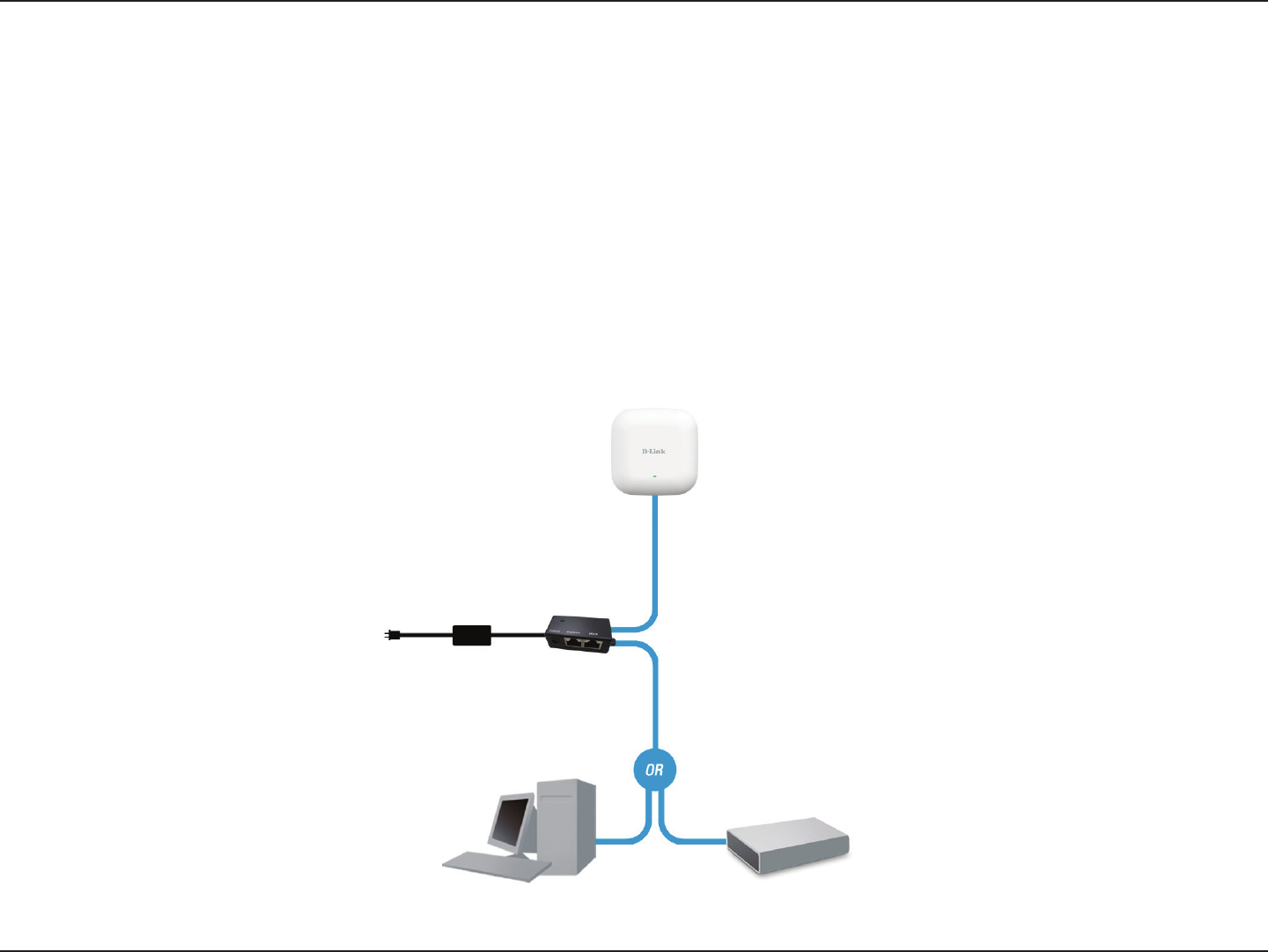
9D-Link DAP-2230 User Manual
Section 2 - Installation
Method 2 - Powered by PoE Injector
If you wish to power the DAP-2230 without a PoE switch, we suggest you use a PoE injector, such as a DPE-101GI.
1. Connect one end of an Ethernet cable into the DATA IN port on the PoE injector and the other end into a port on a switch,
router, or computer.
2. Connect one end of a dierent Ethernet cable into the P+DATA OUT port on the PoE injector and the other end into the LAN
(PoE) port on the DAP-2230 access point.
3. Connect the supplied power adapter to the POWER IN connector on the PoE Injector.
4. Plug the power adapter into a power outlet.
DAP-2230
PC Switch
Power
adapter PoE Base
Unit
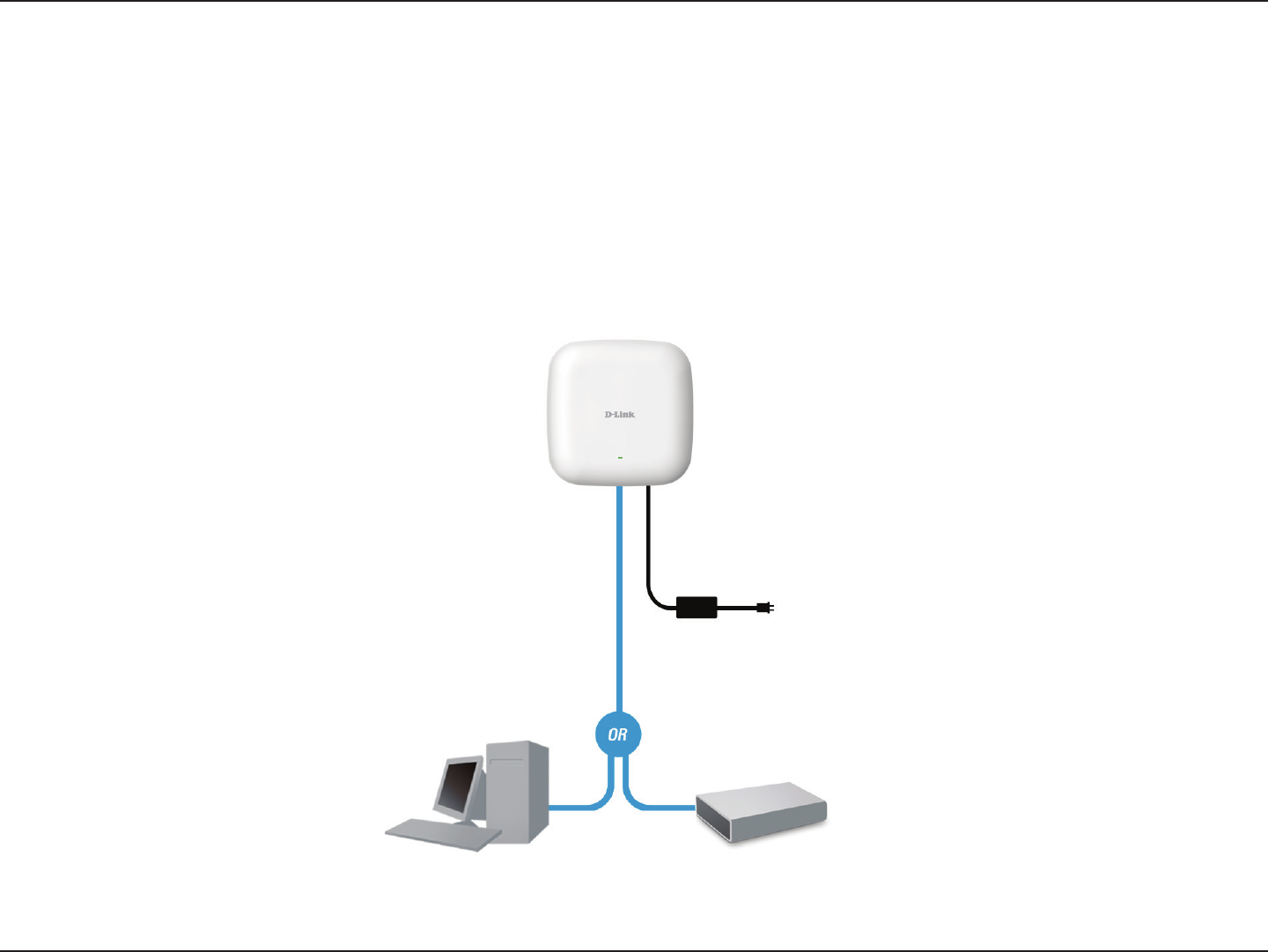
10D-Link DAP-2230 User Manual
Section 2 - Installation
A power adapter is included with some DAP-2230 models.
1. Connect an Ethernet cable from your network device to the LAN(PoE) port on the DAP-2230.
2. Connect the supplied power adapter to the DC IN connector on the DAP-2230.
3. Plug the power adapter into a power outlet.
Method 3 - DC Adapter
DAP-2230
Switch or Router
PC
Power Adapter

11D-Link DAP-2230 User Manual
Section 2 - Installation
Mounting the AP
Place the mounting bracket on a wall or ceiling and mark holes
where you will insert the screws with a marker. Drill holes in the
marked points and insert the plastic wall anchors.
Use the supplied screws to attach the mounting plate to the wall.
Reattach the DAP-2230 to the mounting bracket.

12D-Link DAP-2230 User Manual
Section 2 - Installation
Wireless Installation Considerations
The D-Link DAP-2230 Wireless N PoE Access Point lets you access your network using a wireless connection from virtually
anywhere within the operating range of your wireless network. Keep in mind, however, that the number, thickness and location
of walls, ceilings, or other objects that the wireless signals must pass through, may limit the range. Typical ranges vary depending
on the types of materials and background RF (radio frequency) noise in your home or business. The key to maximizing wireless
range is to follow these basic guidelines:
1. Keep the number of walls and ceilings between the D-Link access point and other network devices to a minimum.
Each wall or ceiling can reduce your adapter’s range from 3-90 feet (1-30 meters). Position your devices so that
the number of walls or ceilings is minimized.
2. Be aware of the direct line between network devices. A wall that is 1.5 feet thick (.5 meters), at a 45-degree
angle appears to be almost 3 feet (1 meter) thick. At a 2-degree angle it looks over 42 feet (14 meters) thick!
Position devices so that the signal will travel straight through a wall or ceiling (instead of at an angle) for better
reception.
3. Building materials make a dierence. A solid metal door or aluminum studs may have a negative eect on
range. Try to position access points, wireless access points, and computers so that the signal passes through
drywall or open doorways. Materials and objects such as glass, steel, metal, walls with insulation, water (sh
tanks), mirrors, le cabinets, brick, and concrete will degrade your wireless signal.
4. Keep your product away (at least 3-6 feet or 1-2 meters) from electrical devices or appliances that generate RF
noise.
5. If you are using 2.4 Ghz cordless phones or X-10 (wireless products such as ceiling fans, lights, and home security
systems), your wireless connection may degrade dramatically or drop completely. Make sure your 2.4 Hz phone
base is as far away from your wireless devices as possible. The base transmits a signal even if the phone is not
in use.

13D-Link DAP-2230 User Manual
Section 2 - Installation
Four Operational Modes
Operation Mode
(Only supports 1 mode at a time)
Function
Access Point (AP) Create a wireless LAN
WDS with AP Wirelessly connect multiple networks
while still functioning as a wireless AP
WDS Wirelessly connect multiple networks
Wireless Client AP acts as a wireless network adapter for
your Ethernet-enabled device

14D-Link DAP-2230 User Manual
Section 3 - Conguration
Conguration
This section will show you how to congure your new D-Link Wireless N PoE Access Point using the web-based conguration
utility.
Web-based Conguration Utility
If you wish to change the default settings or optimise the
performance of the DAP-2230, you may use the web-
based conguration utility.
To access the conguration utility, open a web browser
such as Internet Explorer and enter http://192.168.0.50
Type admin and then enter your password. Leave the
password blank by default.
If you get a Page Cannot be Displayed error, please refer
to “Troubleshooting” on page 104 for assistance.
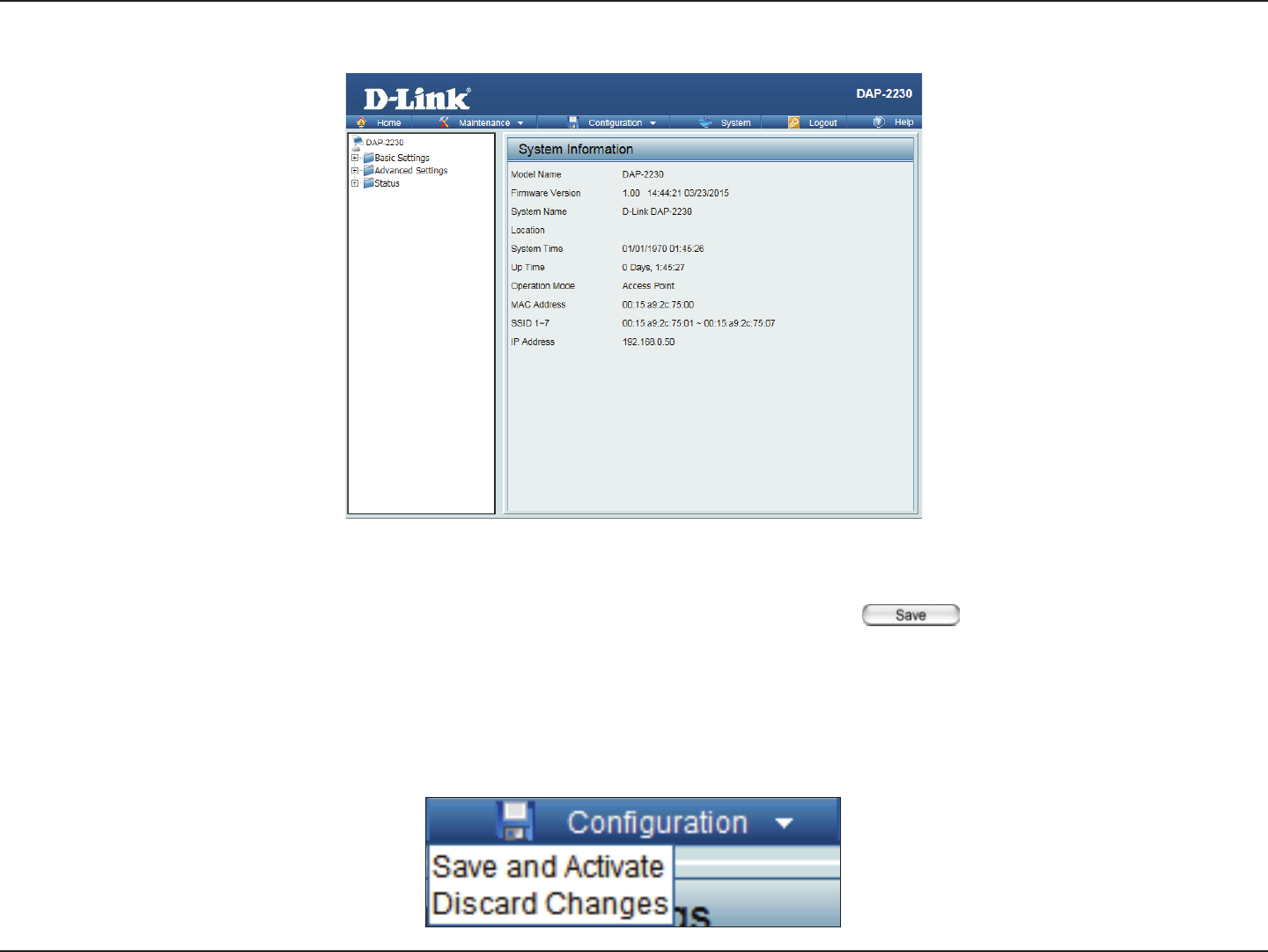
15D-Link DAP-2230 User Manual
Section 3 - Conguration
After successfully logging into the DAP-2230, the following screen will appear:
When making changes on most of the conguration screens in this section, use the button at the bottom of each
screen to save (not activate) your conguration changes.
You may change settings to multiple pages before activating. Once you are nished, click the Conguration button located
at the top of the page and then click Save and Activate.
Save and Activate Settings
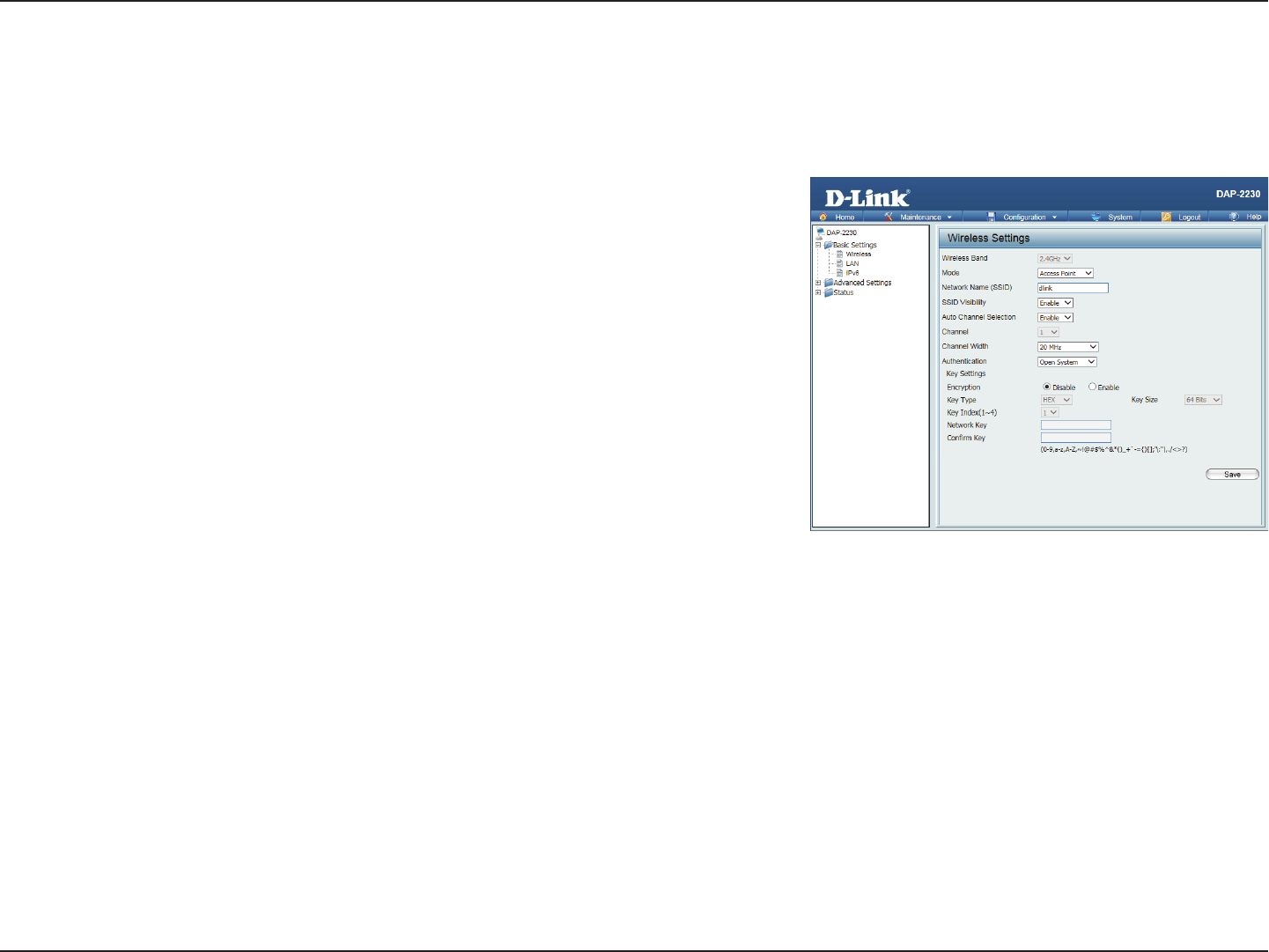
16D-Link DAP-2230 User Manual
Section 3 - Conguration
Basic Settings
Wireless
Access Point mode
Wireless
Band:
Select 2.4 Ghz from the drop-down menu.
Mode: Select Access Point from the drop-down menu.
The other three choices are WDS with AP, WDS, and wireless Client.
Network
Name
(SSID):
Service Set Identier (SSID) is the name designated for a specic wireless
local area network (WLAN). The SSID’s factory default setting is dlink. The
SSID can be easily changed to connect to an existing wireless network or
to establish a new wireless network. The SSID can be up to 32 characters
and is case-sensitive.
SSID
Visibility:
Enable or Disable SSID visibility. Enabling this feature broadcasts the SSID
across the network, thus making it visible to all network users. This feature
is enabled by default.
Auto
Channel
Selection:
Enabling this feature automatically selects the channel that provides the
best wireless performance. Enable is set by default. The channel selection
process only occurs when the AP is booting up.
Channel: All devices on the network must share the same channel. To change the
channel, rst toggle the Auto Channel Selection setting to Disable, and then
use the drop-down menu to make the desired selection.
Note: The wireless adapters will automatically scan and match the wireless
settings.
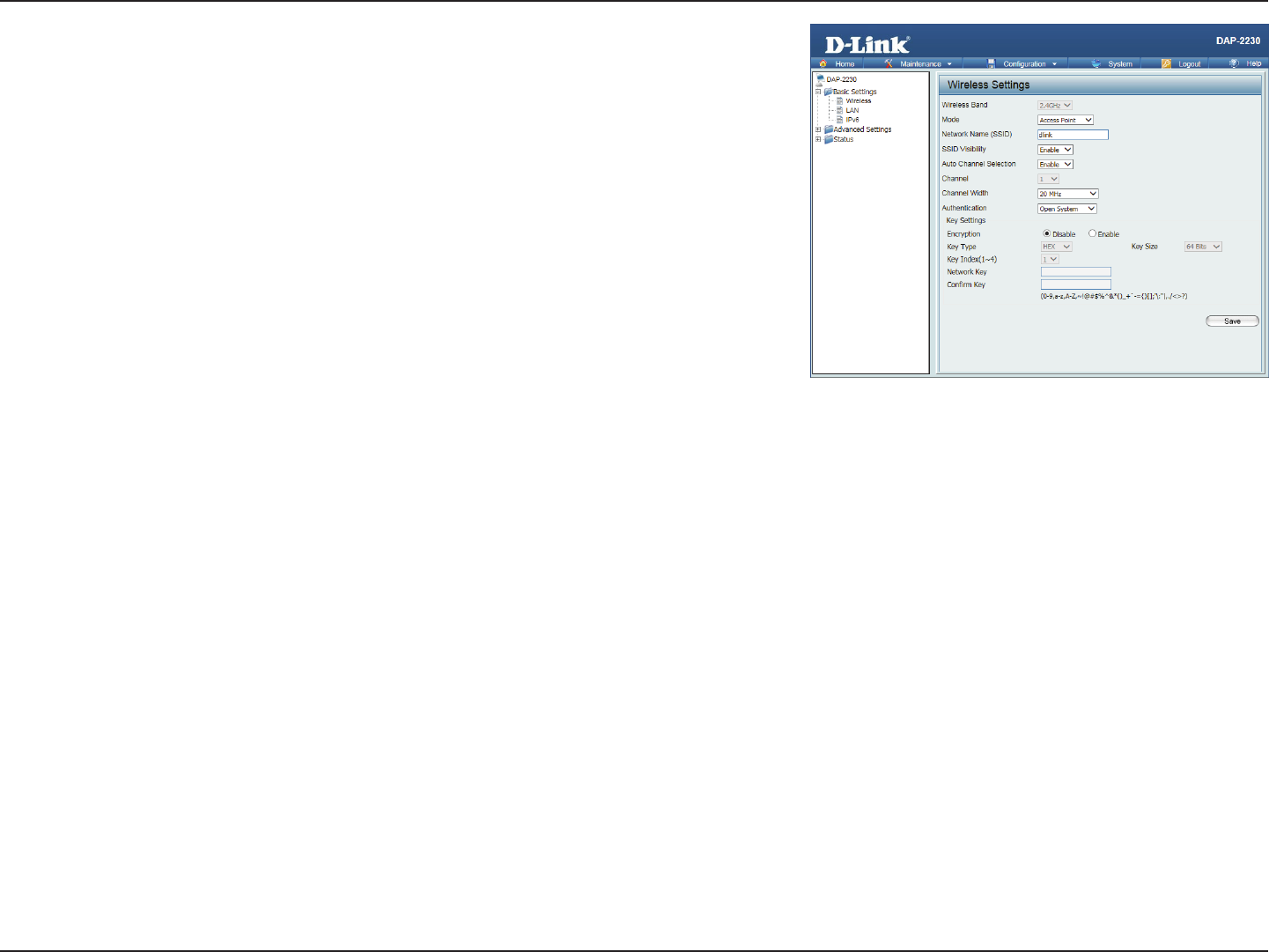
17D-Link DAP-2230 User Manual
Section 3 - Conguration
Channel
Width:
Allows you to select the channel width you would like to operate in. Select
20 MHz if you are not using any 802.11n wireless clients. Auto 20/40 MHz
allows you to connect to both 802.11n and 802.11b/g wireless devices on
your network.
Authentication: Use the drop-down menu to choose Open System, Shared Key, WPA-
Personal, WPA-Enterprise, or 802.11x.
Select Open System to communicate the key across the network.
Select Shared Key to limit communication to only those devices that share
the same WEP settings. If multi-SSID is enabled, this option is not available.
Select WPA-Personal to secure your network using a password and dynamic
key changes. No RADIUS server is required.
Select WPA-Enterprise to secure your network with the inclusion of a RADIUS
server.
Select 802.1x to secure your network using 802.1x authentication.
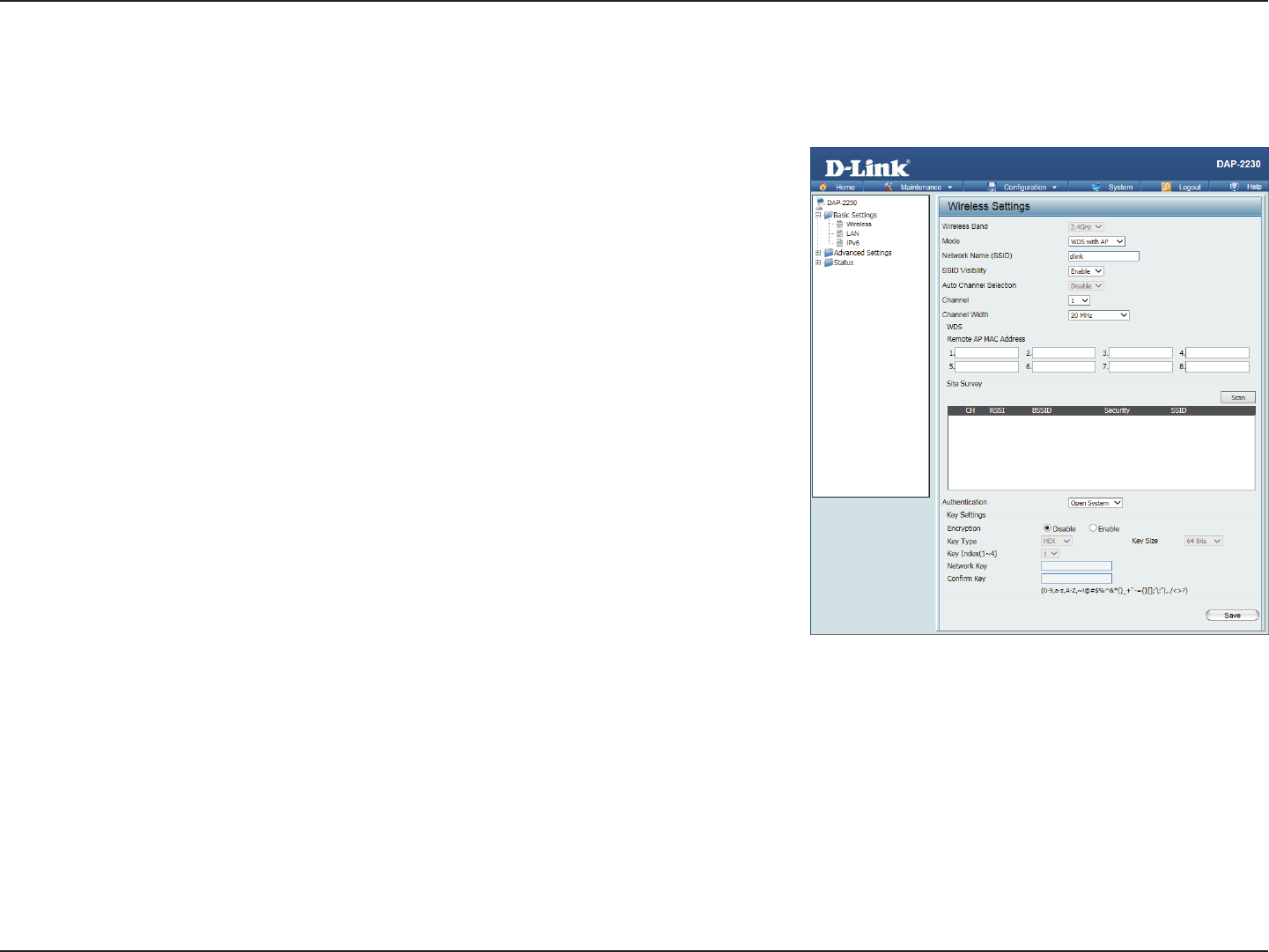
18D-Link DAP-2230 User Manual
Section 3 - Conguration
WDS with AP mode
In WDS with AP mode, the DAP-2230 wirelessly connects multiple networks while still functioning as a wireless AP.
Wireless
Band:
Select 2.4 Ghz from the drop-down menu.
Mode: WDS with AP mode is selected from the drop-down menu.
The other three choices are Access Point, WDS, and wireless Client.
Network
Name
(SSID):
Service Set Identier (SSID) is the name designated for a specic wireless
local area network (WLAN). The SSID’s factory default setting is dlink. The
SSID can be easily changed to connect to an existing wireless network or to
establish a new wireless network.
SSID
Visibility:
Enable or Disable SSID visibility. Enabling this feature broadcasts the SSID
across the network, thus making it visible to all network users.
Auto
Channel
Selection:
Enabling this feature automatically selects the channel that will provide the
best wireless performance. This feature is not supported in WDS with AP
mode. The channel selection process only occurs when the AP is booting up.
Channel: To change the channel, use the drop-down menu to make the desired
selection. (Note: The wireless adapters will automatically scan and match
the wireless settings.)
Channel
Width:
Indicates whether the device is capable of 20 MHz operation only or both
20 MHz and 40 MHz operation.
Remote AP
MAC Address:
Enter the MAC addresses of the APs on your network that will serve as bridges
to wirelessly connect multiple networks.
Site Survey: Click on the Scan button to search for available wireless networks, then click
on the available network that you want to connect with.
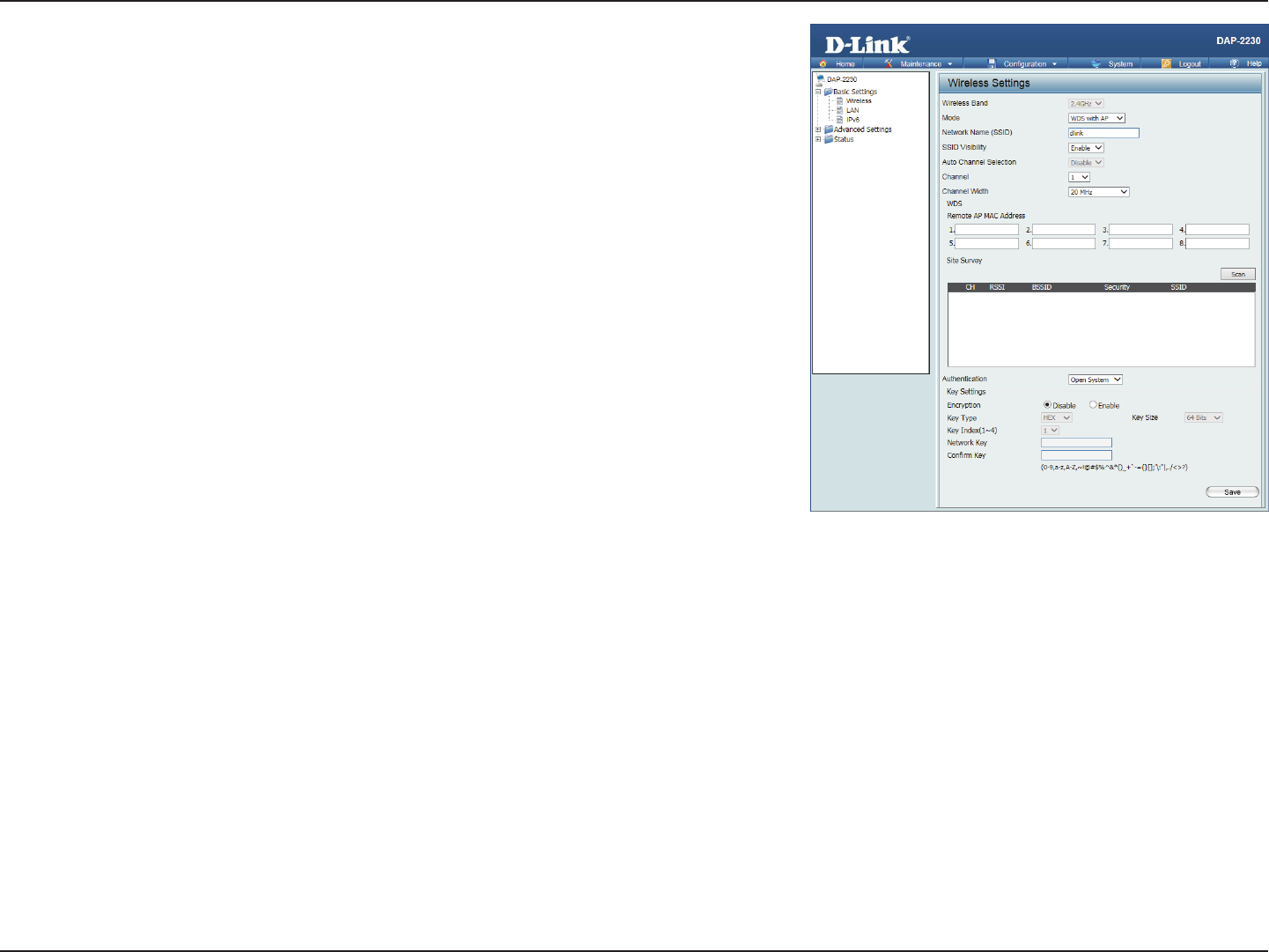
19D-Link DAP-2230 User Manual
Section 3 - Conguration
Authentication: Use the drop-down menu to choose Open System or WPA-Personal.
Select Open System to communicate the key across the network.
Select WPA-Personal to secure your network using a password and dynamic
key changes. No RADIUS server is required.
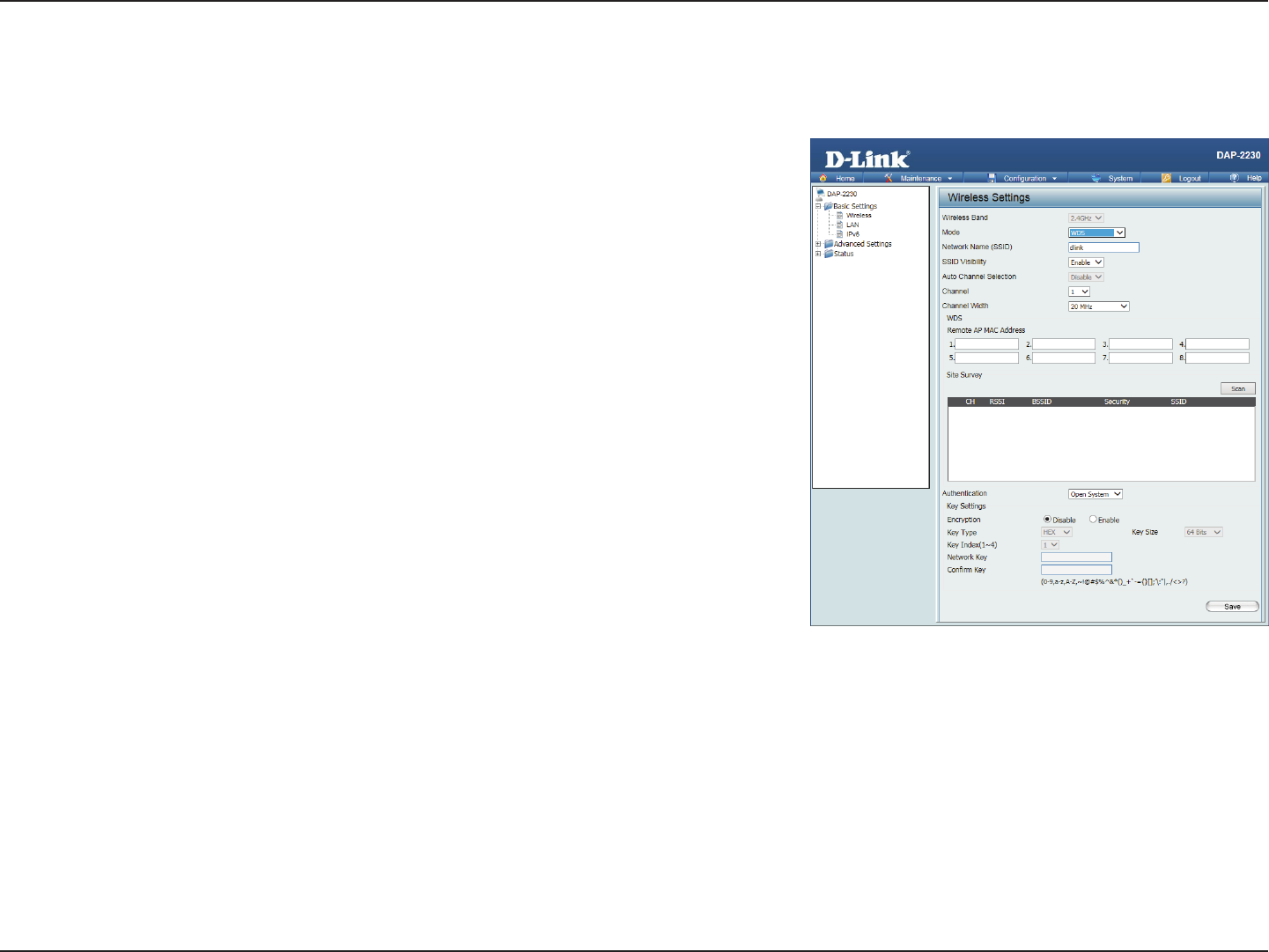
20D-Link DAP-2230 User Manual
Section 3 - Conguration
WDS mode
In WDS mode, the DAP-2230 wirelessly connects multiple networks, without functioning as a wireless AP.
Wireless
Band:
Select 2.4 Ghz from the drop-down menu.
Mode: WDS is selected from the drop-down menu.
The other three choices are Access Point, WDS with AP, and wireless Client.
Network
Name
(SSID):
Service Set Identier (SSID) is the name designated for a specic wireless
local area network (WLAN). The SSID’s factory default setting is dlink. The
SSID can be easily changed to connect to an existing wireless network or to
establish a new wireless network.
SSID
Visibility:
Enable or Disable SSID visibility. Enabling this feature broadcasts the SSID
across the network, thus making it visible to all network users.
Auto
Channel
Selection:
Enabling this feature automatically selects the channel that will provide the
best wireless performance. This feature is not supported in WDS with AP
mode. The channel selection process only occurs when the AP is booting up.
Channel: To change the channel, use the drop-down menu to make the desired
selection. (Note: The wireless adapters will automatically scan and match
the wireless settings.)
Channel
Width:
Indicates whether the device is capable of 20 MHz operation only or both
20 MHz and 40 MHz operation.
Remote
AP MAC
Address:
Enter the MAC addresses of the APs on your network that will serve as bridges
to wirelessly connect multiple networks.
Site Survey: Click on the Scan button to search for available wireless networks, then click
on the available network that you want to connect with.
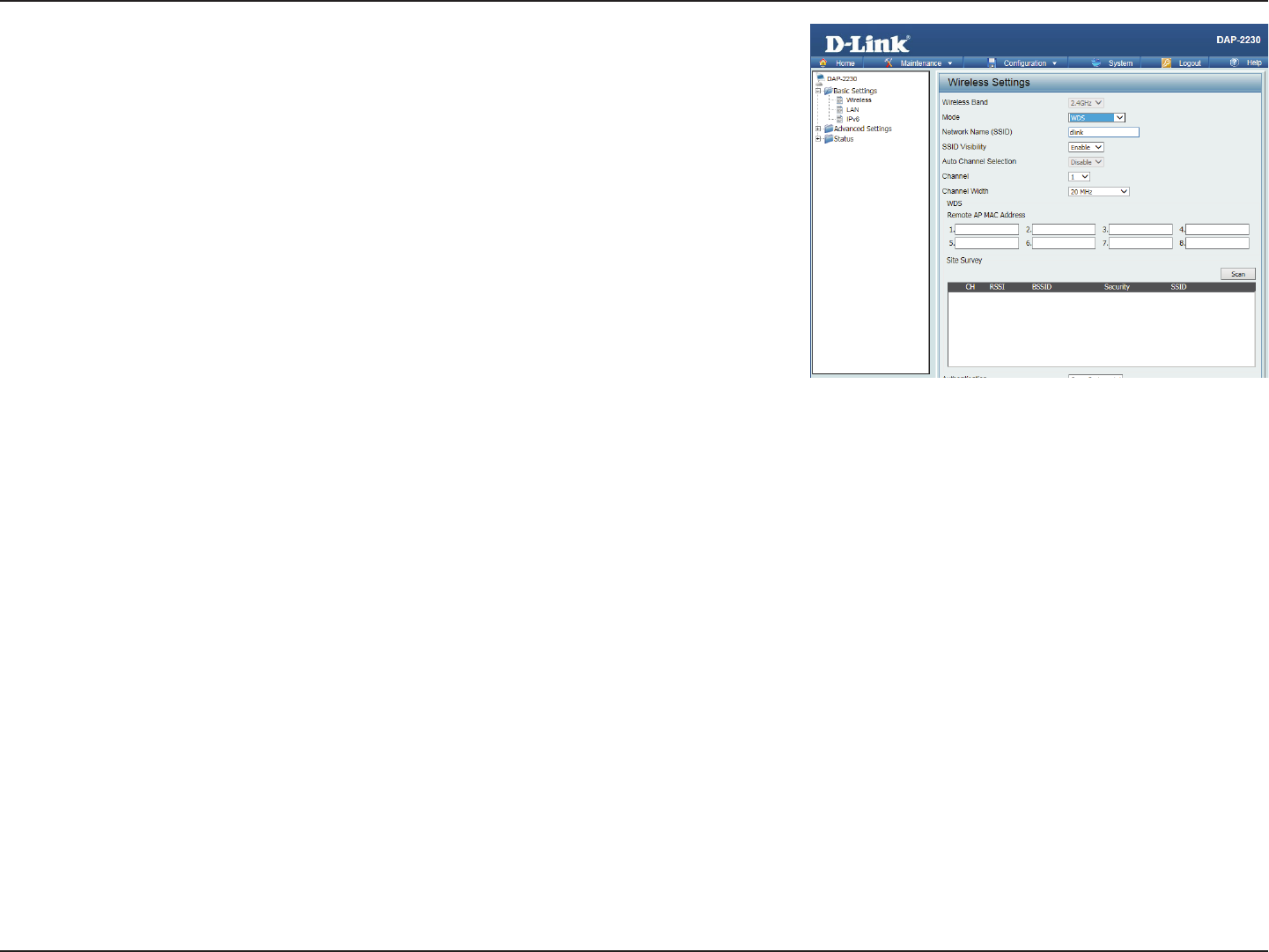
21D-Link DAP-2230 User Manual
Section 3 - Conguration
Authentication: Use the drop-down menu to choose Open System or WPA-Personal.
Select Open System to communicate the key across the network.
Select WPA-Personal to secure your network using a password and dynamic
key changes. No RADIUS server is required.
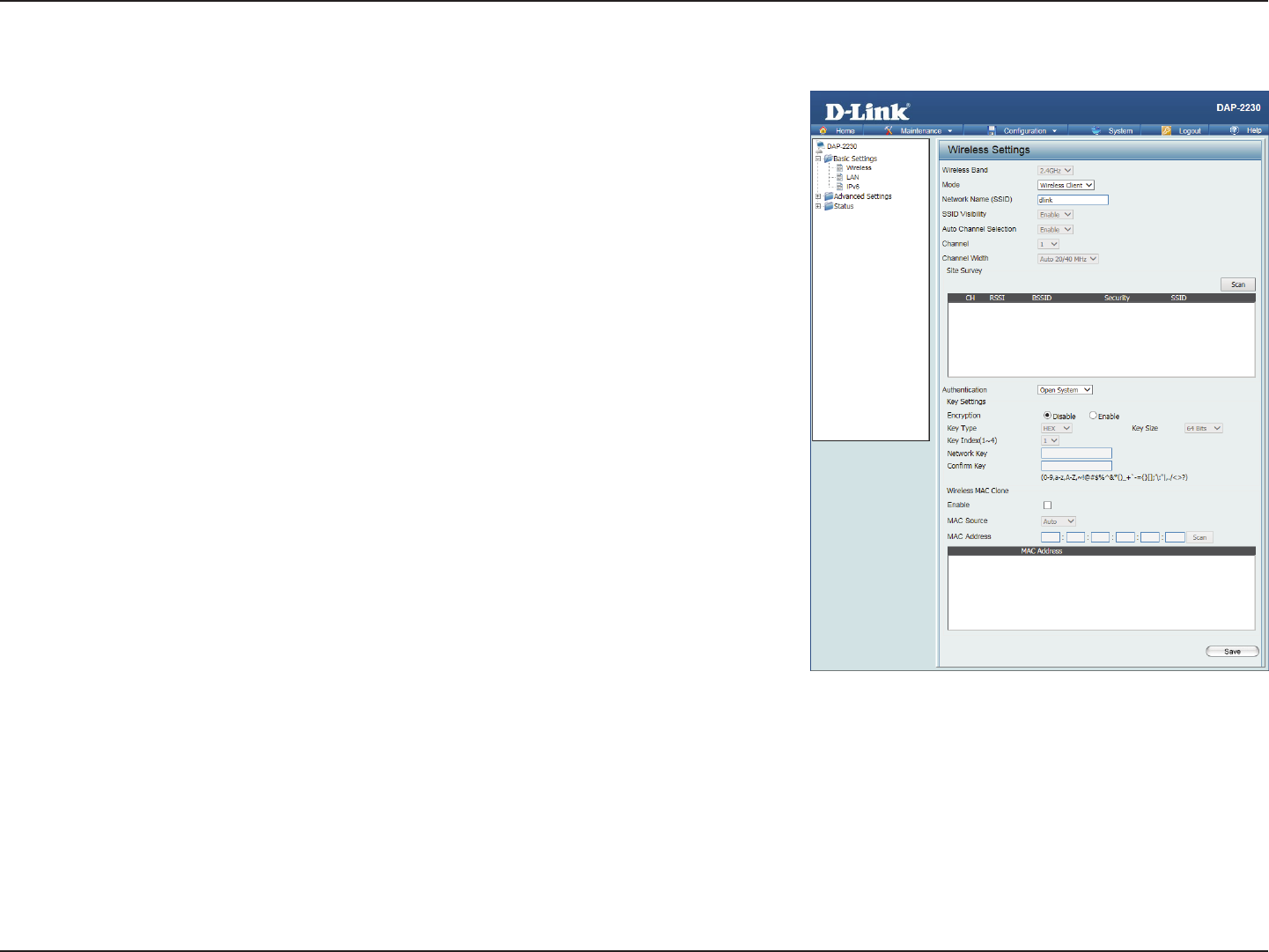
22D-Link DAP-2230 User Manual
Section 3 - Conguration
Wireless Client mode
Wireless
Band:
Select 2.4 Ghz from the drop-down menu.
Mode: Wireless Client is selected from the drop-down menu.
The other three choices are Access Point, WDS with AP, and WDS.
Network
Name
(SSID):
Service Set Identier (SSID) is the name designated for a specic wireless
local area network (WLAN). The SSID’s factory default setting is dlink. The
SSID can be easily changed to connect to an existing wireless network or to
establish a new wireless network.
SSID
Visibility:
Enable or Disable SSID visibility. Enabling this feature broadcasts the SSID
across the network, thus making it visible to all network users. Disabling
SSID is not supported in Wireless Client mode.
Auto
Channel
Selection:
Enabling this feature automatically selects the channel that will provide
the best wireless performance. This feature is automatically enabled in
Wireless Client mode. The channel selection process only occurs when the
AP is booting up.
Channel: To change the channel, use the drop-down menu to make the desired
selection. (Note: The wireless adapters will automatically scan and match
the wireless settings.)
Channel
Width:
Indicates whether the device is capable of 20 MHz operation only or both
20 MHz and 40 MHz operation.
Click on the Scan button to search for available wireless networks, then
click on the available network that you want to connect with.
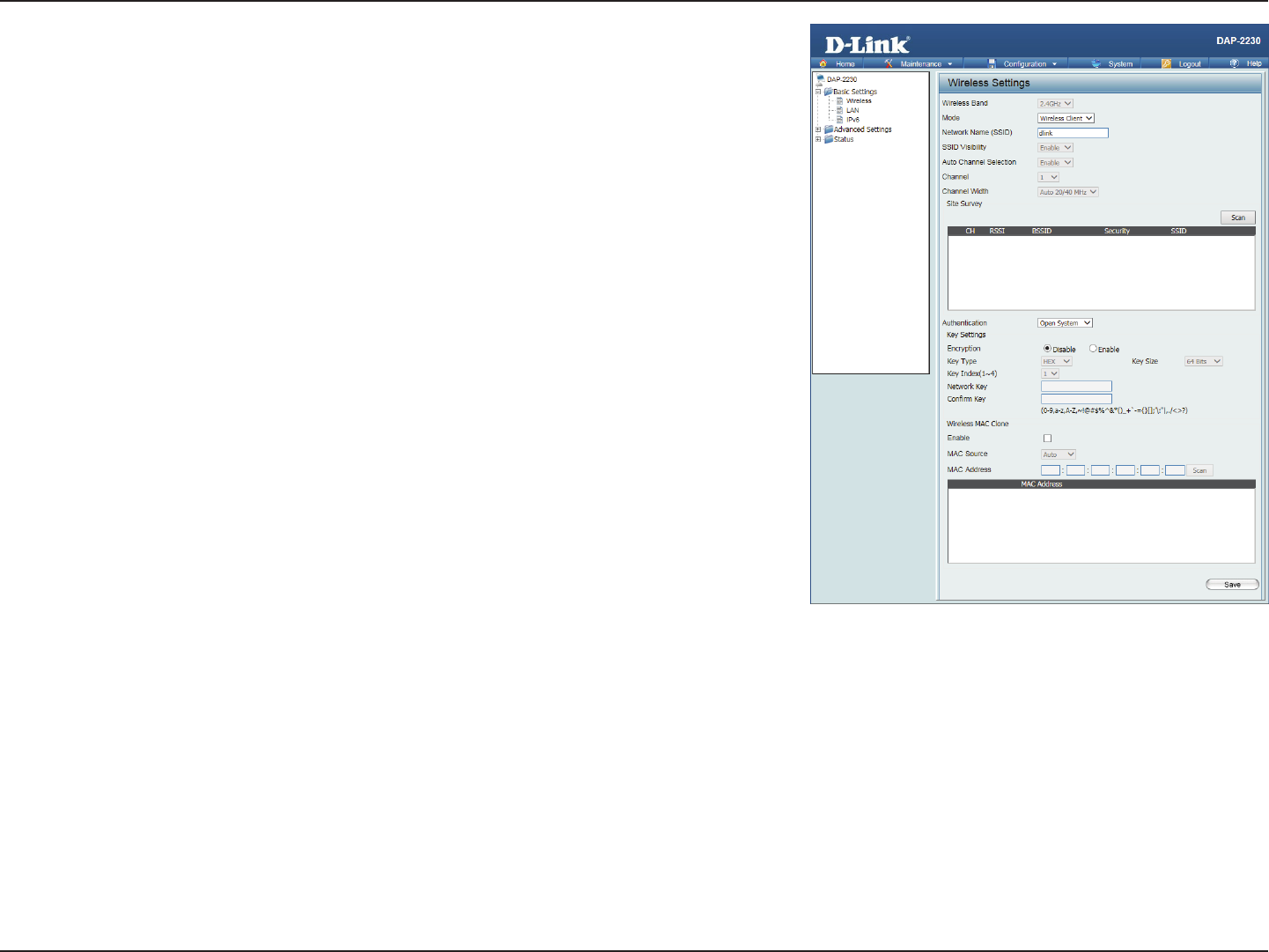
23D-Link DAP-2230 User Manual
Section 3 - Conguration
Authentication: Use the drop-down menu to choose Open System or WPA-Personal.
Select Open System to communicate the key across the network.
Select WPA-Personal to secure your network using a password and
dynamic key changes. No RADIUS server is required.
Wireless Mac
Clone Enable:
Check to enable clone MAC. This feature will allow you to change the MAC
address of the access point to the MAC address of a client.
MAC Source: Select the MAC source from the drop-down menu.
MAC Address: Enter the MAC address that you would like to assign to the access point.
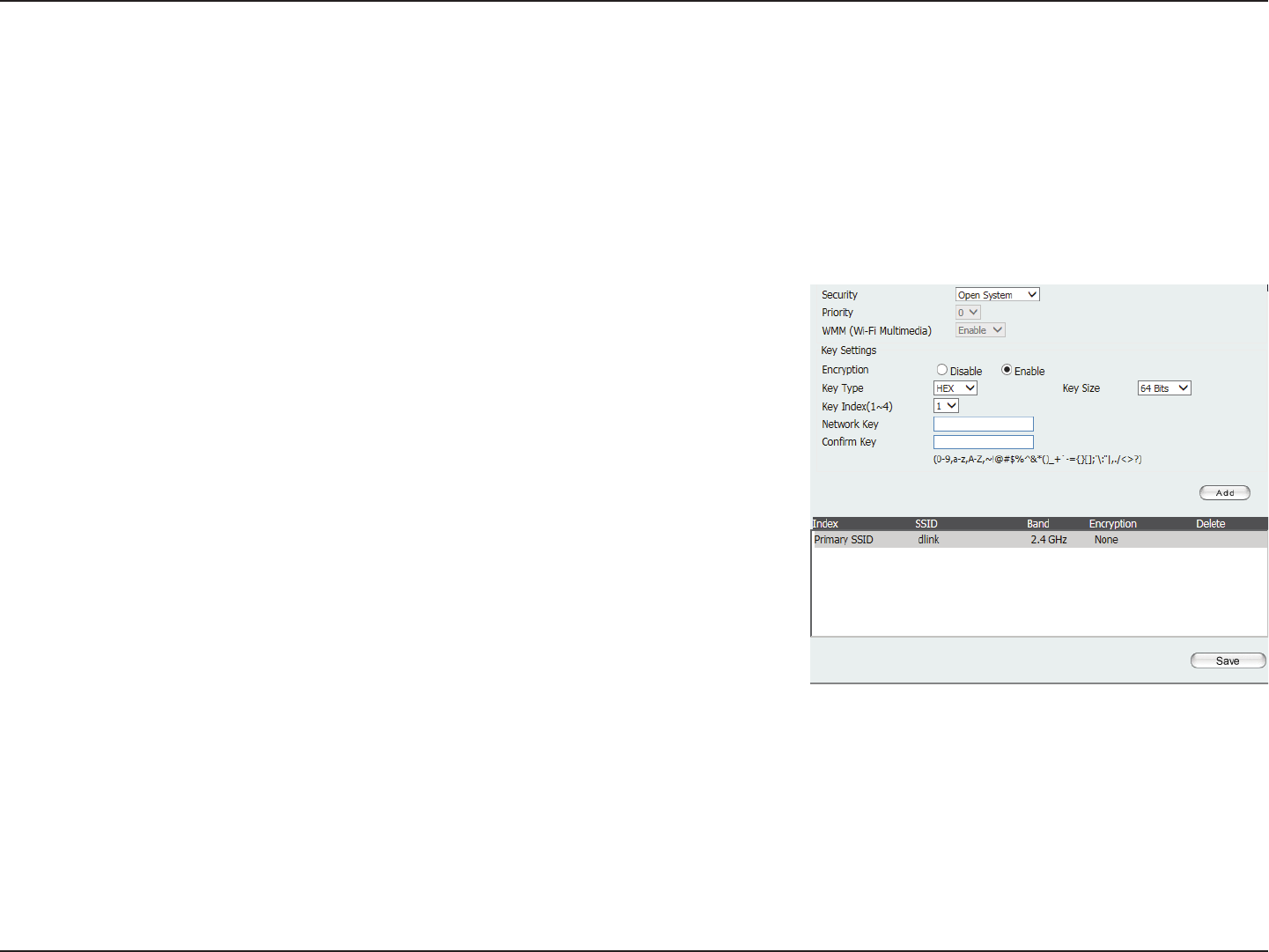
24D-Link DAP-2230 User Manual
Section 3 - Conguration
Open System/Shared Key Authentication
Authentication Types
Each of the wireless modes on the DAP-2230 support dierent types of wireless encryption security standards. Not every mode
supports all types of encryption.
All wireless modes on the DAP-2230 support Open System/Shared Key Authentication.
Encryption Use the radio button to disable or enable encryption.
Key Type: Select HEX* or ASCII**.
Key Size: Select 64 Bits or 128 Bits.
Key Index
(1-4):
Select the 1st through the 4th key to be the active key:
Key: Input up to four keys for encryption. You will select one of these keys in
the Key Index drop-down menu.
*Hexadecimal (HEX) digits consist of the numbers 0-9 and the letters A-F.
**ASCII (American Standard Code for Information Interchange) is a code that
represents English letters using numbers ranging from 0-127.

25D-Link DAP-2230 User Manual
Section 3 - Conguration
WPA/WPA2-Personal Authentication
WPA Mode: When WPA-Personal is selected for Authentication type, you must also select
a WPA mode from the drop-down menu: AUTO (WPA or WPA2), WPA2 Only,
or WPA Only. WPA and WPA2 use dierent algorithms. AUTO (WPA or WPA2)
allows you to use both WPA and WPA2.
Cipher Type: When you select WPA-Personal, you must also select AUTO, AES, or TKIP
from the drop-down menu.
Group Key
Update:
Select the interval during which the group key will be valid. The default value
of 3600 is recommended.
Select Manual to enter your key (PassPhrase).
You can select Periodical Key Change to have the access point automatically
change your PassPhrase.
Periodical
Key Change:
Enter the Activate From time and the time in hours to change the key.
PassPhrase: When you select WPA-Personal, please enter a PassPhrase in the
corresponding eld.
Conrm
PassPhrase:
Type the passphrase again to guard against typos.
WPA/WPA2 Personal Authentication can be enabled for Access Point, WDS with AP, WDS, and Wireless Client modes.
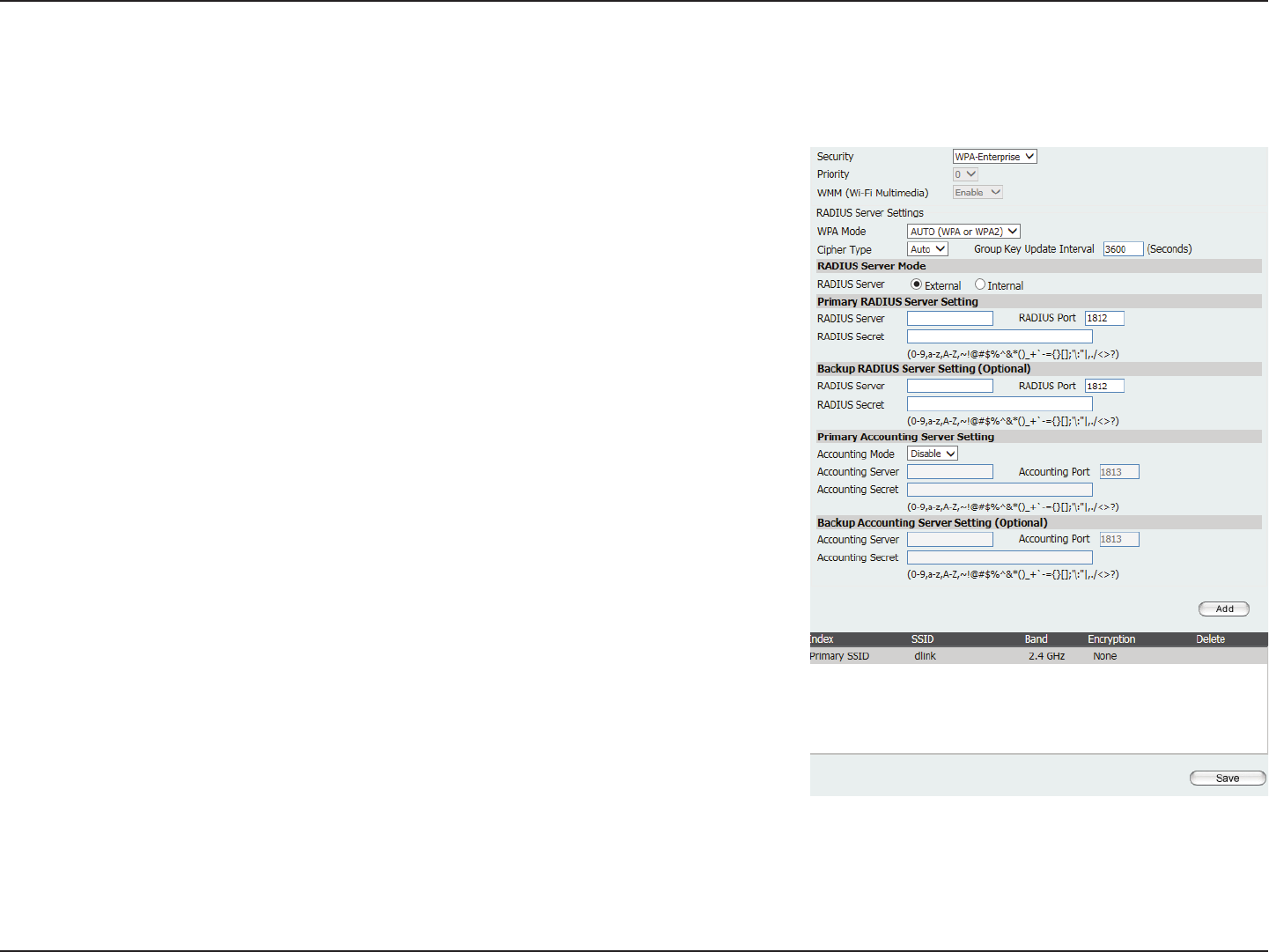
26D-Link DAP-2230 User Manual
Section 3 - Conguration
WPA/WPA2-Enterprise Authentication
WPA Mode: When WPA-Enterprise is selected, you must also select a WPA mode from
the drop-down menu: AUTO (WPA or WPA2), WPA2 Only, or WPA Only.
WPA and WPA2 use dierent algorithms. AUTO (WPA or WPA2) allows you
to use both WPA and WPA2.
Cipher
Type:
When WPA-Enterprise is selected, you must also select a cipher type from
the drop-down menu: Auto, AES, or TKIP.
Group Key
Update
Interval:
Select the interval during which the group key will be valid. The recommended
value is 3600. A lower interval may reduce data transfer rates.
Network
Access
Protection:
Enable or disable Microsoft Network Access Protection.
RADIUS
Server:
Enter the IP address of the RADIUS server.
RADIUS
Port:
Enter the RADIUS port.
RADIUS
Secret:
Enter the RADIUS secret.
WPA/WPA2 Enterprise Authentication can only be enabled for Access Point mode.
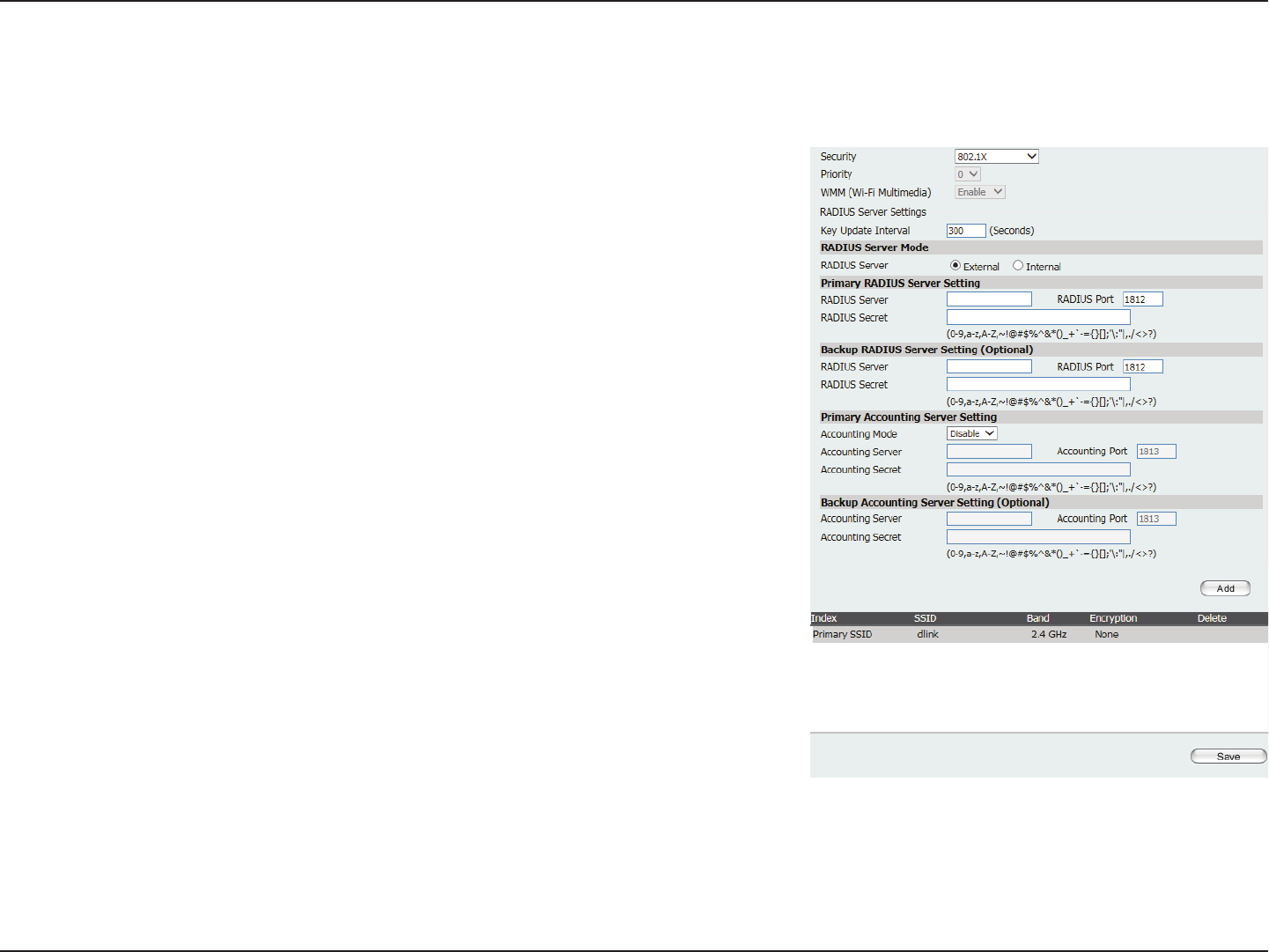
27D-Link DAP-2230 User Manual
Section 3 - Conguration
802.1x Authentication
Key Update
Interval:
Select the interval during which the group key will be valid (300 is the
recommended value). A lower interval may reduce data transfer rates.
RADIUS
Server:
Enter the IP address of the RADIUS server.
RADIUS
Port:
Enter the RADIUS port.
RADIUS
Secret:
Enter the RADIUS secret.
802.1x Authentication can only be enabled for Access Point mode.
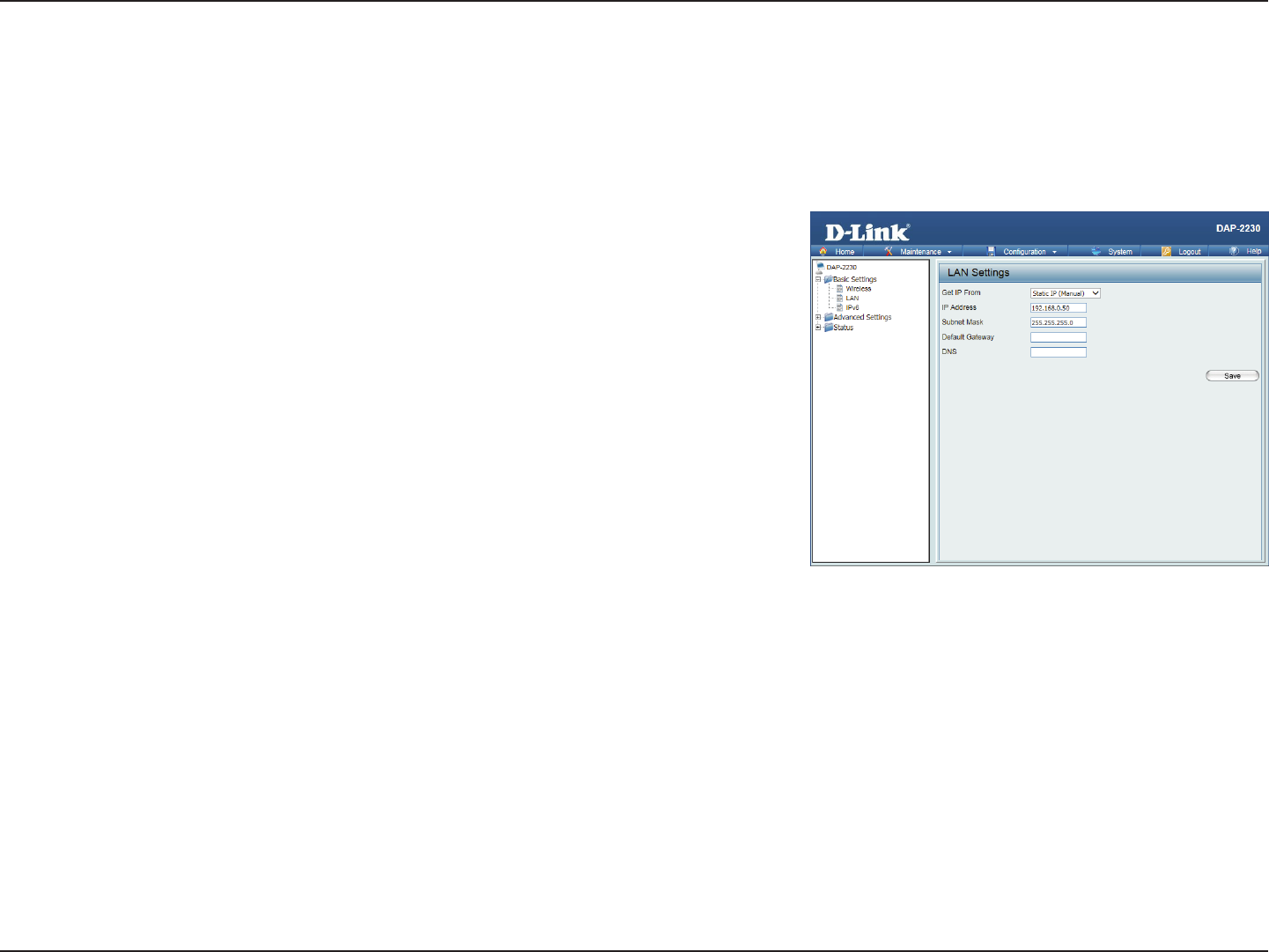
28D-Link DAP-2230 User Manual
Section 3 - Conguration
LAN
LAN is short for Local Area Network. This is considered your internal network. These are the IP settings of the LAN interface for
the DAP-2230. These settings may be referred to as private settings. You may change the LAN IP address if needed. The LAN IP
address is private to your internal network and cannot be seen on the Internet.
Get IP From: Static IP (Manual) is chosen here. Choose this option if you do not have a
DHCP server in your network, or if you wish to assign a static IP address to
the DAP-2230. When Dynamic IP (DHCP) is selected, the other elds here
will be grayed out. Please allow about two minutes for the DHCP client to
be functional once this selection is made.
IP Address: The default IP address is 192.168.0.50. Assign a static IP address that is within
the IP address range of your network.
Subnet
Mask:
Enter the subnet mask. All devices in the network must share the same
subnet mask.
Default
Gateway:
Enter the IP address of the gateway in your network. If there is a gateway in
your network, please enter an IP address within the range of your network.
DNS: Enter the DNS IP address used here.
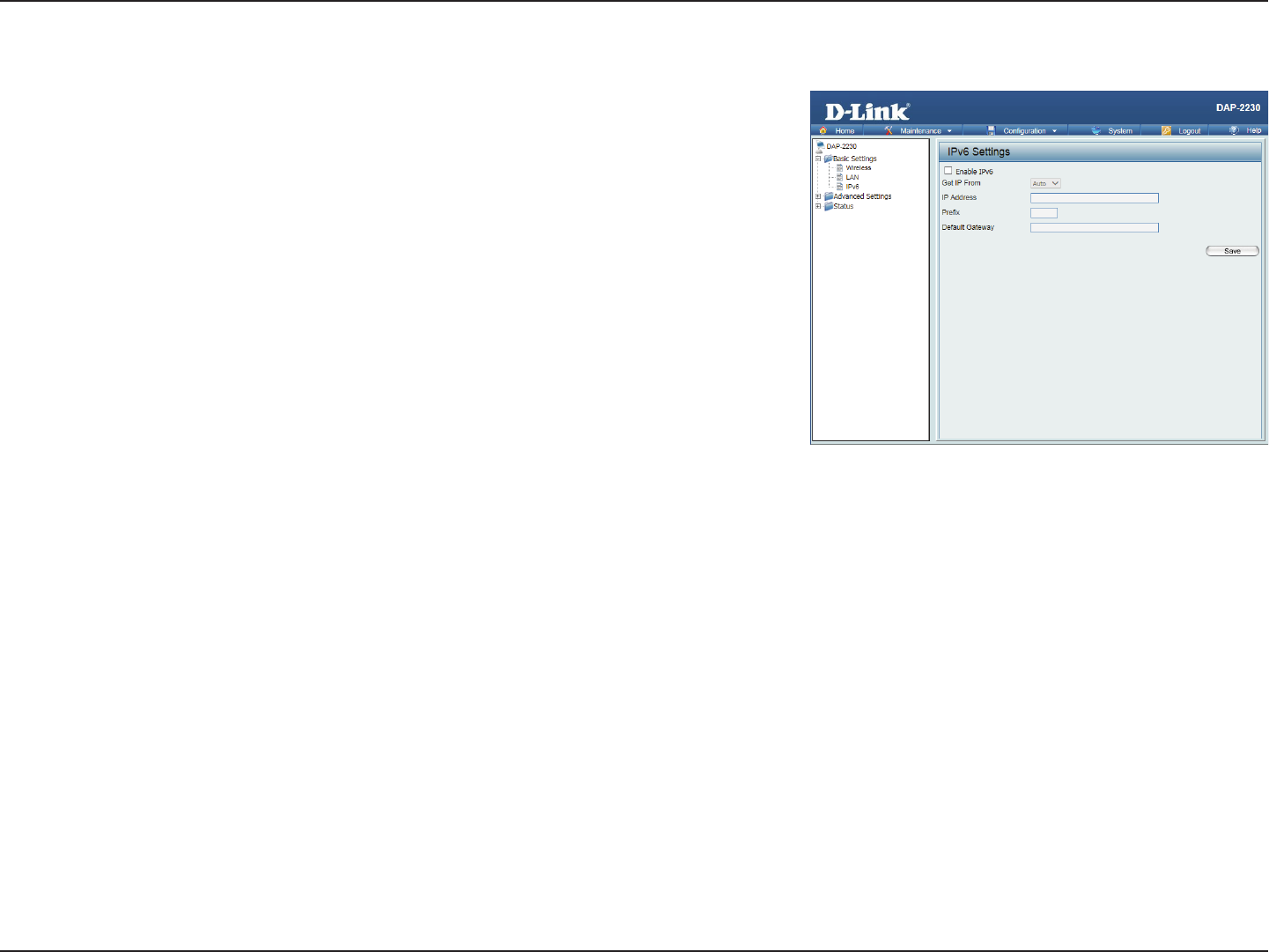
29D-Link DAP-2230 User Manual
Section 3 - Conguration
IPv6
Enable IPv6: Check to enable the IPv6.
Get IP From: Auto is the default option. The DAP-2230 will get an IPv6 address
automatically or use Static to set IPv6 address manually. When Auto is
selected, the other elds here will be grayed out.
IP Address: Enter the LAN IPv6 address used here.
Prex: Enter the LAN subnet prex length value used here.
Default
Gateway:
Enter the LAN default gateway IPv6 address used here.

30D-Link DAP-2230 User Manual
Section 3 - Conguration
Advanced Settings
Performance
*Maximum wireless signal rate derived from IEEE Standard 802.11n and 802.11g specications. Actual data throughput may vary. Network conditions and environmental factors,
including volume of network trac, building materials and construction, and network overhead can lower actual data throughout rate.
Wireless: Use the drop-down menu to turn the wireless function On or O.
Wireless
Mode:
The dierent combination of clients that can be supported include Mixed
802.11n, 802.11g and 802.11b, Mixed 802.11g and 802.11b and 802.11n
Only. Please note that when backwards compatibility is enabled for legacy
(802.11g/b) clients, degradation of 802.11n wireless performance is expected.
Data Rate*: Indicate the base transfer rate of wireless adapters on the wireless LAN.
The AP will adjust the base transfer rate depending on the base rate of the
connected device. If there are obstacles or interference, the AP will step down
the rate. This option is enabled in Mixed 802.11g and 802.11b mode. The
choices available are Best (Up to 54), 54, 48, 36, 24, 18, 12, 9, 6, 11, 5.5, 2 or 1.
Beacon
Interval (25-
500):
Beacons are packets sent by an access point to synchronize a
wireless network. Specify a value in milliseconds. The default (100) is
recommended. Setting a higher beacon interval can help to save the
power of wireless clients, while setting a lower one can help a wireless
client connect to an access point faster.
DTM
Interval
(1-15):
Select a Delivery Trac Indication Message setting between 1 and 15.
The default value is 1. DTIM is a countdown informing clients of the next
window for listening to broadcast and multicast messages.
Transmit
Power:
This setting determines the power level of the wireless transmission.
Transmitting power can be adjusted to eliminate overlapping of wireless
area coverage between two access points where interference is a major
concern. For example, if wireless coverage is intended for half of the area,
then select 50% as the option. Use the drop-down menu to select 100%,
50%, 25%, or 12.5%.
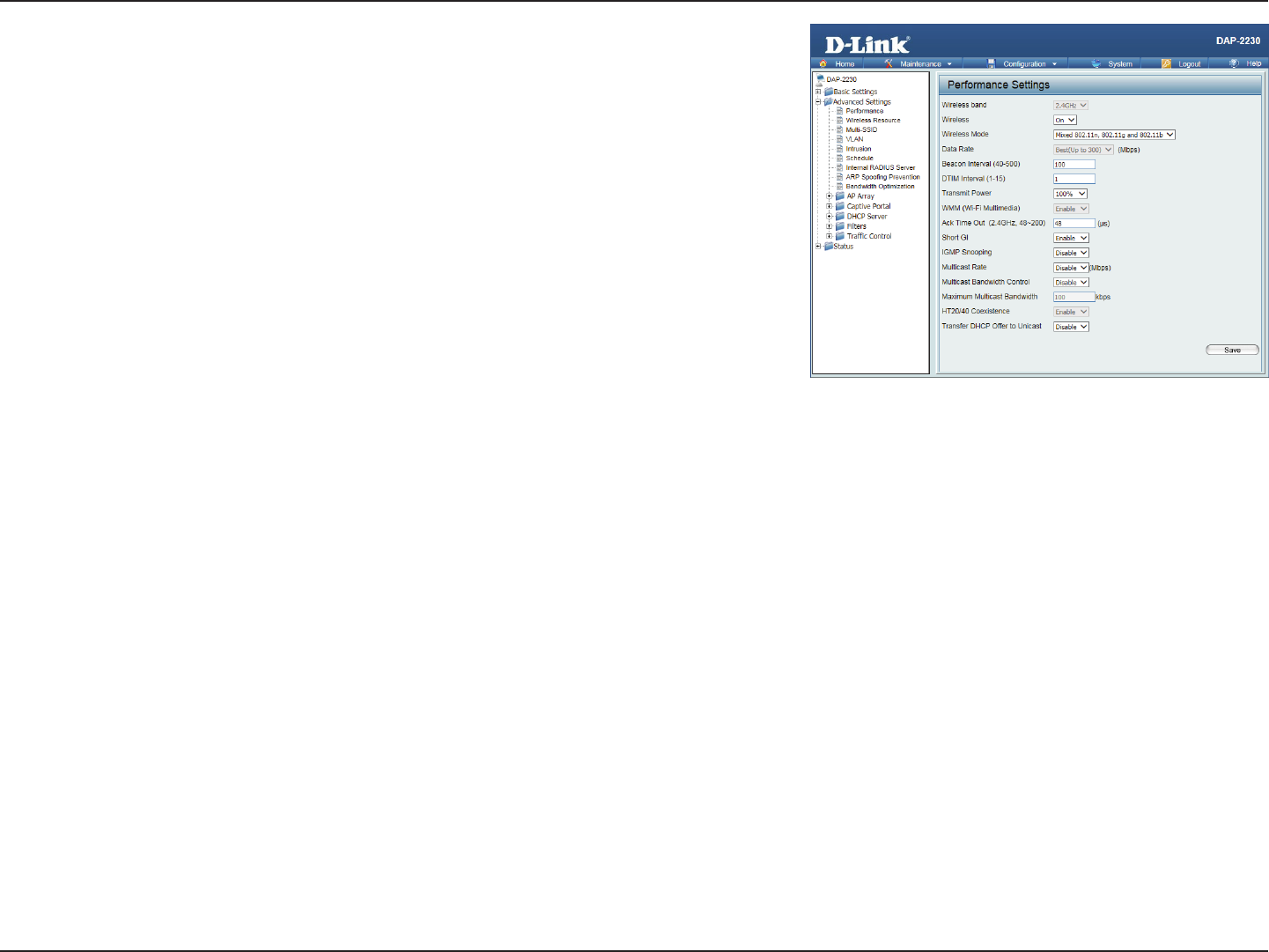
31D-Link DAP-2230 User Manual
Section 3 - Conguration
WMM (Wi-Fi
Multimedia):
WMM stands for Wi-Fi Multimedia. Enabling this feature will improve the
user experience for audio and video applications over a Wi-Fi network.
Ack Time Out
(2.4 GHZ,
64~200):
To eectively optimize throughput over long distance links, enter a value
for Acknowledgement Time Out from 64 to 200 microseconds in the 2.4
GHz in the eld provided.
Short GI: Select Enable or Disable. Enabling a short guard interval can increase
throughput. However, be aware that it can also increase the error rate
in some installations due to increased sensitivity to radio-frequency
installations.
IGMP
Snooping:
Select Enable or Disable. Internet Group Management Protocol allows
the AP to recognize IGMP queries and reports sent between routers and
an IGMP host (wireless STA). When IGMP snooping is enabled, the AP
will forward multicast packets to an IGMP host based on IGMP messages
passing through the AP.
Multicast Rate: Select the multicast rate for 2.4G band.
Multicast
Bandwidth
Control:
Adjust the multicast packet data rate here. The multicast rate is supported
in AP mode and WDS with AP mode, including Multi-SSIDs.
Maximum
Multicast
Bandwidth :
Set the multicast packets maximum bandwidth pass through rate from
the Ethernet interface to the Access Point.
HT20/40
Coexistence:
Enable this option to reduce interference from other wireless networks in
your area. If the channel width is operating at 40 MHz and there is another
wireless network’s channel over-lapping and causing interference, the
Access Point will automatically change to 20 MHz.
Transfer
DHCP Oer
to Unicast :
Enable to transfer the DHCP Oer to Unicast from LAN to WLAN, it is
recommended to enable this function if the number of stations is larger
than 30.
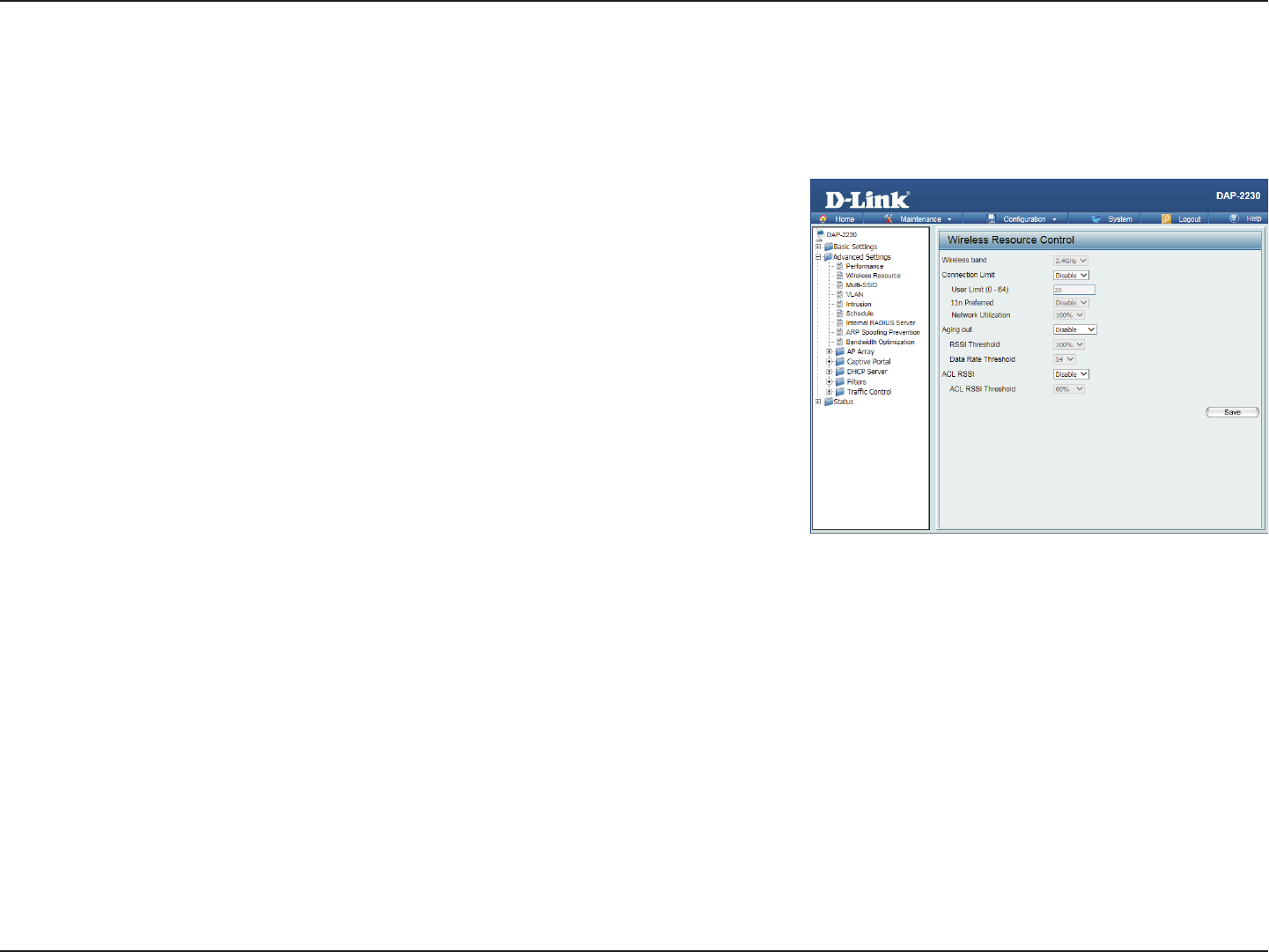
32D-Link DAP-2230 User Manual
Section 3 - Conguration
Wireless Resource Control
The Wireless Resource Control window is used to congure the wireless connection settings so that devices can detect and
connect to the Access Point with the strongest signal.
Wireless band: Select 2.4 Ghz.
Connection
Limit:
Select Enable or Disable. This is an option for load balancing. This de-
termines whether to limit the number of users accessing this device. The
exact number is entered in the User Limit eld below. This feature allows
the user to share the wireless network trac and the client using multiple
APs. If this function is enabled and when the number of users exceeds this
value, or the network utilization of this AP exceeds the percentage that
has been specied, the DAP-2230 will not allow clients to associate with
the AP.
User Limit: Set the maximum amount of users that are allowed access (zero to 64 us-
ers) to the device using the specied wireless band. The default setting is
20.
11n
Preferred:
Use the drop-down menu to Enable the 11n Preferred function. The wire-
less clients with 802.11n protocol will have higher priority to connect to
the device.
Network
Utilization:
Set the maximum utilization of this access point. The DAP-2230 will not
allow any new clients to associate with the AP if the utilization exceeds
the specied value. Select a utilization percentage between 100%, 80%,
60%, 40%, 20%, or 0%. When this network utilization threshold is reached,
the device will pause for one minute to allow network congestion to dis-
sipate.
Aging out: Use the drop-down menu to select the criteria of disconnecting the wire-
less clients. Available options are RSSI and Data Rate.
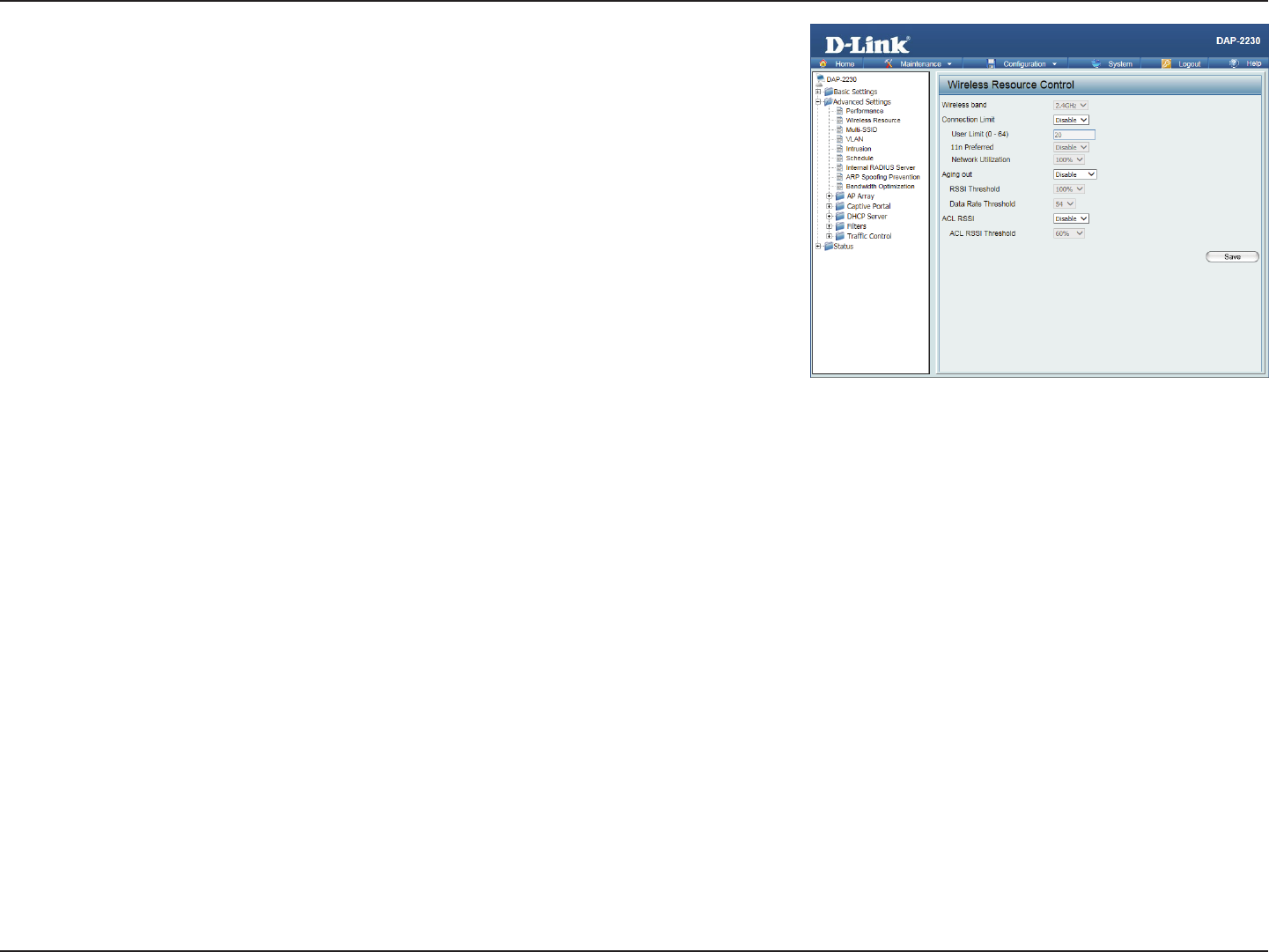
33D-Link DAP-2230 User Manual
Section 3 - Conguration
RSSI
Threshold:
When RSSI is selected in the Aging out drop-down menu, select the per-
centage of RSSI here. When the RSSI of wireless clients is lower than the
specied percentage, the device disconnects the wireless clients.
Data Rate
Threshold:
When Data Rate is selected in the Aging out drop-down menu, select
the threshold of data rate here. When the data rate of wireless clients is
lower than the specied number, the device disconnects the wireless
clients.
ACL RSSI: Use the drop-down menu to Enable the function. When enabled, the de-
vice denies the connection request from the wireless clients with the RSSI
lower than the specied threshold below.
ACL RSSI
Threshold:
Set the ACL RSSI Threshold.
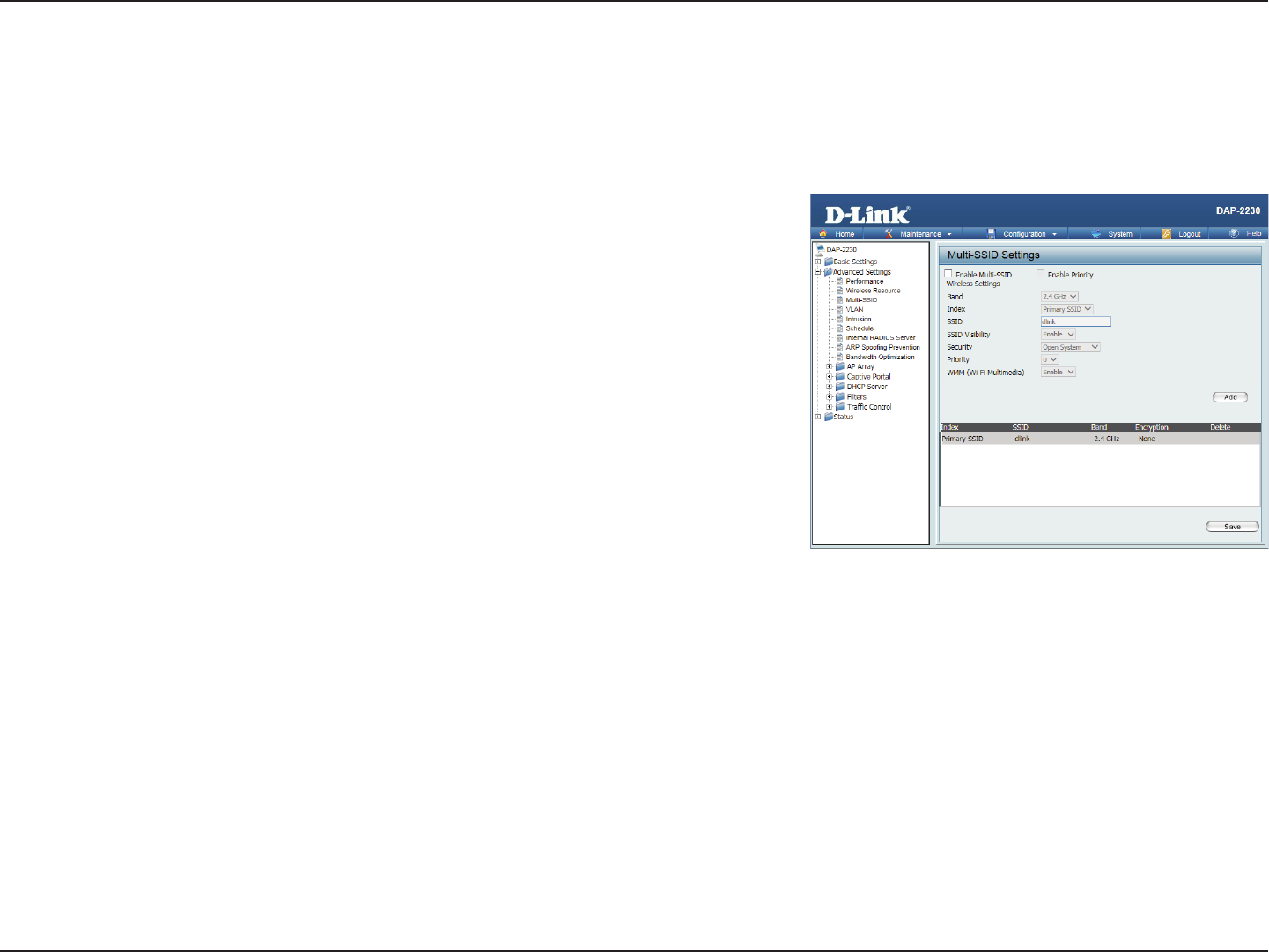
34D-Link DAP-2230 User Manual
Section 3 - Conguration
The device supports up to four multiple Service Set Identiers. In the Basic > Wireless section, you can set the Primary SSID.
The SSID’s factory default setting is dlink. The SSID can be easily changed to connect to an existing wireless network or to
establish a new wireless network.
Multi-SSID
Enable
Multi-SSID:
Check to enable support for multiple SSIDs.
Band: This read-only value is the current band setting.
Index: You can select up to three multi-SSIDs. With the Primary SSID, you have a
total of four multi-SSIDs.
SSID Service Set Identier (SSID) is the name designated for a specic wireless
local area network (WLAN). The SSID’s factory default setting is dlink. The
SSID can be easily changed to connect to an existing wireless network or
to establish a new wireless network.
SSID
Visibility:
Enable or Disable SSID visibility. Enabling this feature broadcasts the SSID
across the network, thus making it visible to all network users.
Security: The Multi-SSID security can be Open System, WPA-Personal, WPA-
Enterprise, or 802.1x. For a detailed description of the Open System
parameters, please go to page 26. For a detailed description of the WPA-
Personal parameters, please go to page 27. For a detailed description
of the WPA-Enterprise parameters, please go to page 28. For a detailed
description of the 802.1x parameters, please go to page 29.
Priority: Check the Enable Priority box at the top of this window to enable. Select
the priority from the drop-down menu.
WMM (Wi-Fi
Multimedia):
Select Enable or Disable.
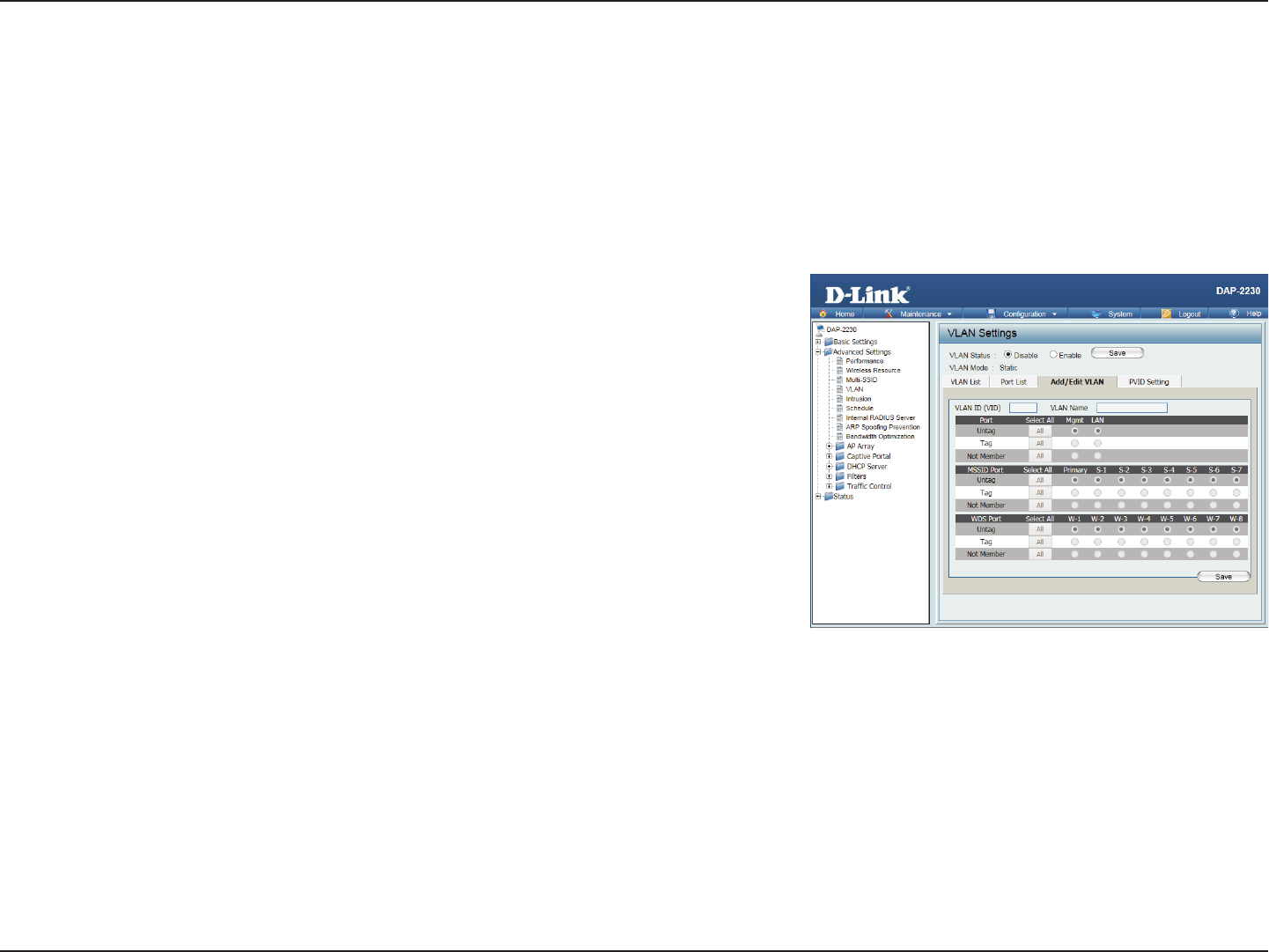
35D-Link DAP-2230 User Manual
Section 3 - Conguration
VLAN
VLAN List
The DAP-2230 supports VLANs. VLANs can be created with a Name and VID. Mgmt (TCP stack), LAN, Primary Multiple SSID, and
WDS connection can be assigned to VLANs as they are physical ports. Any packet which enters the DAP-2230 without a VLAN
tag will have a VLAN tag inserted with a PVID.
The VLAN List tab displays the current VLANs.
VLAN
Status:
Use the radio button to toggle between Enable or Disable. Next, go to the
Add/Edit VLAN tab to add or modify an item on the VLAN List tab.
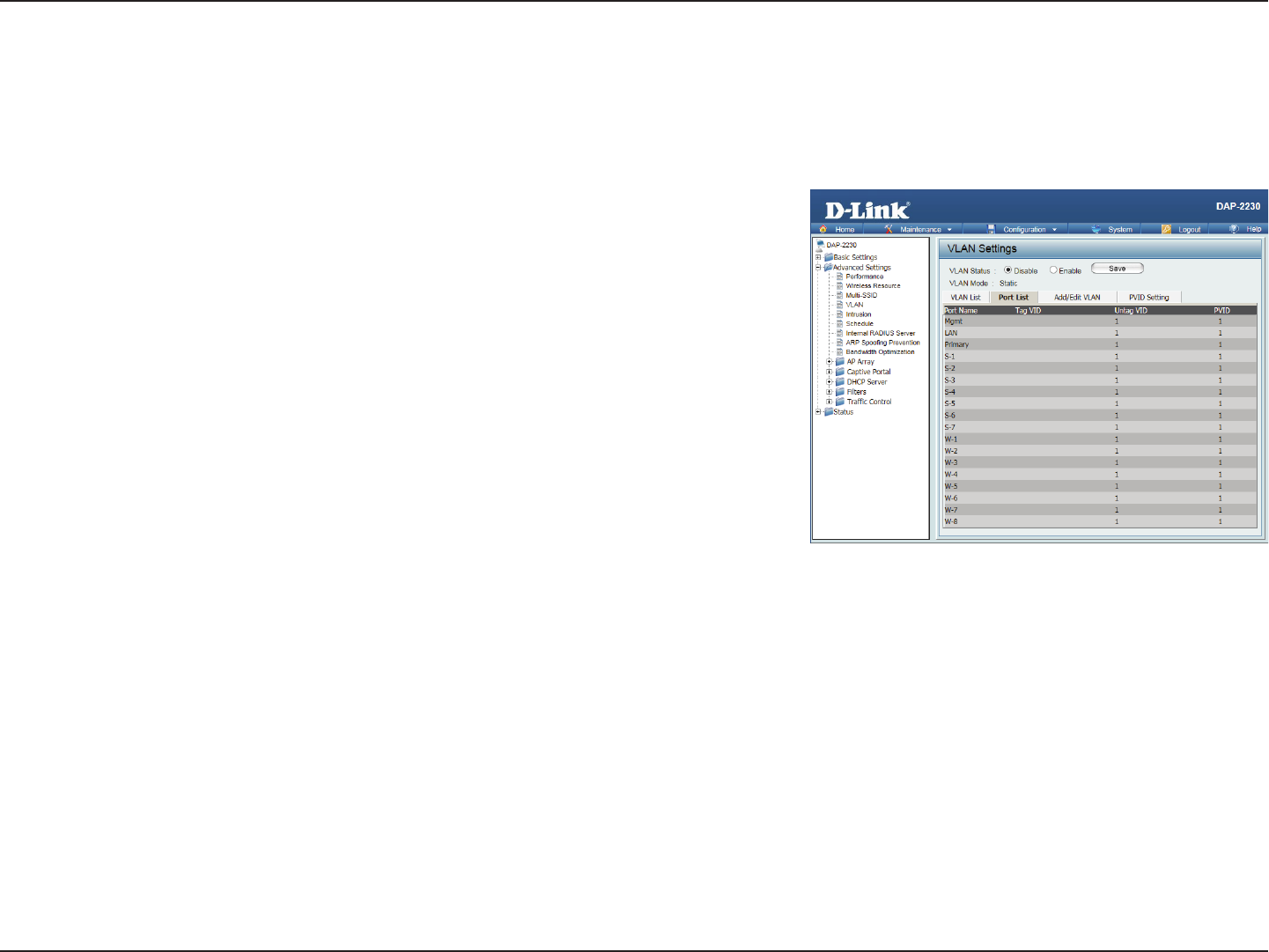
36D-Link DAP-2230 User Manual
Section 3 - Conguration
Port List
The Port List tab displays the current ports. If you want to congure guest and internal networks on a Virtual LAN (VLAN),
the switch and DHCP server you are using must also support VLANs. As a prerequisite step, congure a port on the switch for
handling VLAN tagged packets as described in the IEEE 802.1Q standard.
VLAN
Status:
Use the radio button to toggle to Enable. Next, go to the Add/Edit VLAN
tab to add or modify an item on the VLAN List tab.
Port Name: The name of the port is displayed in this column.
Tag VID: The Tagged VID is displayed in this column.
Untag VID: The Untagged VID is displayed in this column.
PVID: The Port VLAN Identier is displayed in this column.
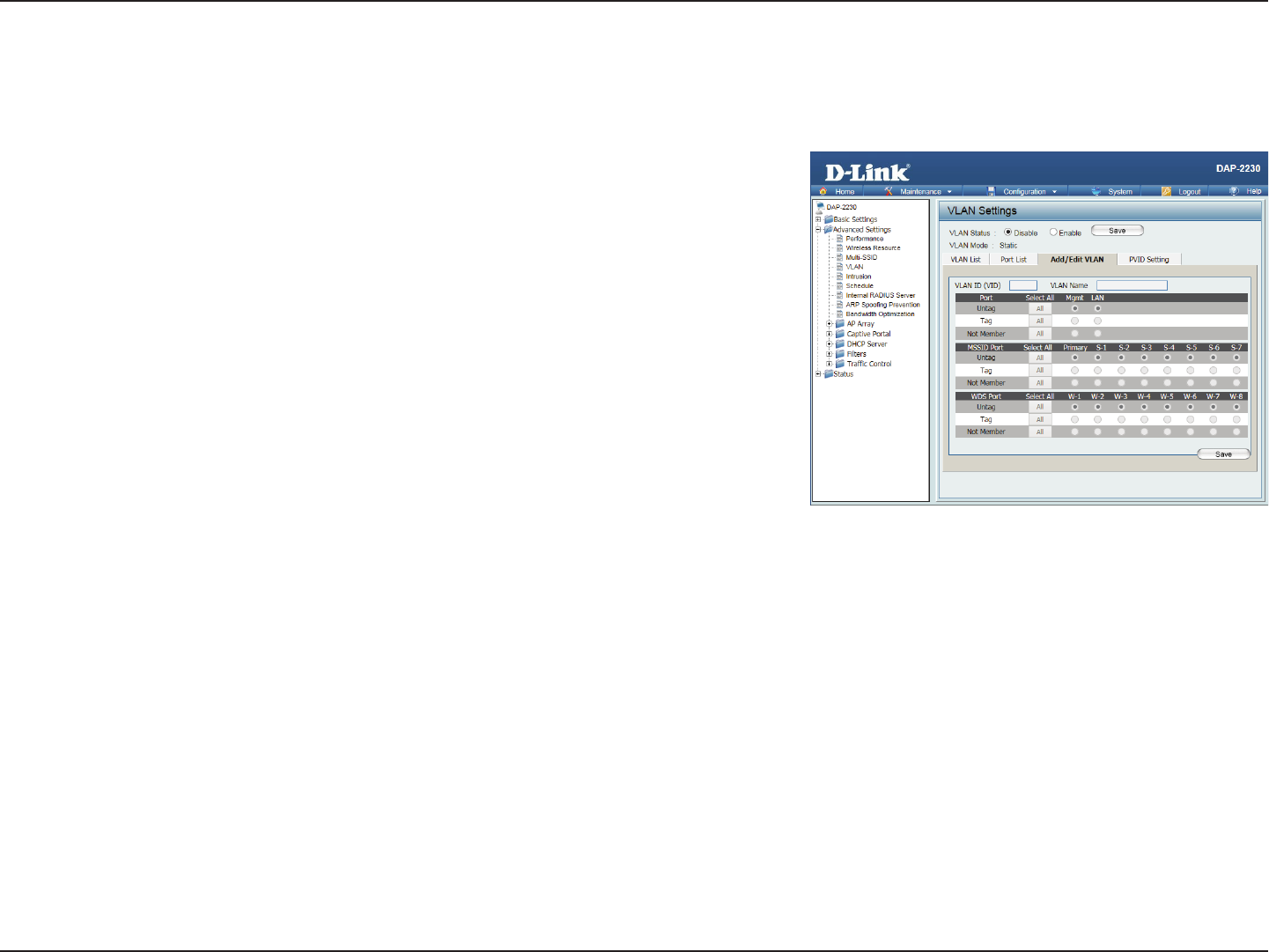
37D-Link DAP-2230 User Manual
Section 3 - Conguration
Add/Edit VLAN
The Add/Edit VLAN tab is used to congure VLANs. Once you have made the desired changes, click the Save button to let
your changes take eect.
VLAN
Status:
Use the radio button to toggle to Enable.
VLAN ID: Provide an ID number between 1 and 4094 for the Internal VLAN.
VLAN
Name:
Enter the VLAN to add or modify.
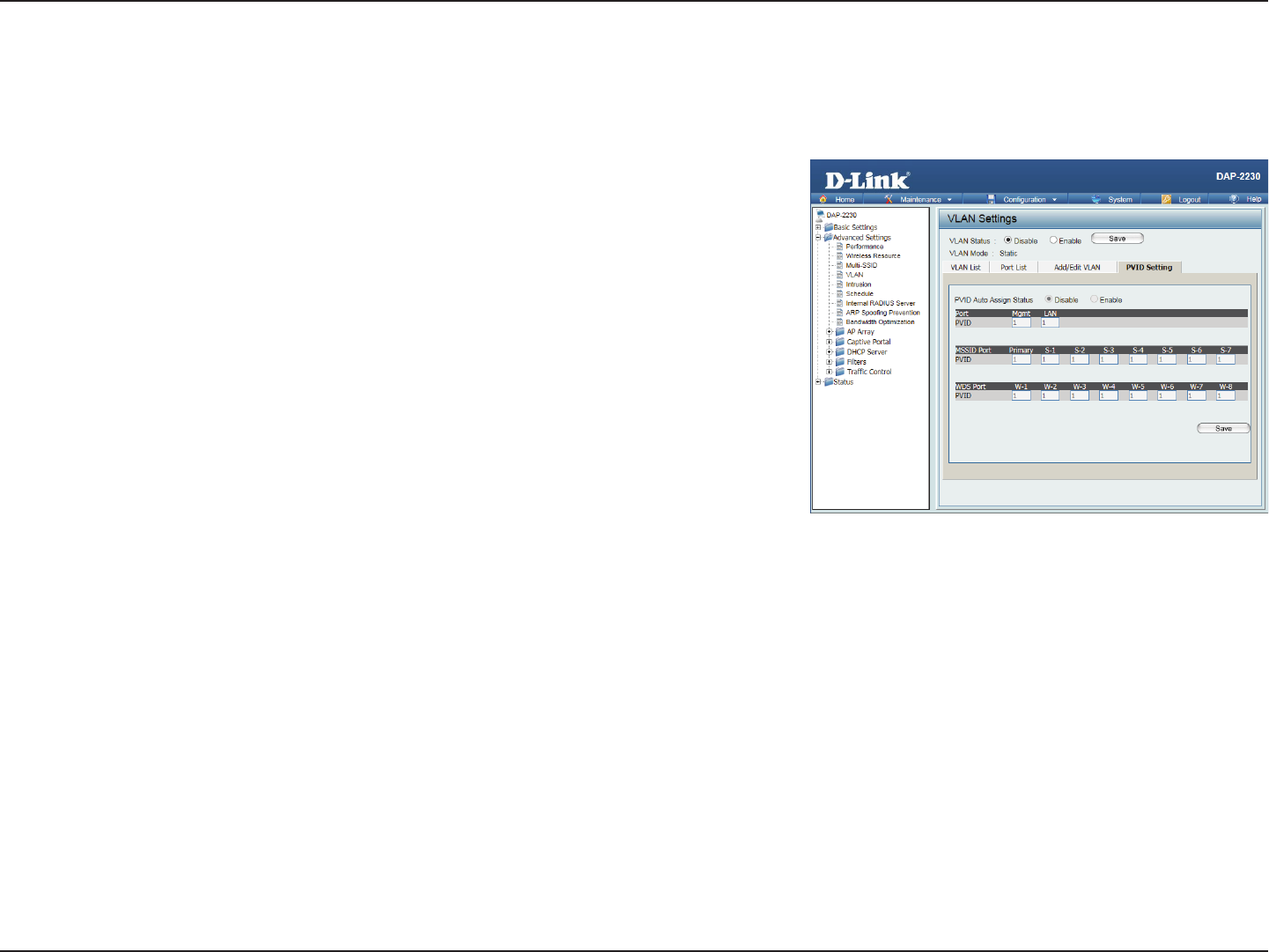
38D-Link DAP-2230 User Manual
Section 3 - Conguration
PVID Setting
The PVID Setting tab is used to enable/disable the Port VLAN Identier Auto Assign Status as well as to congure various types
of PVID settings. Click the Save button to let your changes take eect.
VLAN Status: Use the radio button to toggle between Enable and Disable.
PVID Auto
Assign Status:
Use the radio button to toggle PVID auto assign status to Enable.
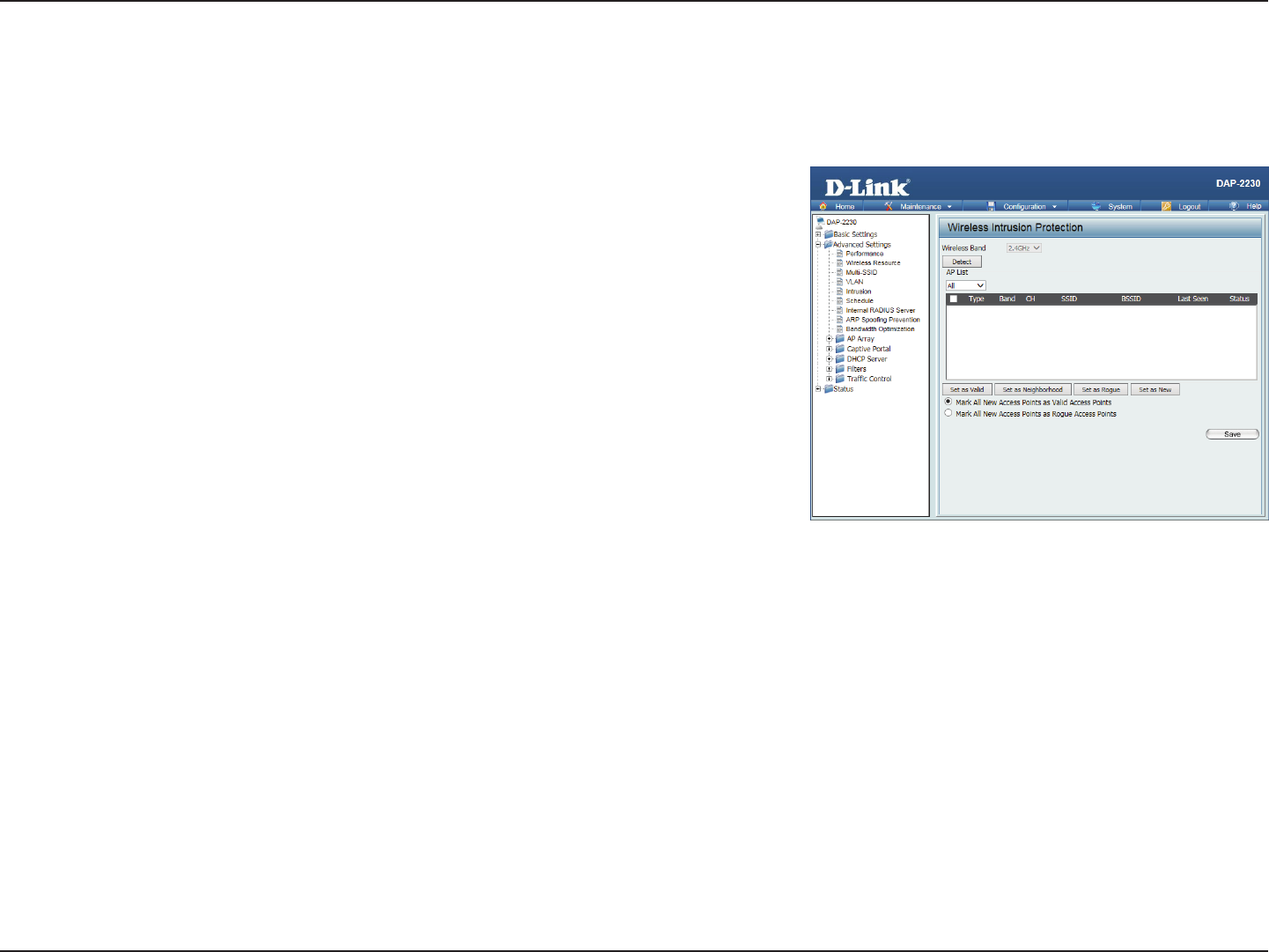
39D-Link DAP-2230 User Manual
Section 3 - Conguration
Intrusion
The Wireless Intrusion Protection window is used to set APs as All, Valid, Neighborhood, Rogue, and New. Click the Save
button to let your changes take eect.
AP List: The choices include All, Valid, Neighbor, Rogue, and New.
Detect: Click this button to initiate a scan of the network.
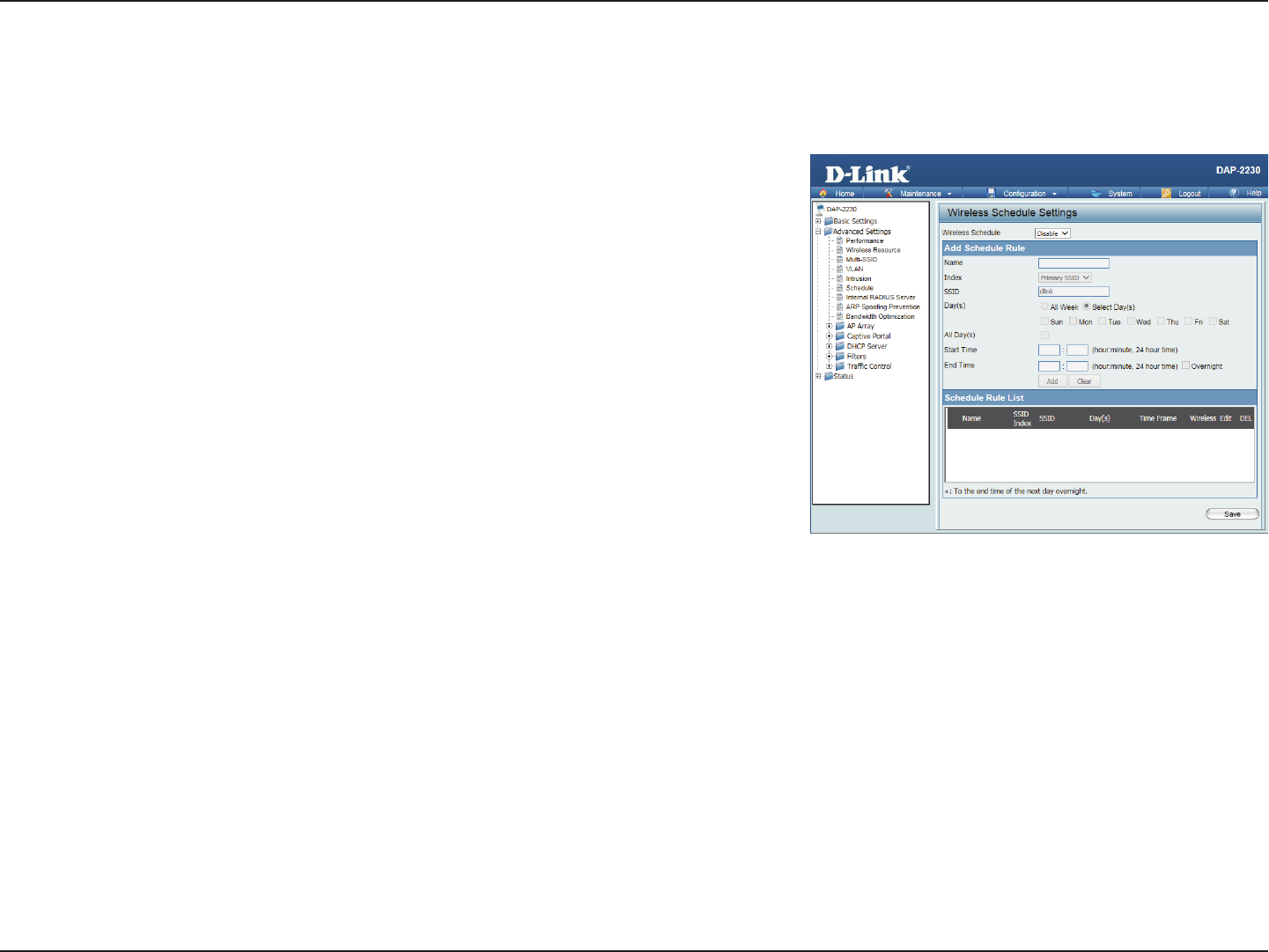
40D-Link DAP-2230 User Manual
Section 3 - Conguration
Schedule
The Wireless Schedule Settings window is used to add and modify scheduling rules on the device. Click the Save button to let
your changes take eect.
Wireless
Schedule:
Use the drop-down menu to enable the device’s scheduling feature.
Name: Enter a name for the new scheduling rule in the eld provided.
Index: Select the SSID the schedule will apply to from the drop-down menu.
SSID: Enter the name of your wireless network (SSID).
Day(s): Toggle the radio button between All Week and Select Day(s). If the second
option is selected, check the specic days you want to apply the rule to.
All Day(s): Check this box to have your settings apply 24 hours a day.
Start Time: Enter the start time for your rule. If you selected All Day, this option will be
greyed out.
End Time: Enter the end time for your rule.
Add: Click to add the rule to the list.
Schedule
Rule List:
This section will display the list of created schedules.
Save: Click the Save button to save your created rules.
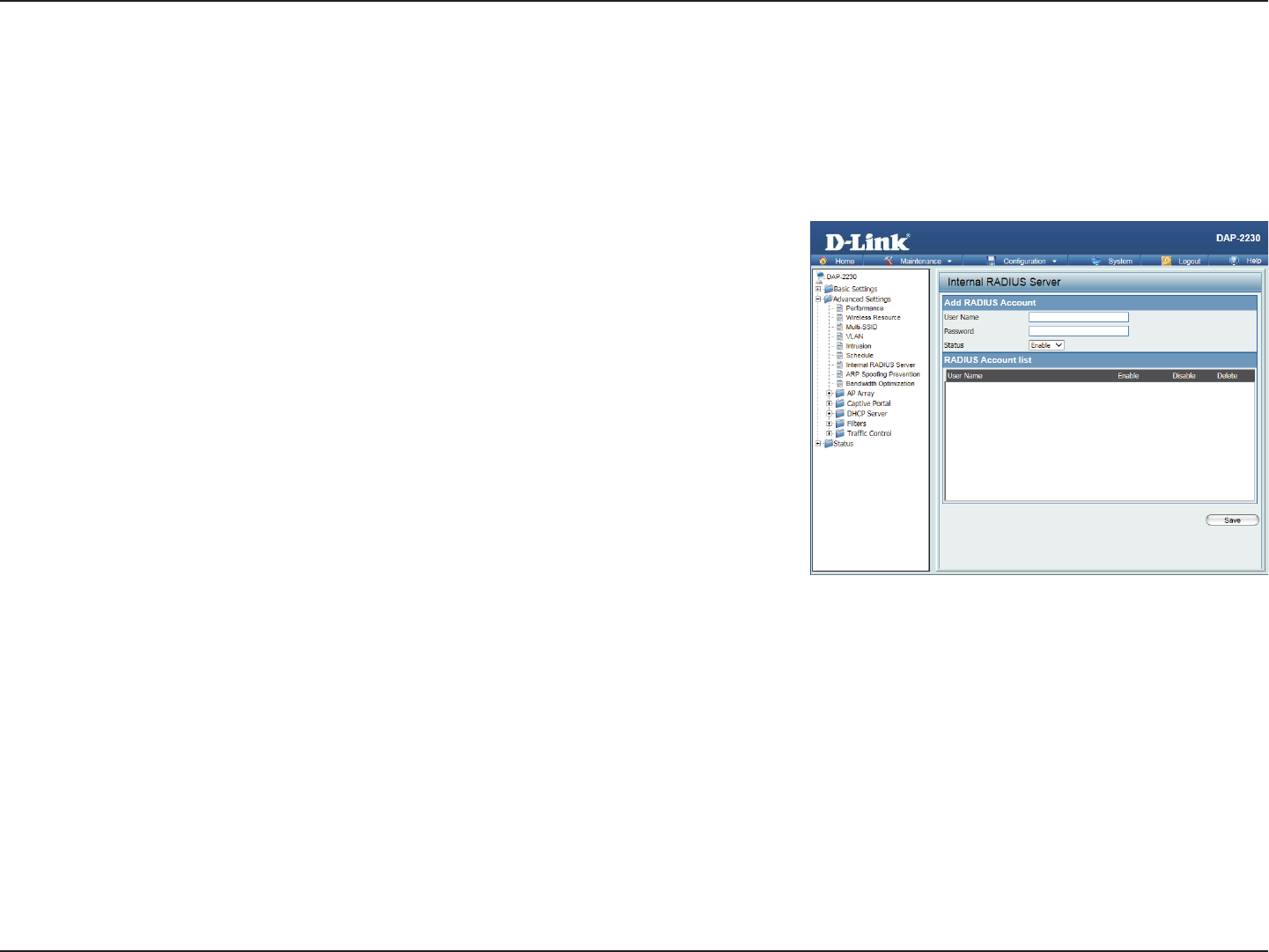
41D-Link DAP-2230 User Manual
Section 3 - Conguration
Internal RADIUS Server
The DAP-2230 features a built-in RADIUS server. Once you have nished adding a RADIUS account, click the Save button to
have your changes take eect. The newly-created account will appear in this RADIUS Account List. The radio buttons allow the
user to enable or disable the RADIUS account. Click the icon in the delete column to remove the RADIUS account. We suggest
you limit the number of accounts to under 30.
User Name: Enter a name to authenticate user access to the internal RADIUS server.
Password: Enter a password to authenticate user access to the internal RADIUS server.
The length of your password should be 8~64.
Status: Toggle the drop-down menu between Enable and Disable.
RADIUS
Account List:
Displays the list of users.
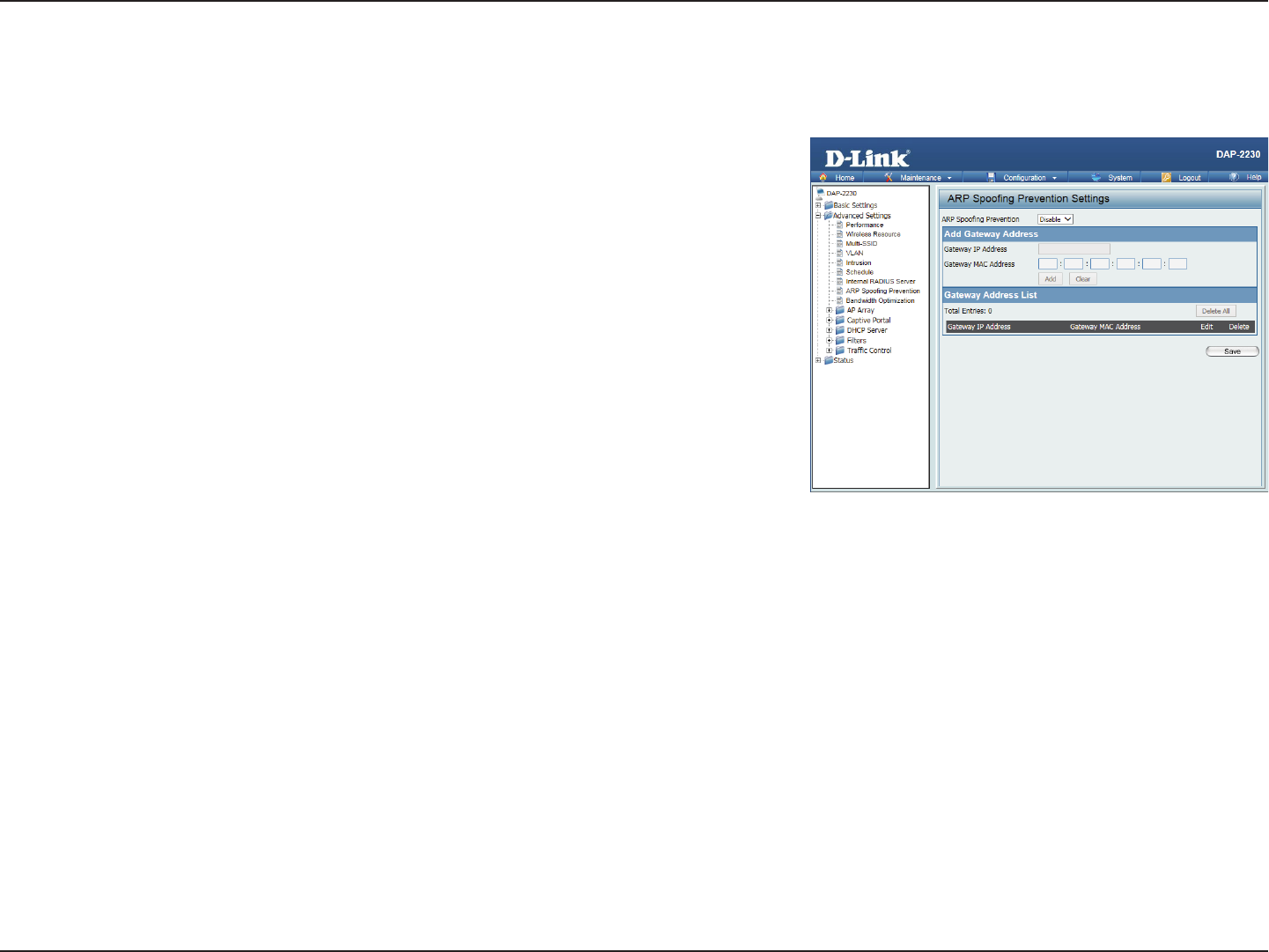
42D-Link DAP-2230 User Manual
Section 3 - Conguration
ARP Spoong Prevention Settings
The ARP Spoong Prevention feature allows users to add IP/MAC address mapping to prevent ARP spoong attacks.
ARP
Spoong
Prevention:
This check box allows you to enable the ARP spoong prevention function.
Gateway
IP Address:
Enter a gateway IP address.
Gateway
MAC Address:
Enter a gateway MAC address.
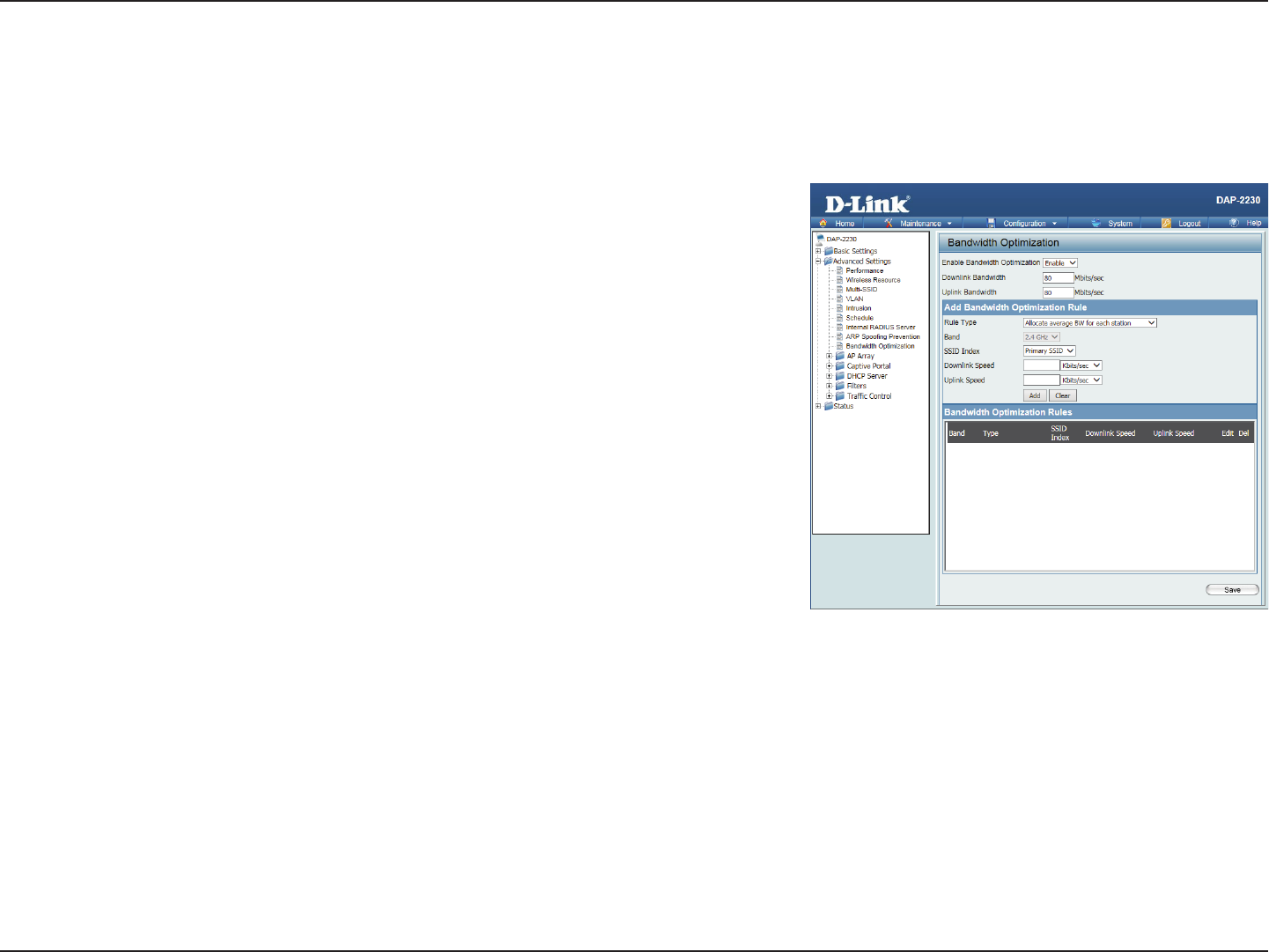
43D-Link DAP-2230 User Manual
Section 3 - Conguration
Bandwidth Optimization
The Bandwidth Optimization window allows the user to manage the bandwidth of the access point and adjust the bandwidth
for various wireless clients. After inputting a Bandwidth Optimization rule, click the Add button. To discard a Bandwidth
Optimization Rule setting, click the Clear button. Click the Save button to let your changes take eect.
Enable
Bandwidth
Optimization:
Use the drop-down menu to Enable the Bandwidth Optimization function.
Downlink
Bandwidth:
Enter the downlink bandwidth of the device in Mbits per second.
Uplink
Bandwidth:
Enter the uplink bandwidth of the device in Mbits per second.
Rule Type: Use the drop-down menu to select the type that is applied to the rule.
Available options are: Allocate average BW for each station, Allocate
maximum BW for each station, Allocate dierent BW for 11b/g/n stations,
and Allocte specic BW for SSID.
Allocate
average BW for
each station:
AP will distribute average bandwidth for each client.
Allocate
maximum BW
for each station:
Specify the maximum bandwidth for each connected client. Reserve certain
bandwidth for future clients.
Allocate
dierent BW
for b/g/n
stations:
The weight of 11b/g/n client are 10%/20%/70%. AP will distribute dierent
bandwidth for 11b/g/n clients.
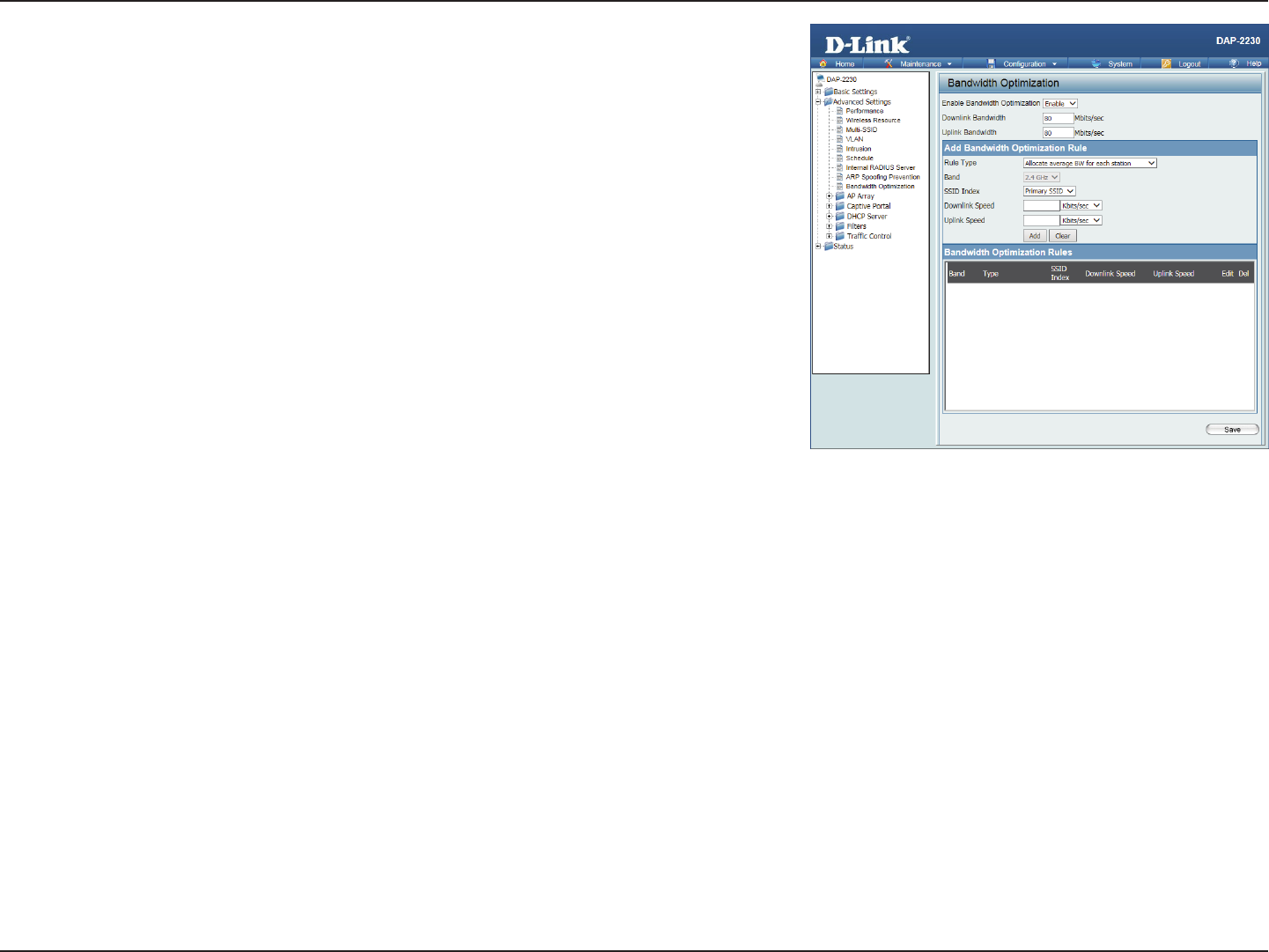
44D-Link DAP-2230 User Manual
Section 3 - Conguration
Allocate
specic BW
for SSID:
All clients share the total bandwidth.
Band: Use the drop-down menu to toggle the wireless band 2.4 Ghz.
SSID Index: Use the drop-down menu to select the SSID for the specied wireless band.
Downlink
Speed:
Enter the downlink speed limit in either Kbits/sec or Mbits/sec for the rule.
Uplink
Speed:
Enter the upload speed limit in either Kbits/sec or Mbits/sec for the rule.
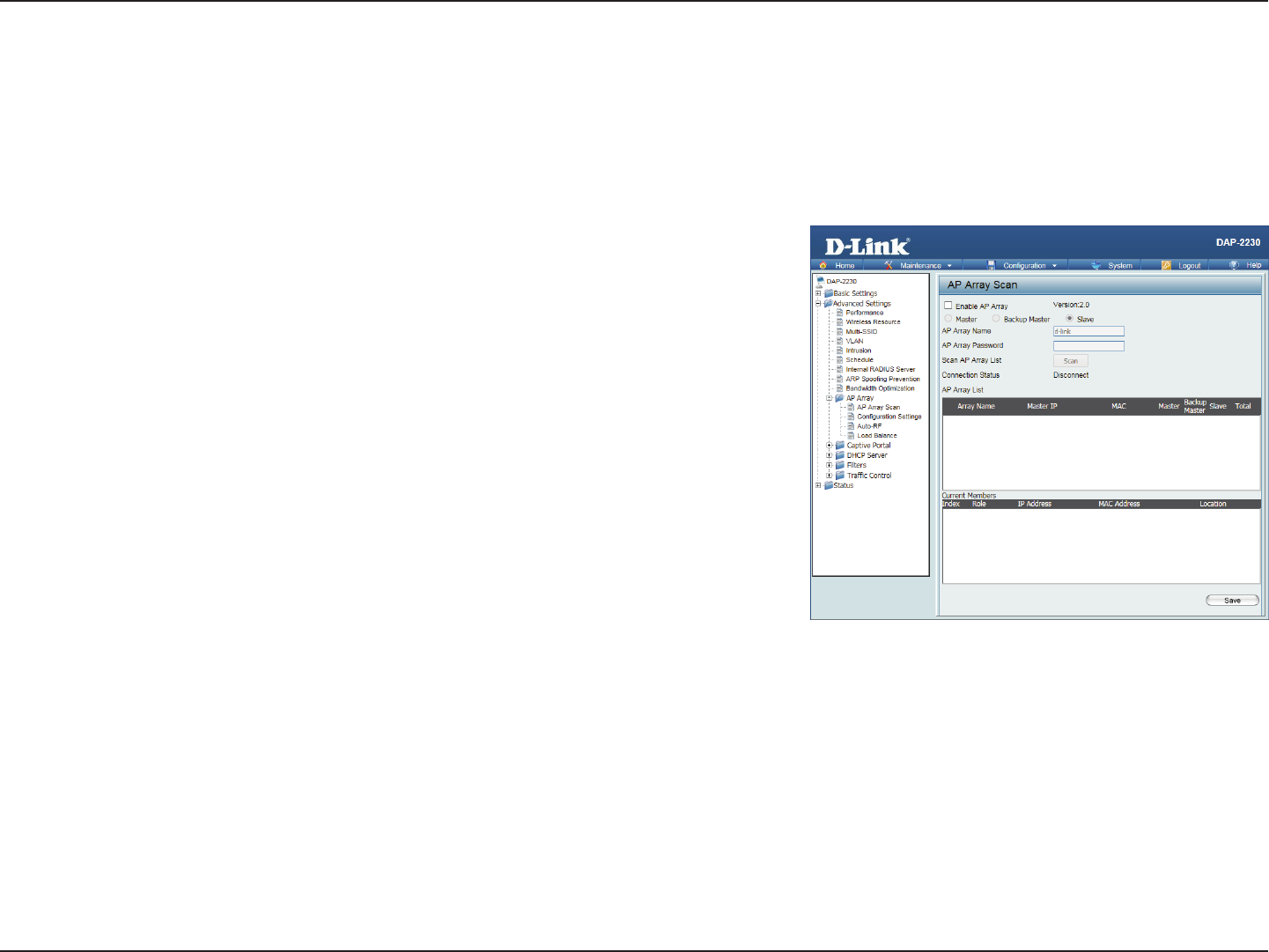
45D-Link DAP-2230 User Manual
Section 3 - Conguration
AP Array Scan
The AP Array window is used to create up to 32 APs on a local network to be organized into a single group in order to simplify
management. Click the Save button to let your changes take eect. Central WiFiManager and AP Array are mutually exclusive
functions.
AP Array
Enable AP
Array:
Select the check box to enable the AP array function. The three modes that
are available are Master, Backup Master, and Slave. APs in the same array
will use the same conguration. The conguration will sync the Master AP
to the Slave AP and the Backup Master AP when a Slave AP and a Backup
Master AP join the AP array.
AP Array
Name:
Enter an AP array name for the group here.
AP Array
Password:
Enter an AP array password for the group here. This password must be the
same on all the APs in the group.
Scan AP
Array List:
Click this button to initiate a scan of all the available APs currently on the
network.
Connection
Status:
Display the AP array connection status.
AP Array
List:
This table displays the current AP array status for the following parameters:
Array Name, Master IP, MAC, Master, Backup Master, Slave, and Total.
Current
Members:
This table displays all the current array members. The DAP-2230 AP array
feature supports up to eight AP array members.
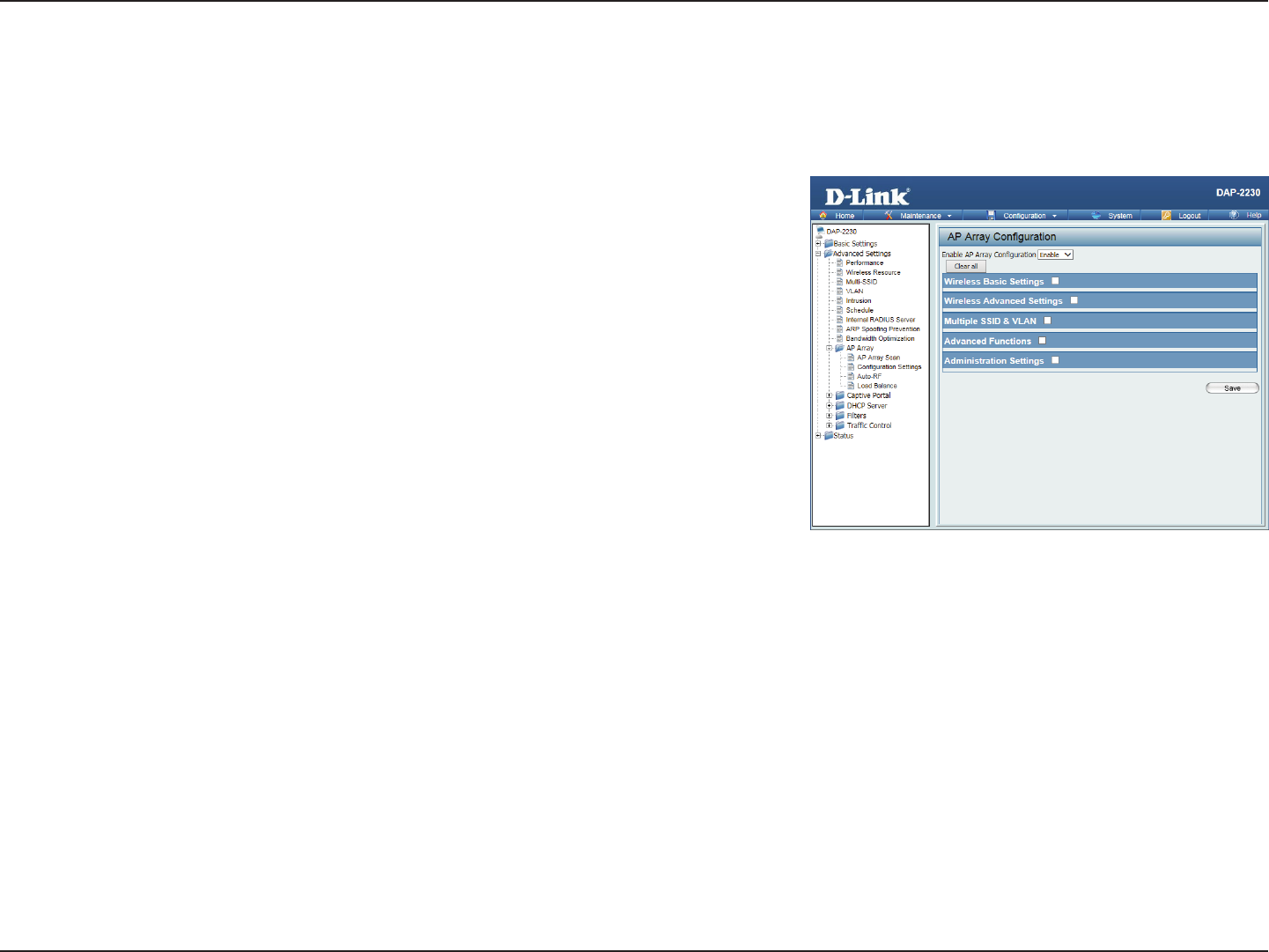
46D-Link DAP-2230 User Manual
Section 3 - Conguration
Conguration Settings
In the AP array conguration settings windows, users can specify which settings all the APs in the group will inherit from the
master AP. Make the desired selections in this window and click the Save button to accept the changes.
Enable AP
Array
Conguration:
Select to Enable or Disable the AP array congure feature here.
Wireless
Basic
Settings:
Select this option to specify the basic wireless settings that the APs in the
group will inherit.
Wireless
Advanced
Settings:
Select this option to specify the advanced wireless settings that the APs in
the group will inherit.
Multiple
SSID &
VLAN:
Select this option to specify the multiple SSIDs and VLAN settings that the
APs in the group will inherit.
Advanced
Functions:
Select this option to specify the other advanced settings that the APs in the
group will inherit.
Administration
Settings:
Select this option to specify the administrative settings that the APs in the
group will inherit.
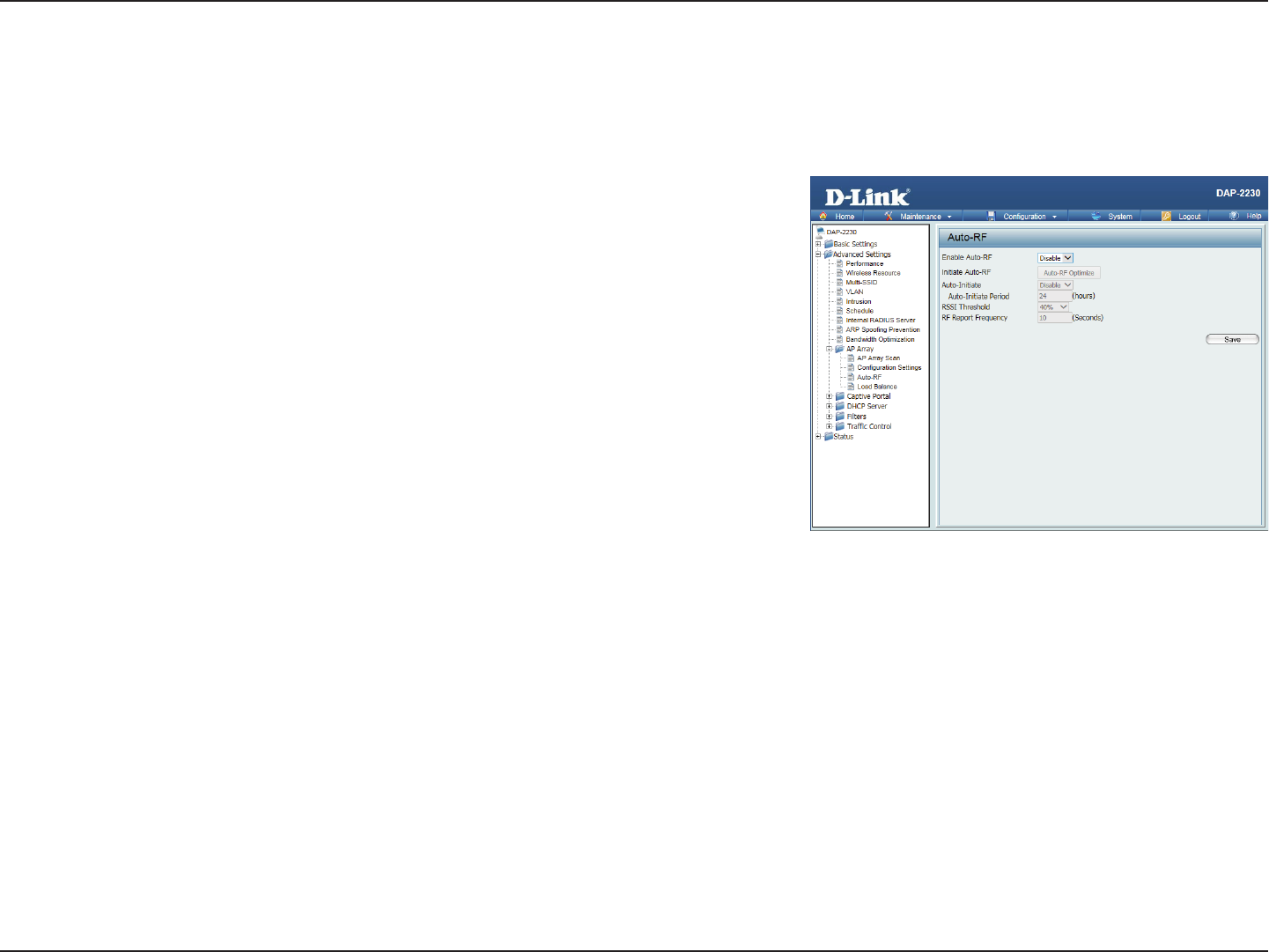
47D-Link DAP-2230 User Manual
Section 3 - Conguration
Auto-RF
In this window, users can view and congure the automatic radio frequency settings as well as congure the auto-initiate
period and threshold values. Click the Save button to accept the changes made.
Enable:
Auto-RF:
Select to Enable or Disable the auto-RF feature here.
Initiate
Auto-RF:
Click the Auto-RF Optimize button to initiate the auto-RF optimization
feature.
Auto-Initiate: Select the Enable or Disable the auto-initiate feature here.
Auto-Initiate
Period:
After enabling the auto-initiate option, the auto-initiate period value can
be entered here. This value must be between 1 and 24 hours.
RSSI
Threshold:
Select the RSSI threshold value here. This value is listed in the drop-down
menu in increments of 10% from 10% to 100%.
RF Report
Frequency:
Enter the RF report frequency value here.
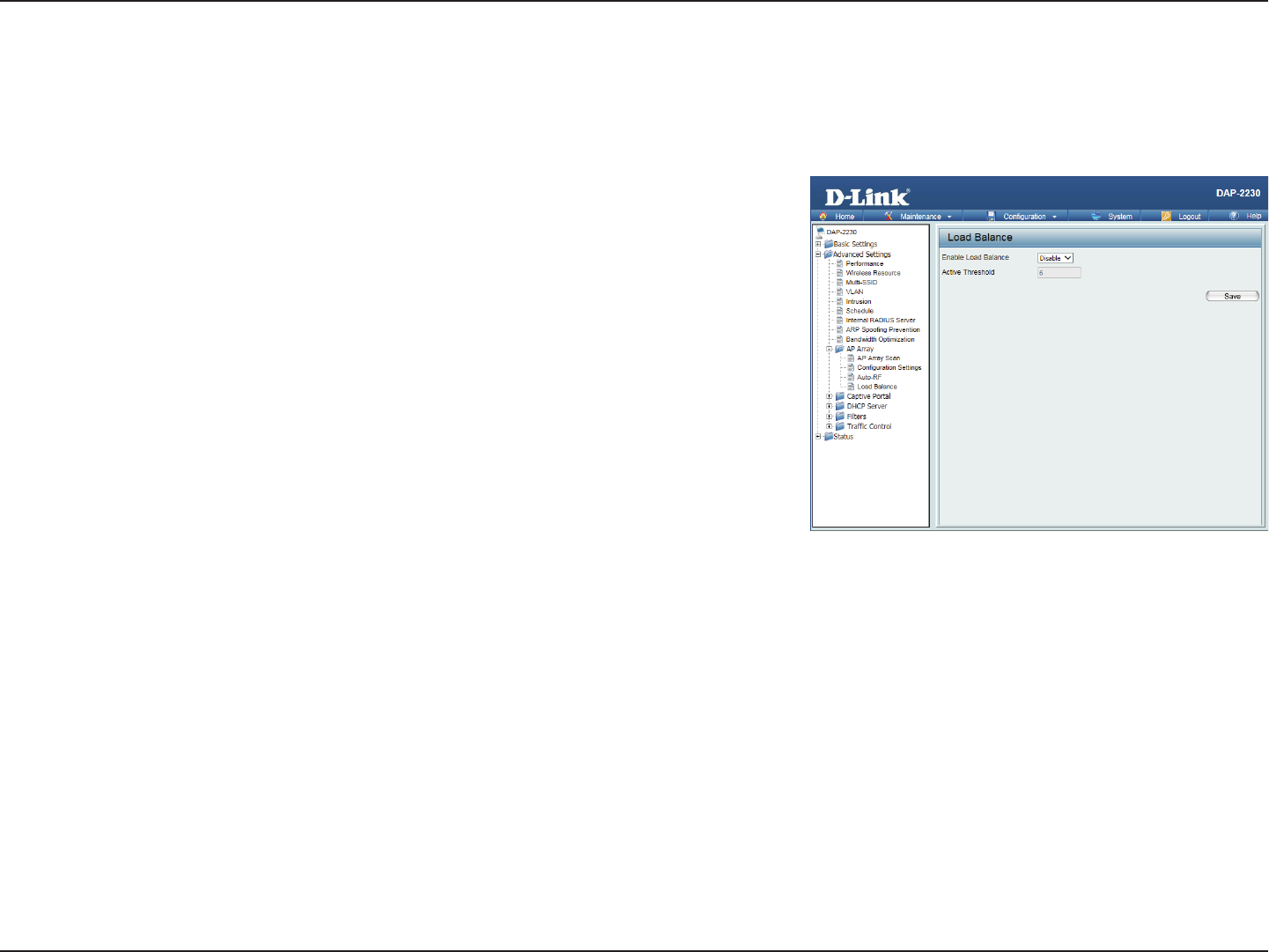
48D-Link DAP-2230 User Manual
Section 3 - Conguration
Load Balance
In this window, users can view and congure the AP array’s load balancing settings. Click the Save button to accept the changes
made.
Enable Load
Balance:
Select to Enable or Disable the load balance feature here.
Active
Threshold:
Enter the active threshold value here.

49D-Link DAP-2230 User Manual
Section 3 - Conguration
Captive Portal Authentication
Captive Portal is a built-in web authentication server. When a client connects to an AP, the user’s web browser will be redirected
to a web authentication page. In this conguration option, administrators can view and congure the Captive Portal settings.
Session
timeout
(1-1440):
Enter the session timeout value here. This value can be from 1 to 1440
minutes. By default, this value is 60 minutes.
Band: Select 2.4 Ghz.
SSID Index: Select the SSID for this Authentication.
Authentication
Type:
Select the captive portal encryption type here. Options to choose from
are Web Redirection, Username/Password, Passcode, Remote RADIUS,
LDAP and POP3.
Web
Redirection
State:
Web Redirection State is automatically enabled when Web Redirection
Authentication is selected.
URL Path : Select whether to use either HTTP or HTTPS here. After selecting either
http:// or https://, enter the URL of the website that will be used in the space
provided.
Web Redirection Only
After selecting Web Redirection Only as the Authentication Type, you can congure the redirection website URL that will be
applied to each wireless client that connects to this network.
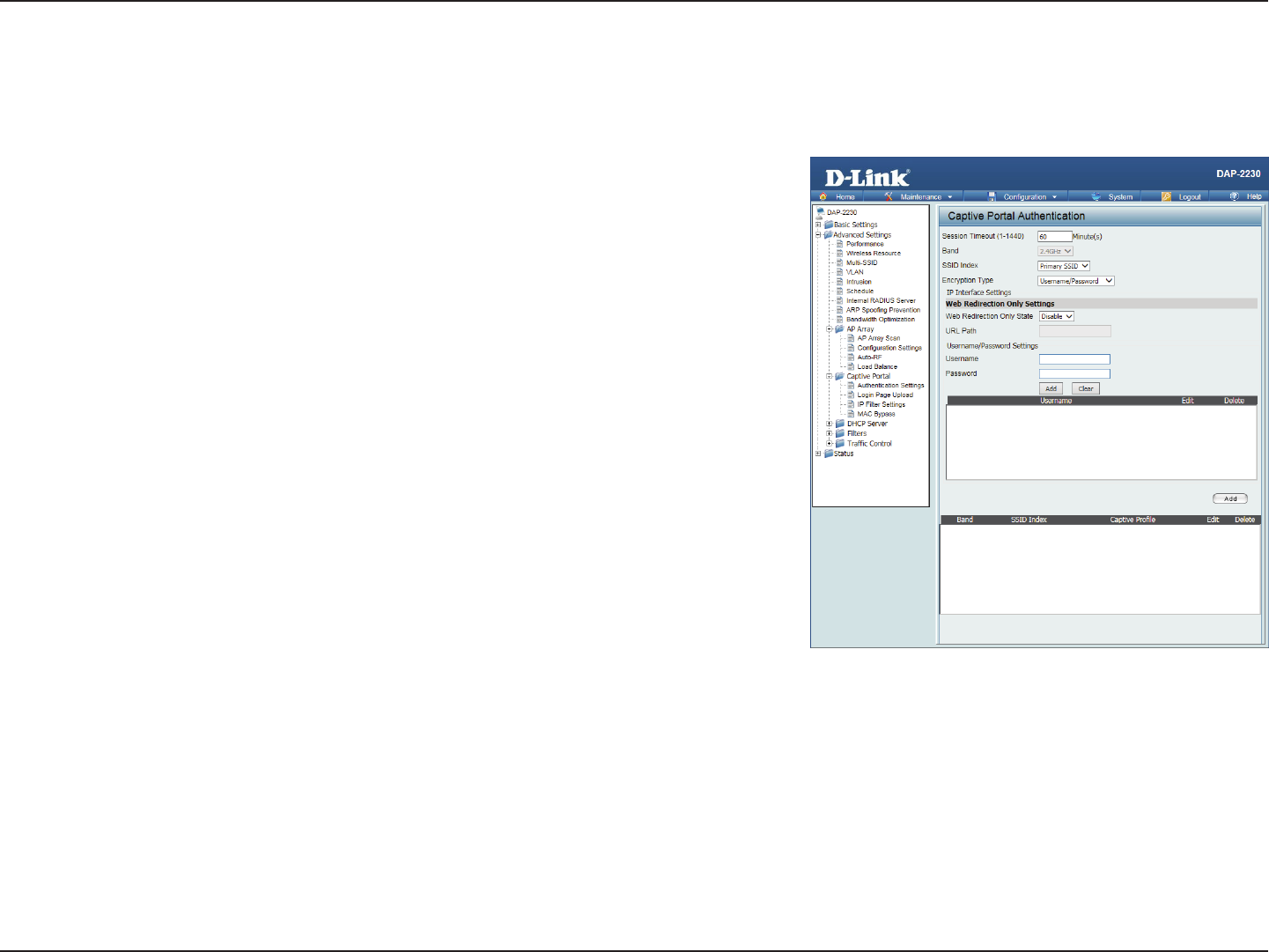
50D-Link DAP-2230 User Manual
Section 3 - Conguration
Username/Password
After selecting Username/Password as the Authentication Type, administrators can congure the Username and Password
that each wireless client will be prompted for when requesting access to the network.
Session
timeout
(1-1440):
Enter the session timeout value here. This value can be from 1 to 1440
minutes. By default, this value is 60 minutes.
Band: Select 2.4 Ghz.
SSID Index: Select the SSID for this Authentication.
Authentication
Type:
Select the captive portal encryption type here. Options to choose from are
Web Redirection, Username/Password, Passcode, Remote RADIUS, LDAP
and POP3.
Web
Redirection
State:
By default web redirection is disabled. Select enable to activate the website
redirection feature.
URL Path : Select whether to use either HTTP or HTTPS here. After selecting either
http:// or https://, enter the URL of the website that will be used in the space
provided.
Username: Enter the username for the new account here.
Password: Enter the password for the new account here.
Username/Password
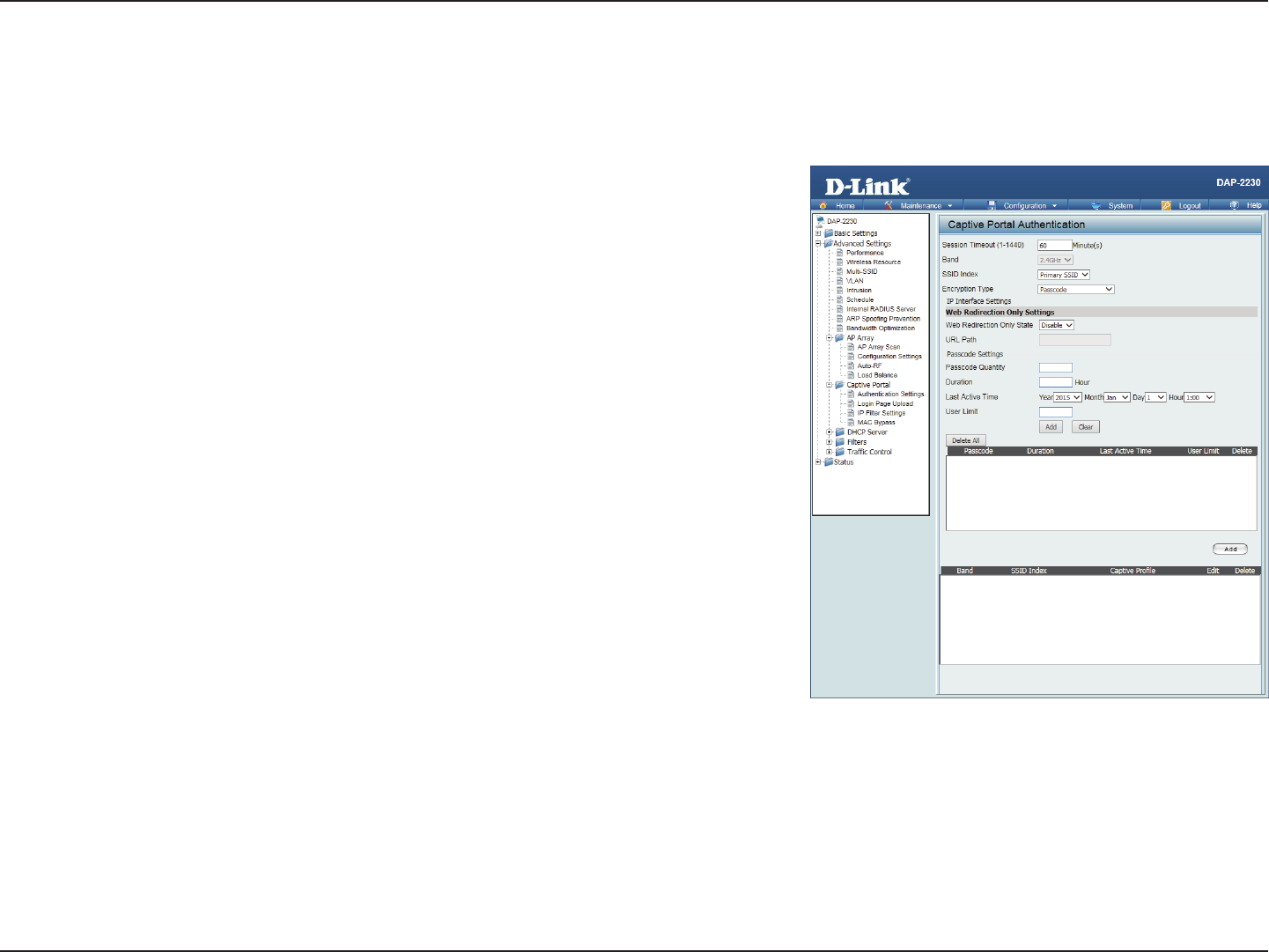
51D-Link DAP-2230 User Manual
Section 3 - Conguration
After selecting Passcode as the Authentication Type, administrators can congure the Passcode that each wireless client will
be prompted for when requesting access to the network. A passcode will be randomly generated upon clicking Add.
Session
timeout
(1-1440):
Enter the session timeout value here. This value can be from 1 to 1440
minutes. By default, this value is 60 minutes.
Band: Select 2.4 Ghz.
SSID Index: Select the SSID for this Authentication.
Authentication
Type:
Select the captive portal encryption type here. Options to choose from are
Web Redirection, Username/Password, Passcode, Remote RADIUS, LDAP
and POP3.
Web
Redirection
State:
By default web redirection is disabled. Select enable to activate the website
redirection feature.
URL Path : Select whether to use either HTTP or HTTPS here. After selecting either
http:// or https://, enter the URL of the website that will be used in the space
provided.
Passcode
Quantity:
Enter the number of passcodes to generate.
Duration: Enter the duration value, in hours, for the passcode(s).
Last Active
Day:
Select the year, month, day, and hour when this passcode will expire.
User Limit: Enter the maximum amount of users that can use this passcode at the same time
Passcode
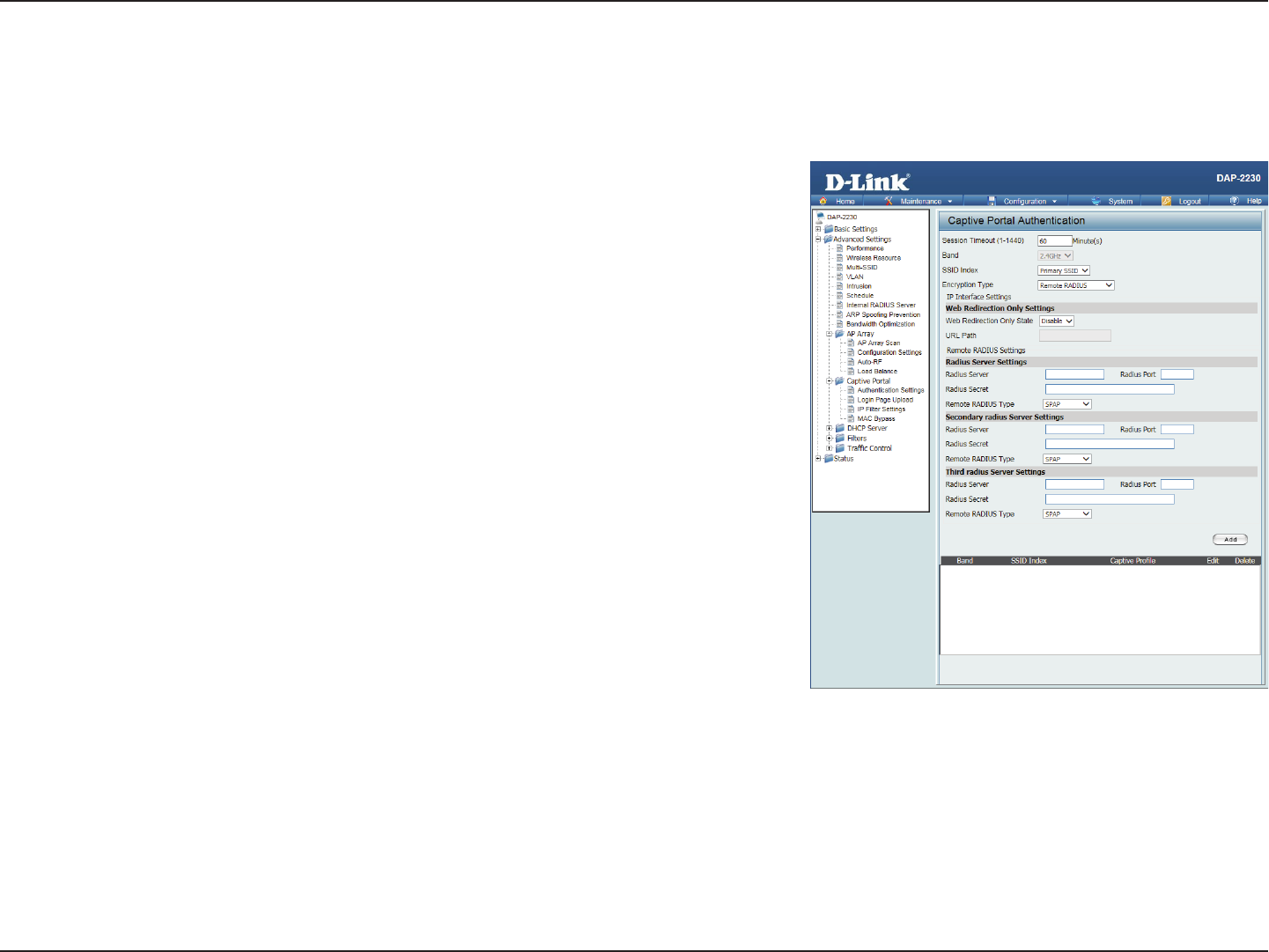
52D-Link DAP-2230 User Manual
Section 3 - Conguration
After selecting Remote RADIUS as the Authentication Type, administrators can congure the Remote RADIUS authentication
settings required to join the network.
Session
timeout
(1-1440):
Enter the session timeout value here. This value can be from 1 to 1440
minutes. By default, this value is 60 minutes.
Band: Select 2.4 Ghz.
SSID Index: Select the SSID for this Authentication.
Authentication
Type:
Select the captive portal encryption type here. Options to choose from are
Web Redirection, Username/Password, Passcode, Remote RADIUS, LDAP
and POP3.
Web
Redirection
State:
By default web redirection is disabled. Select enable to activate the website
redirection feature.
URL Path : Select whether to use either HTTP or HTTPS here. After selecting either
http:// or https://, enter the URL of the website that will be used in the space
provided.
Radius
Server:
Enter the RADIUS server’s IP address here
Radius Port: Enter the RADIUS server’s port number here
Radius Port: Enter the RADIUS server’s shared secret here
Remote
Radius
Type:
Select the remote RADIUS server type here.
Remote Radius
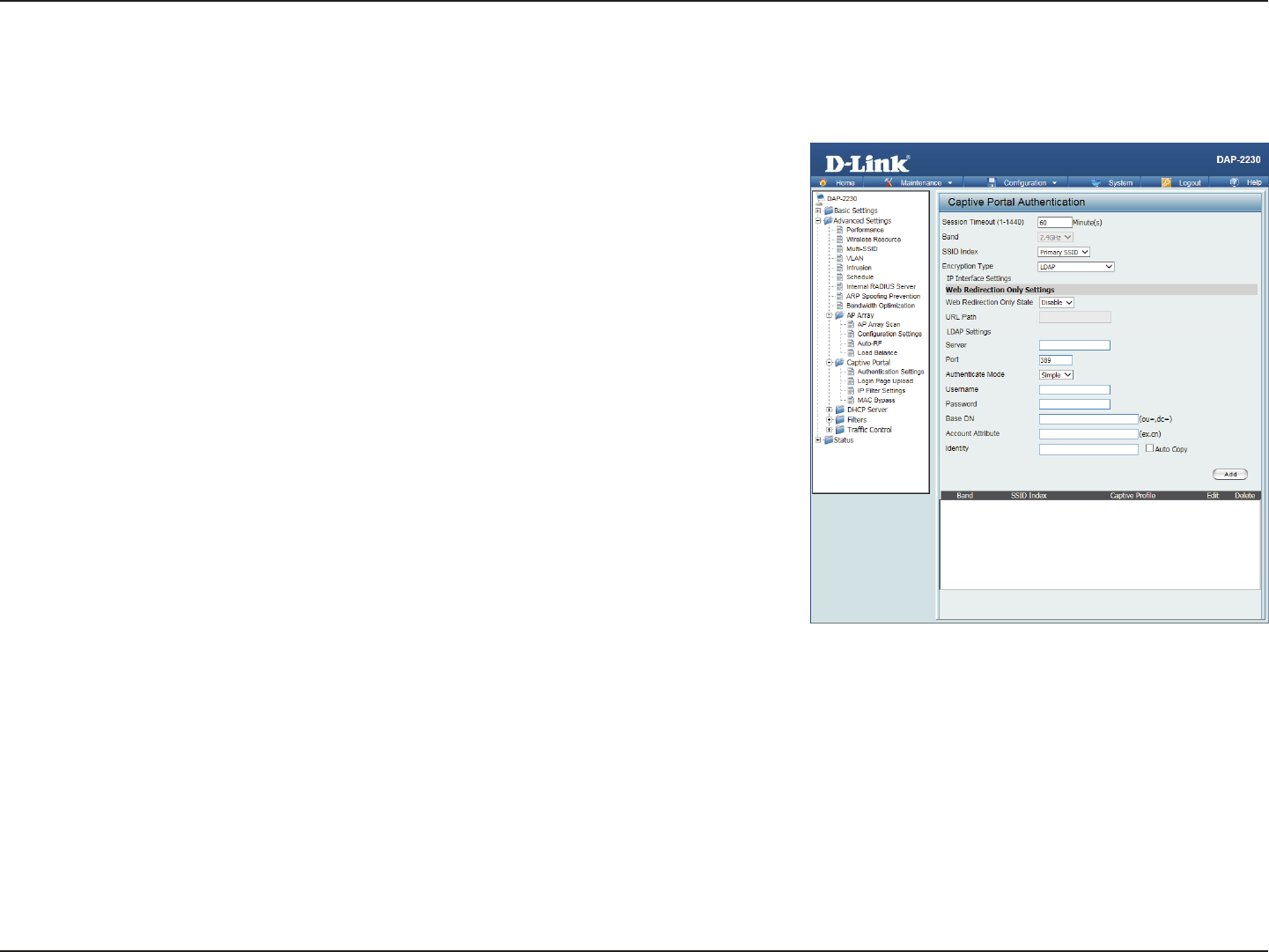
53D-Link DAP-2230 User Manual
Section 3 - Conguration
After selecting LDAP as the Authentication Type, administrators can congure the LDAP authentication settings required to
join the network.
Session
timeout
(1-1440):
Enter the session timeout value here. This value can be from 1 to 1440
minutes. By default, this value is 60 minutes.
Band: Select 2.4 Ghz.
SSID Index: Select the SSID for this Authentication.
Authentication
Type:
Select the captive portal encryption type here. Options to choose from are
Web Redirection, Username/Password, Passcode, Remote RADIUS, LDAP
and POP3.
Web
Redirection
State:
By default web redirection is disabled. Select enable to activate the website
redirection feature.
URL Path : Select whether to use either HTTP or HTTPS here. After selecting either
http:// or https://, enter the URL of the website that will be used in the space
provided.
Server: Enter the LDAP server’s IP address or domain name here.
Port: Enter the LDAP server’s port number here.
Authenticate
Mode:
Select the authentication mode here. Options to choose from are Simple and TLS.
Username: Enter the LDAP server account’s username here.
Password: Enter the LDAP server account’s password here.
LDAP
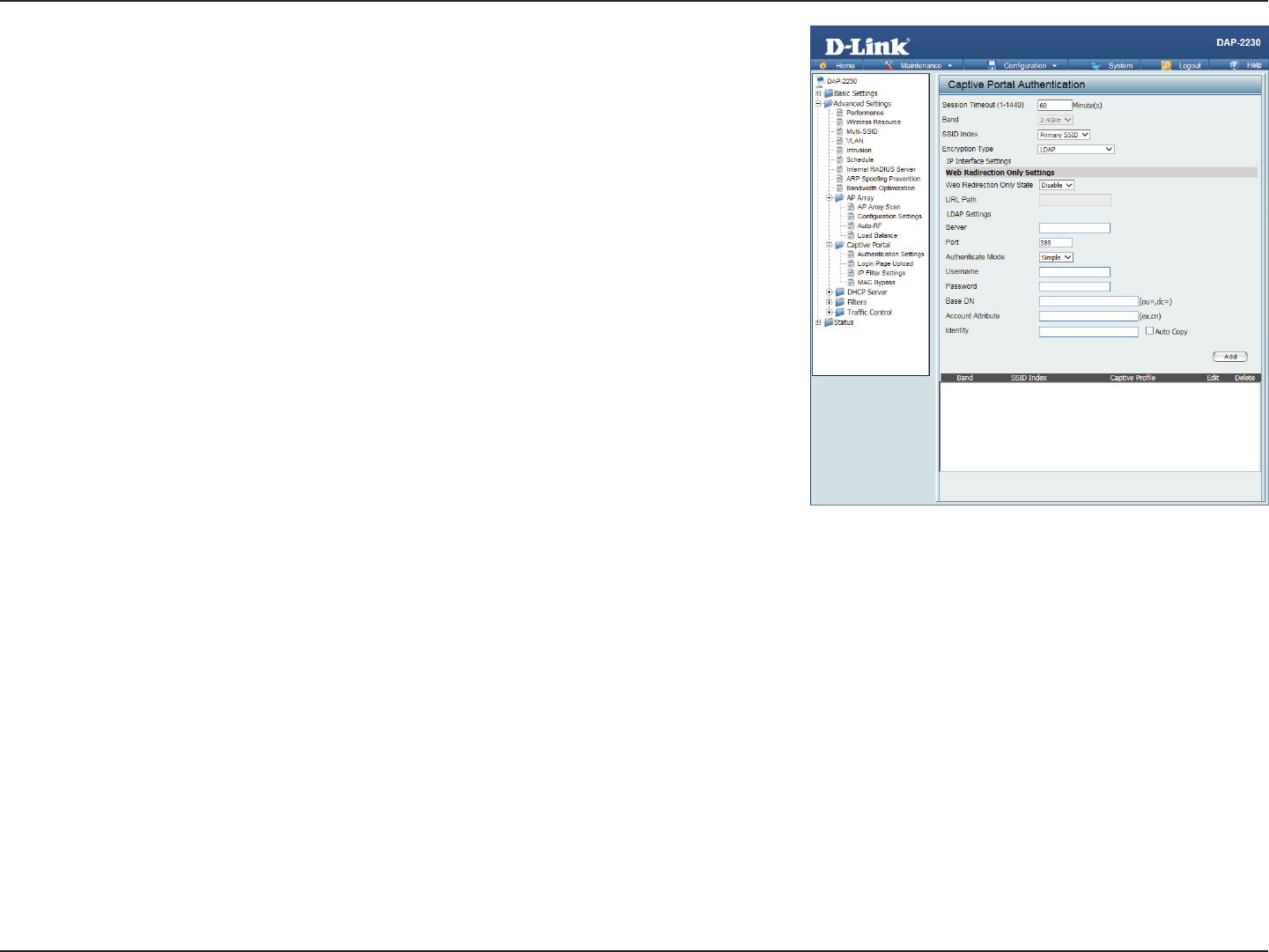
54D-Link DAP-2230 User Manual
Section 3 - Conguration
Base DN: Enter the administrator’s domain name here
Account
Attribute:
Enter the LDAP account attribute string here.
Identity: This string will be used to search for clients.
Enter the identity’s full path string here. Alternatively, select the Auto Copy
checkbox to automatically add the generic full path of the web page in the
identity eld.
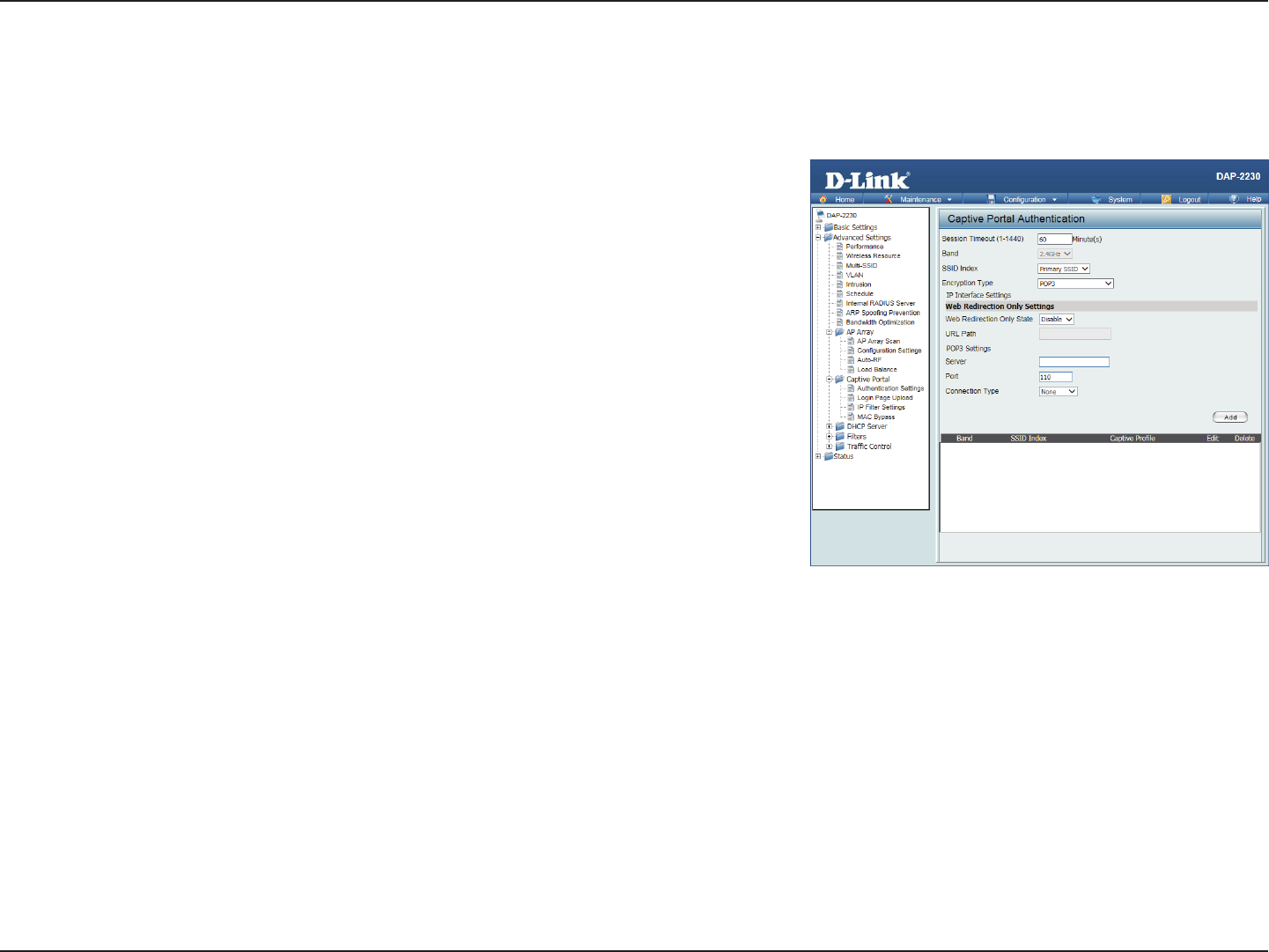
55D-Link DAP-2230 User Manual
Section 3 - Conguration
After selecting POP3 as the Authentication Type, administrators can congure the POP3 authentication settings required to
join the network.
Session
timeout
(1-1440):
Enter the session timeout value here. This value can be from 1 to 1440
minutes. By default, this value is 60 minutes.
Band: Select 2.4 Ghz.
SSID Index: Select the SSID for this Authentication.
Authentication
Type:
Select the captive portal encryption type here. Options to choose from are
Web Redirection, Username/Password, Passcode, Remote RADIUS, LDAP
and POP3.
Web
Redirection
State:
By default web redirection is disabled. Select enable to activate the website
redirection feature.
URL Path : Select whether to use either HTTP or HTTPS here. After selecting either
http:// or https://, enter the URL of the website that will be used in the space
provided.
Server: Enter the POP3 server’s IP address or domain name here.
Port: Enter the POP server’s port number here.
Connection
Type:
Select the connection type here; either None or SSL/TLS.
POP3
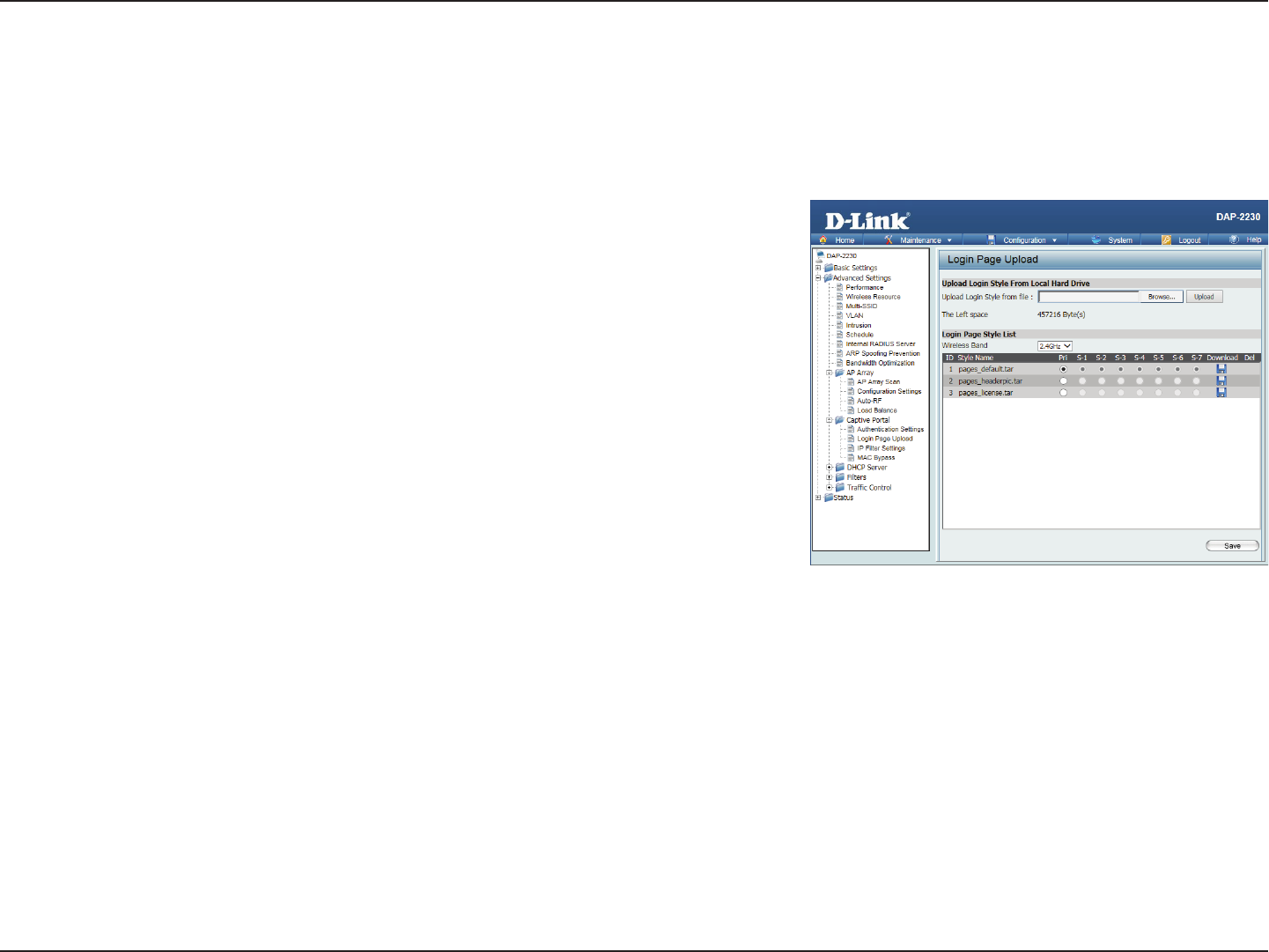
56D-Link DAP-2230 User Manual
Section 3 - Conguration
Login Page Upload
In this window, users can upload a custom login page picture that will be used by the captive portal feature. Click the Browse
button to navigate to the image le, located on the managing computer and then click the Upload button to initiate the upload.
Upload
picture
from le:
In this eld the path to the image le that will be uploaded will be displayed.
Alternatively, the path can be manually entered here.
Login Page
Style List:
Select the wireless band and login style that will be used for each SSID.
Click the Download button to download the login page template le and
Click the Del button to delete the template le.
Login Page Upload
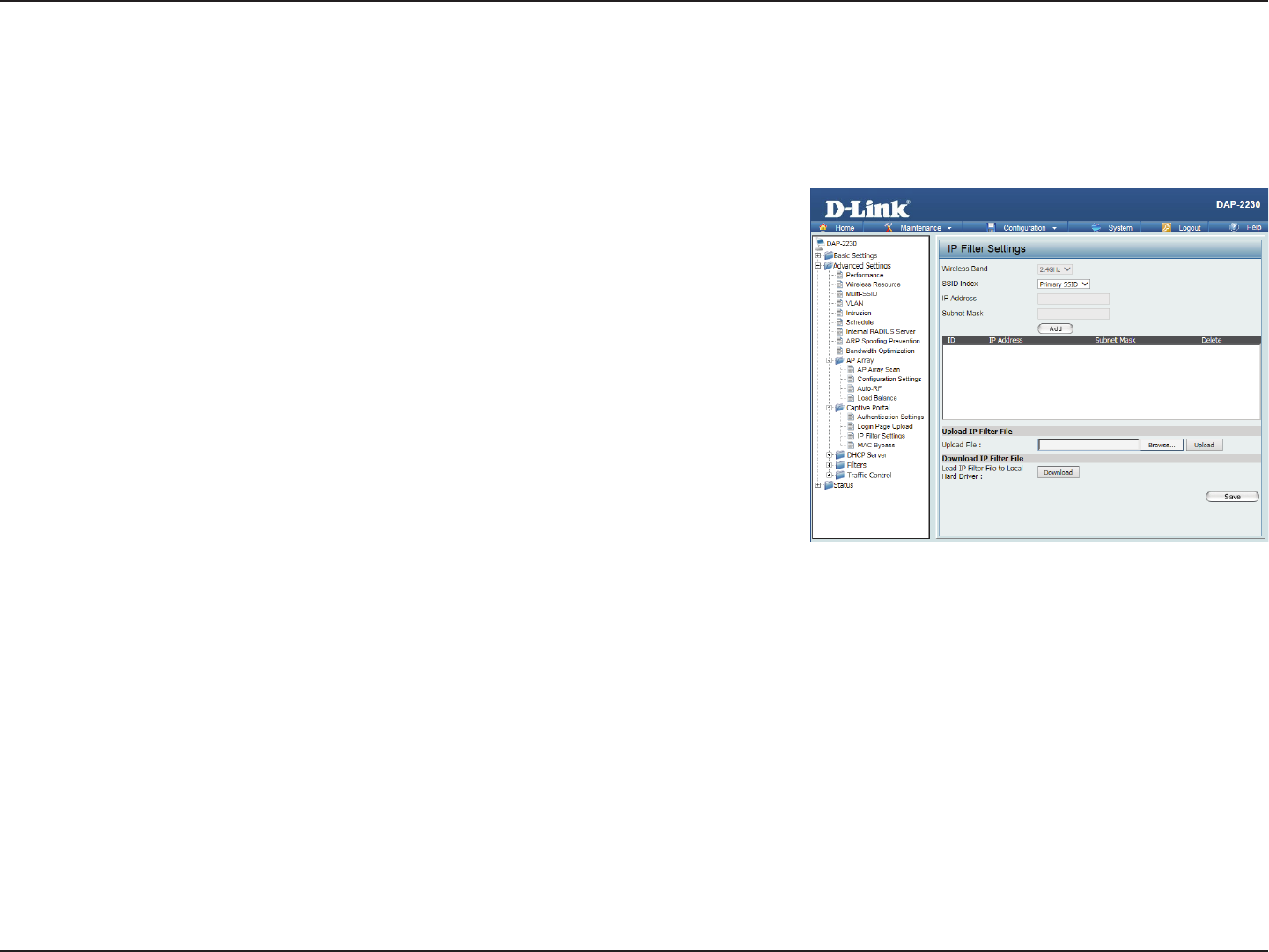
57D-Link DAP-2230 User Manual
Section 3 - Conguration
Enter the IP address or network address that will be used in the IP lter rule. For example, an IP address like 192.168.70.66 or a
network address like 192.168.70.0. This IP address or network will be inaccessible to wireless clients on this network.
Wireless
Band:
Select the wireless band for MAC Bypass.
IP Address: Enter the IP address or network address.
Subnet
Mask:
Enter the subnet mask of the IP address or networks address.
Upload IP
Filter File:
To upload an IP lter list le, click Browse and navigate to the IP lter list
le saved on your computer, and then click Upload.
Download
IP Filter File:
To download IP Filter list le, click Download and to save the IP Filter list.
IP Filter
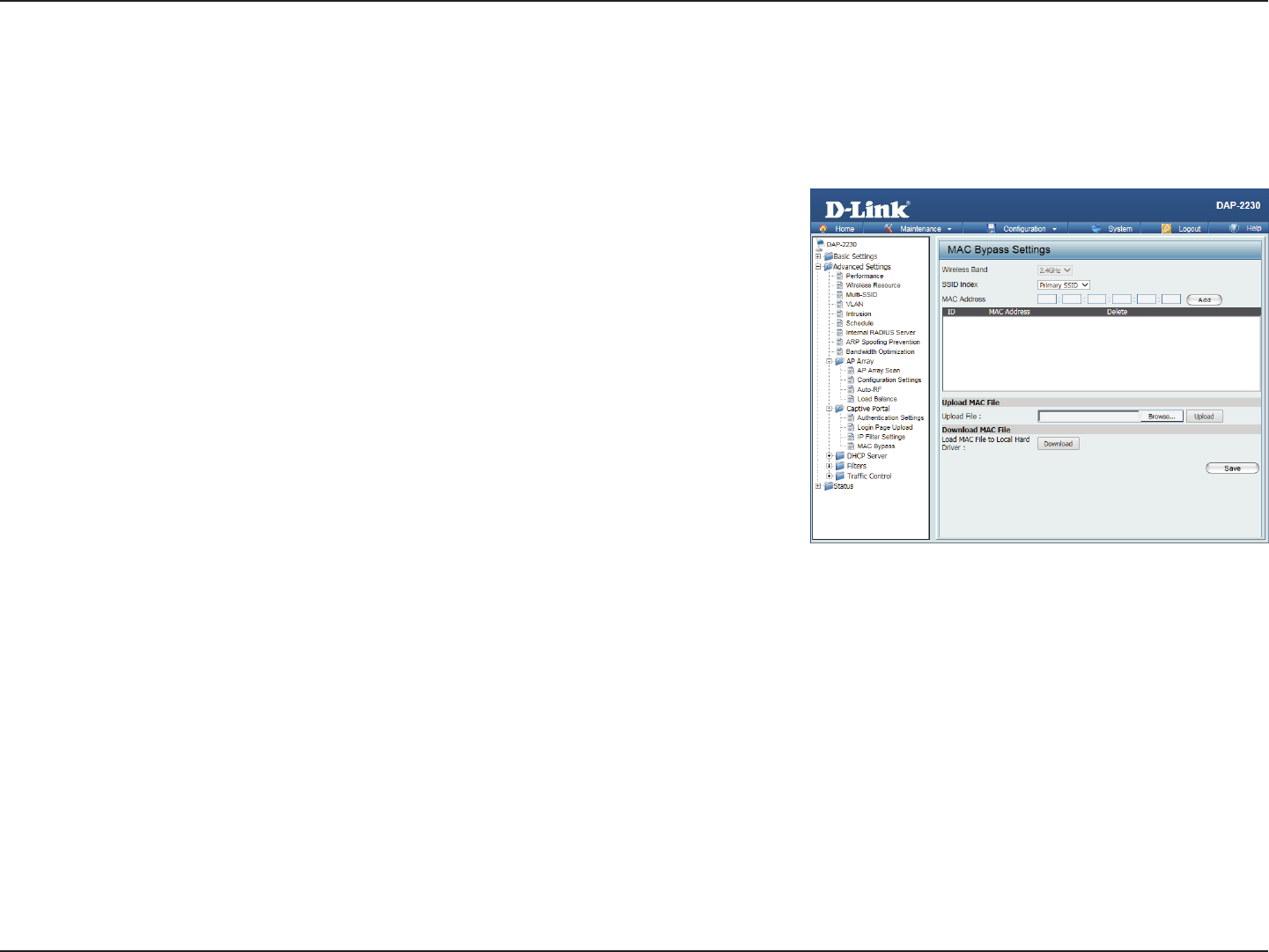
58D-Link DAP-2230 User Manual
Section 3 - Conguration
MAC Bypass
The DAP-2230 features a wireless MAC Bypass. Once a MAC address is added to the bypass list, that client will skip the
Captive Portal Authentication process when joining a network. Once an administrator is nished adjusting these settings,
click the Save button to have the changes take eect.
Wireless
Band:
Select the wireless band for MAC Bypass.
SSID Index: Select the SSID for MAC Bypass.
MAC
Address:
Enter each MAC address that you wish to include in your bypass list and then
click Add.
MAC
Address
List:
When a MAC address is entered, it appears in this list. Highlight a MAC address
and click the Delete icon to remove it from this list.
Upload File: To upload a MAC bypass list le, click Browse and navigate to the MAC bypass
list le saved on the managing computer, and then click Upload.
Load MAC
File to Local
Hard Drive:
Click Download to save the MAC bypass list le.
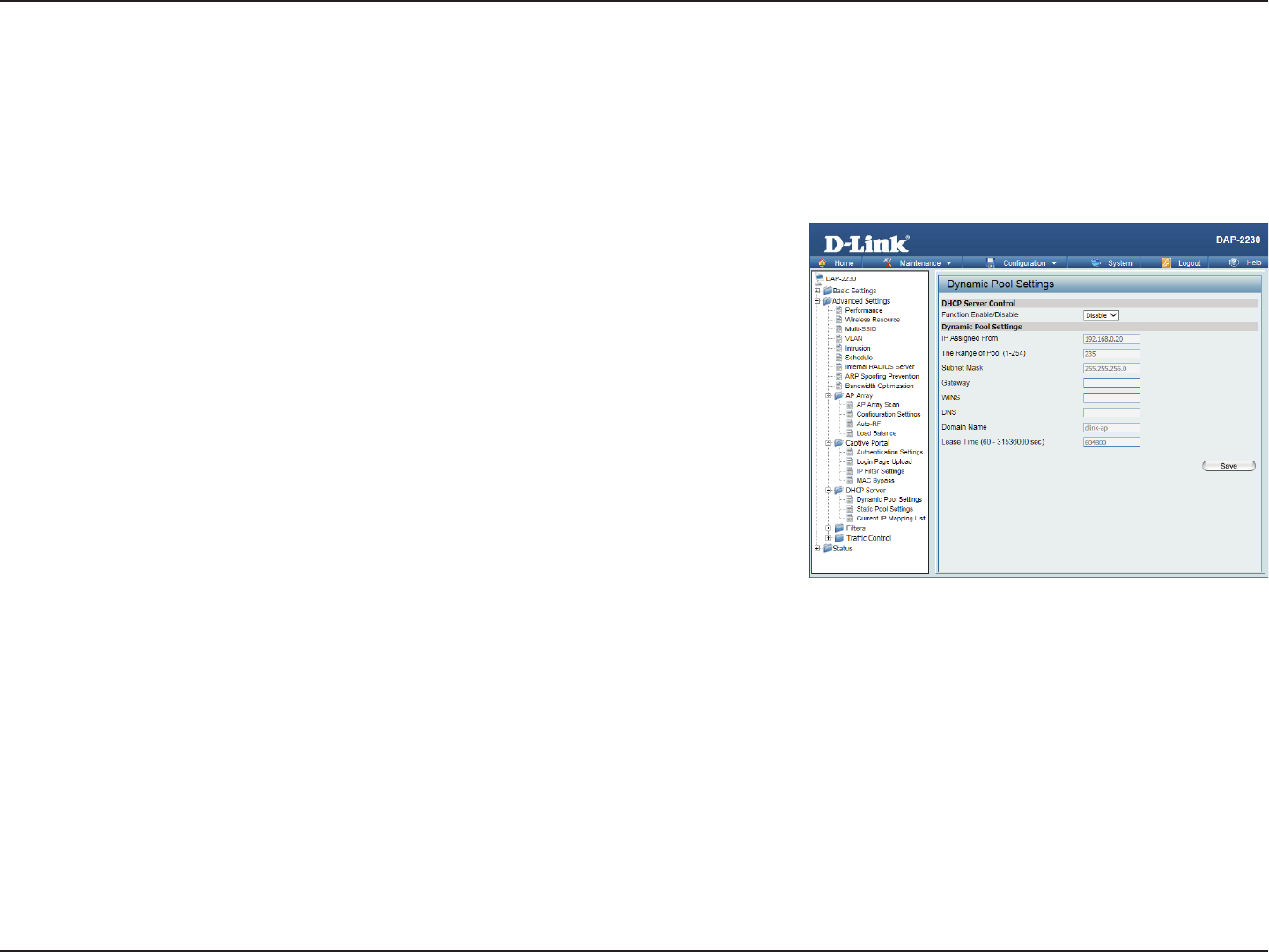
59D-Link DAP-2230 User Manual
Section 3 - Conguration
DHCP Server
Dynamic Pool Settings
The DHCP address pool denes the range of the IP addresses that can be assigned to stations on the network. A Dynamic Pool
allows wireless stations to receive an available IP with lease time control. If needed or required for the network, the DAP-2230
is capable of acting as a DHCP server.
Function
Enable/
Disable:
Dynamic Host Conguration Protocol (DHCP) assigns dynamic IP addresses
to devices on the network. This protocol simplies network management and
allows new wireless devices to receive IP addresses automatically without
the need to manually assign new IP addresses. Select Enable to allow the
DAP-2230 to function as a DHCP server.
IP Assigned
From:
Input the rst IP address available for assignment on your network.
IP Pool
Range
(1-254):
Enter the number of IP addresses available for assignment. IP addresses are
increments of the IP address specied in the “IP Assigned From” eld.
Subnet
Mask:
All devices in the network must have the same subnet mask to communicate.
Enter the submask for the network here.
Gateway: Enter the IP address of the gateway on the network.
WINS: Specify the Windows Internet Naming Service (WINS) server address for
the wireless network. WINS is a system that determines the IP address of a
network computer that has a dynamically assigned IP address.
DNS: Enter the IP address of the Domain Name System (DNS) server. The DNS
server translates domain names such as www.dlink.com into IP addresses.
Domain
Name:
Enter the domain name of the network, if applicable. (An example of a
domain name is: www.dlink.com.)
Lease Time : The lease time is the period of time before the DHCP server will assign new
IP addresses. (60-31536000 sec)
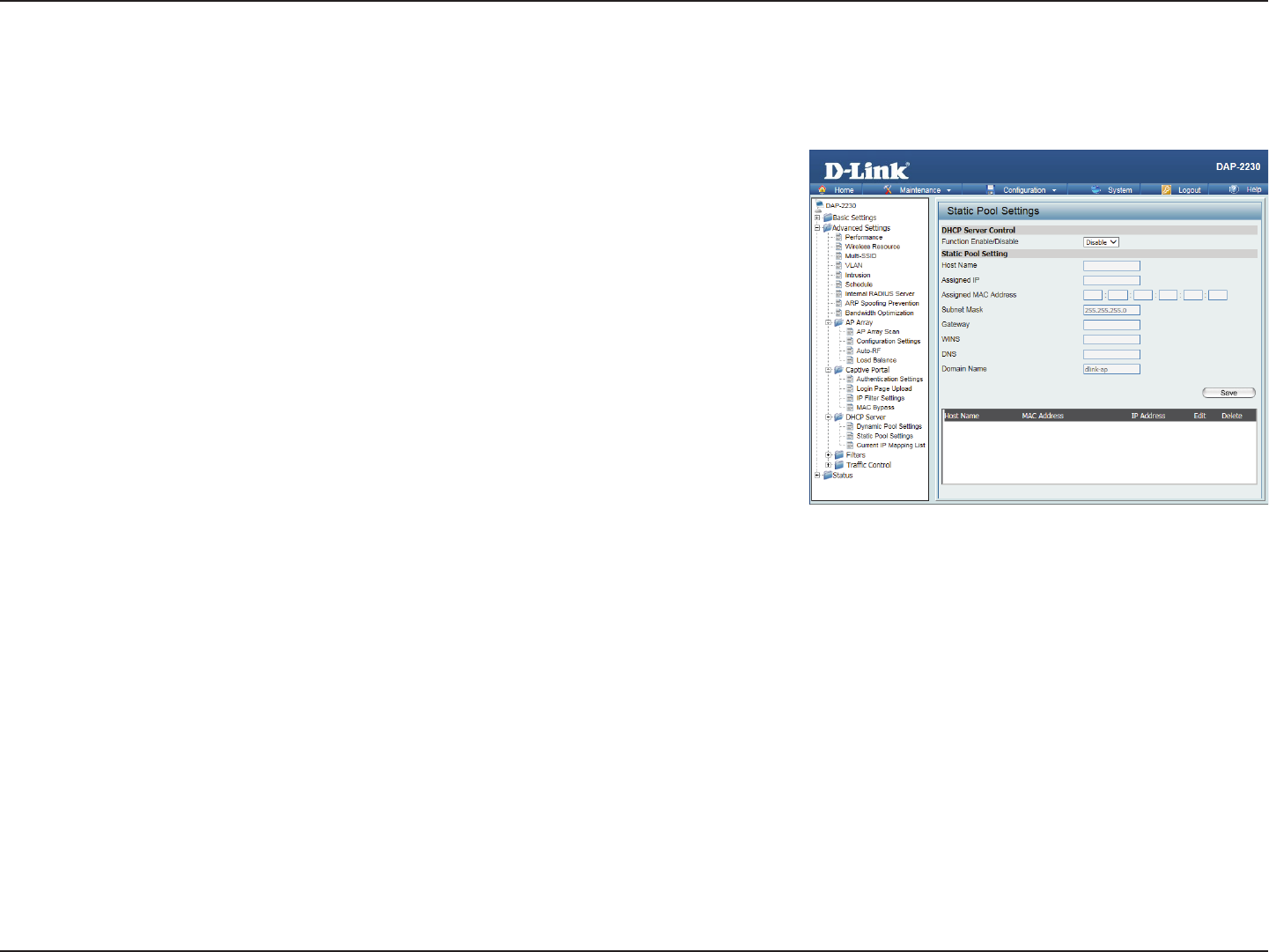
60D-Link DAP-2230 User Manual
Section 3 - Conguration
Static Pool Setting
A static pool allows specic IP addresses to be reserved to wireless stations.
Function
Enable/
Disable:
Dynamic Host Conguration Protocol (DHCP) assigns IP addresses to wireless
devices on the network. This protocol simplies network management and
allows new wireless devices to receive IP addresses automatically without the
need to manually assign IP addresses. Select Enable to allow the DAP-2230
to function as a DHCP server.
Assigned IP: Use the Static Pool Settings to reserve IP addresses to specic devices. The IP
addresses assigned in the Static Pool list must NOT be in the same IP range
as the Dynamic Pool. After you have assigned a static IP address to a device
via its MAC address, click Save; the device will appear in the Assigned Static
Pool at the bottom of the screen. You can edit or delete the device in this list.
Assigned
MAC Address:
Enter the MAC address of the device requesting association here.
Subnet Mask: Dene the submask of the IP address specied in the IP Assigned From eld.
Gateway: Specify the Gateway address for the wireless network.
WINS: Specify the Windows Internet Naming Service (WINS) server address for
the wireless network. WINS is a system that determines the IP address of
a network computer with a dynamically assigned IP address, if applicable.
DNS: Enter the Domain Name System (DNS) server address for the wireless
network. The DNS server translates domain names such as www.dlink.com
into IP addresses.
Domain
Name:
Specify the domain name for the network.
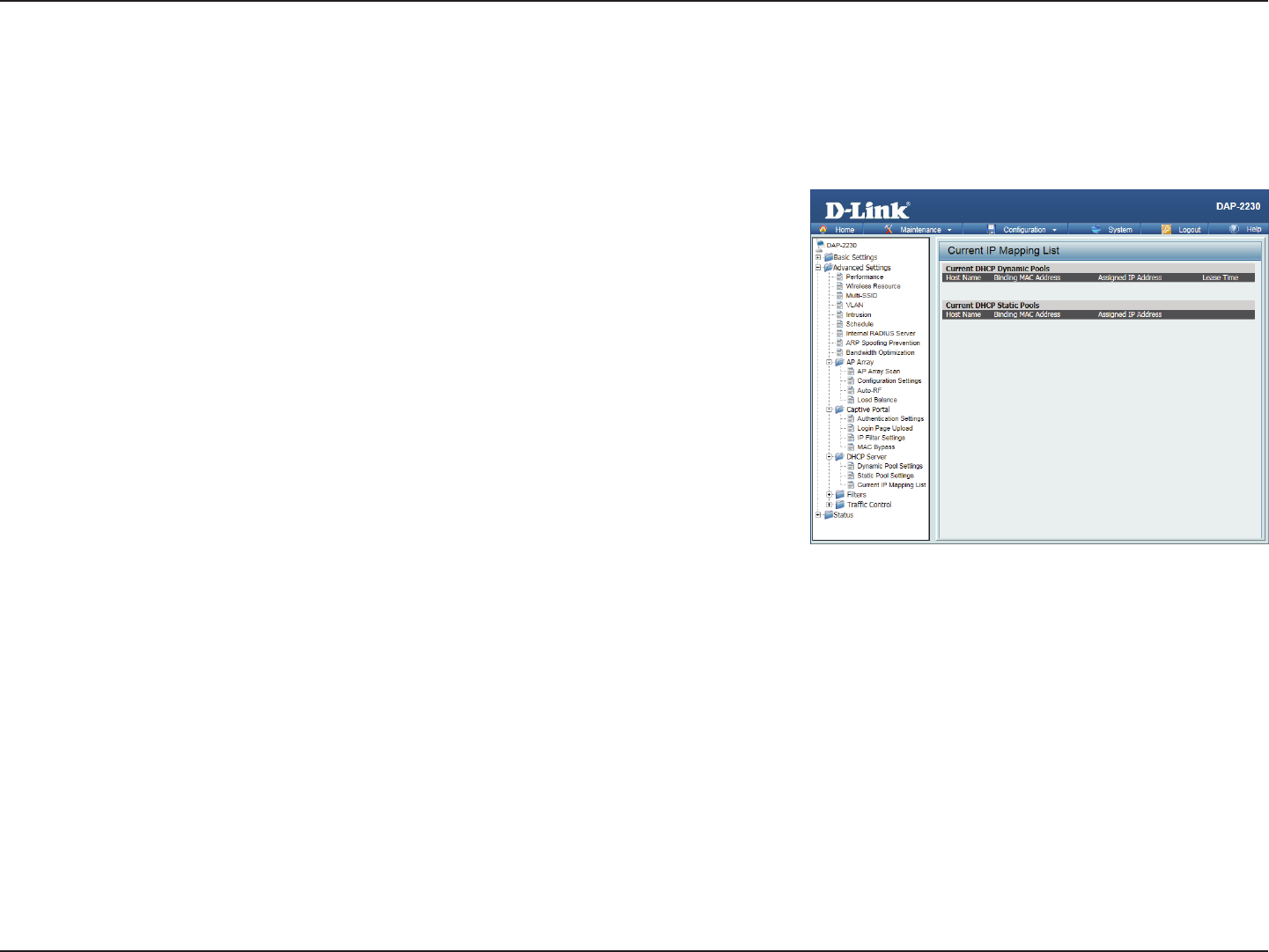
61D-Link DAP-2230 User Manual
Section 3 - Conguration
Current IP Mapping List
This window displays information about the current assigned DHCP dynamic and static IP address pools. This information is
available when you enable DHCP server on the AP and assign dynamic and static IP address pools.
Current DHCP
Dynamic Prole:
These are IP address pools the DHCP server has assigned using the dynamic
pool setting.
Host Name: The host name of a device on the network that is assigned an IP address
from the DHCP dynamic pool.
Binding MAC
Address:
The MAC address of a device on the network that is assigned an IP address
from the DHCP dynamic pool.
Assigned IP
Address:
The current corresponding DHCP-assigned IP address of the device.
Lease Time: The length of time that the dynamic IP address will be valid.
Current
DHCP Static
Pools:
These are the IP address pools of the DHCP server assigned through the
static pool settings.
Host Name: The host name of a device on the network that is assigned an IP address
from the DHCP dynamic pool.
Binding
MAC
Address:
The MAC address of a device on the network that is within the DHCP static
IP address pool.
Assigned IP
Address:
The current corresponding DHCP-assigned static IP address of the device.
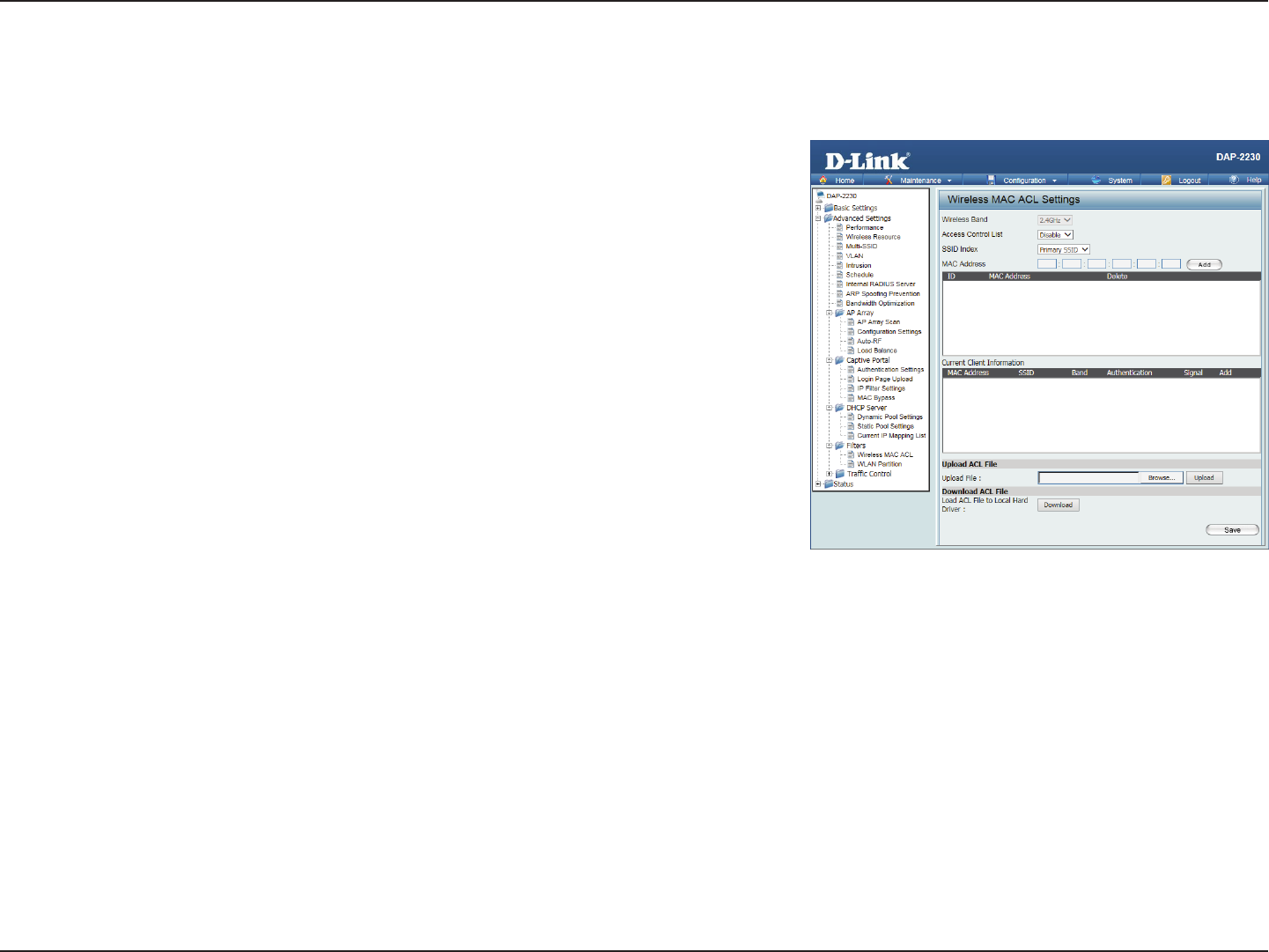
62D-Link DAP-2230 User Manual
Section 3 - Conguration
Filters
Wireless MAC ACL
Wireless
Band:
Displays the current wireless band rate.
Access
Control List:
Select Disable to disable the lters function.
MAC
Address:
Select Accept to accept only those devices with MAC addresses in the Access
Control List. All other devices not on the list will be rejected.
MAC
Address
List:
Select Reject to reject the devices with MAC addresses on the Access Control
List. All other devices not on the list will be accepted.
Upload ACL
File:
Enter each MAC address that you wish to include in your lter list, and click
Add.
When you enter a MAC address, it appears in this list. Highlight a MAC address
and click Delete to remove it from this list.
You may create an ACL list and upload it to the access point instead of
manually entering the information. Once created, click the Browse button
and locate your le. Select it and then click Upload.
Download
ACL File:
Click Download to export the ACL to a le on your computer.
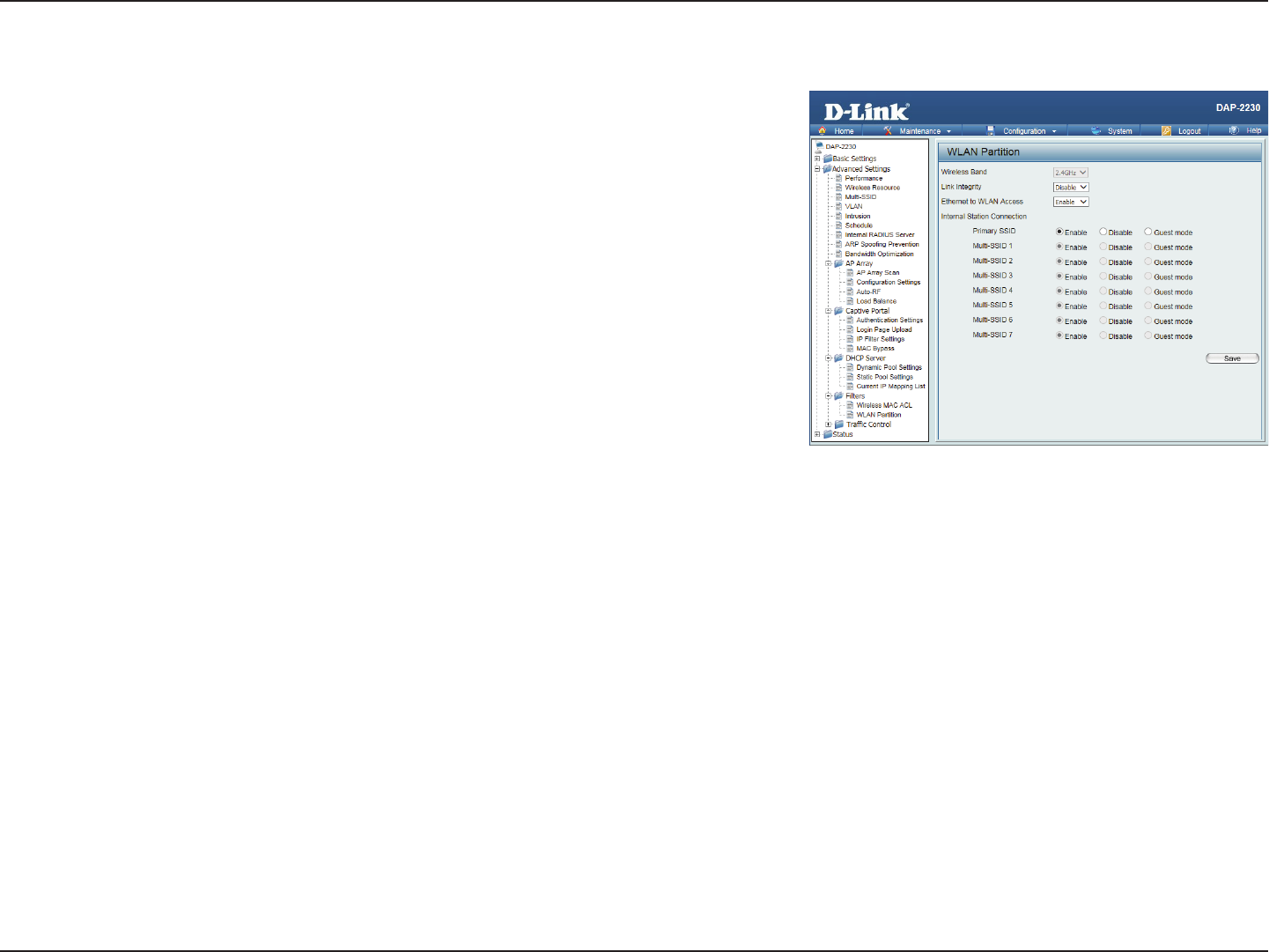
63D-Link DAP-2230 User Manual
Section 3 - Conguration
WLAN Partition
Wireless
Band:
Displays the current wireless band rate.
Link
Integrity:
Select Enable or Disable.
Ethernet
to WLAN
Access:
The default is Enable. When disabled, all data from the Ethernet port to
associated wireless devices will be blocked. Wireless devices can still send
data to the Ethernet port.
Internal
Station
Connection:
The default value is Enable, which allows stations to inter-communicate by
connecting to a target AP. When disabled, wireless stations cannot exchange
data through the AP.
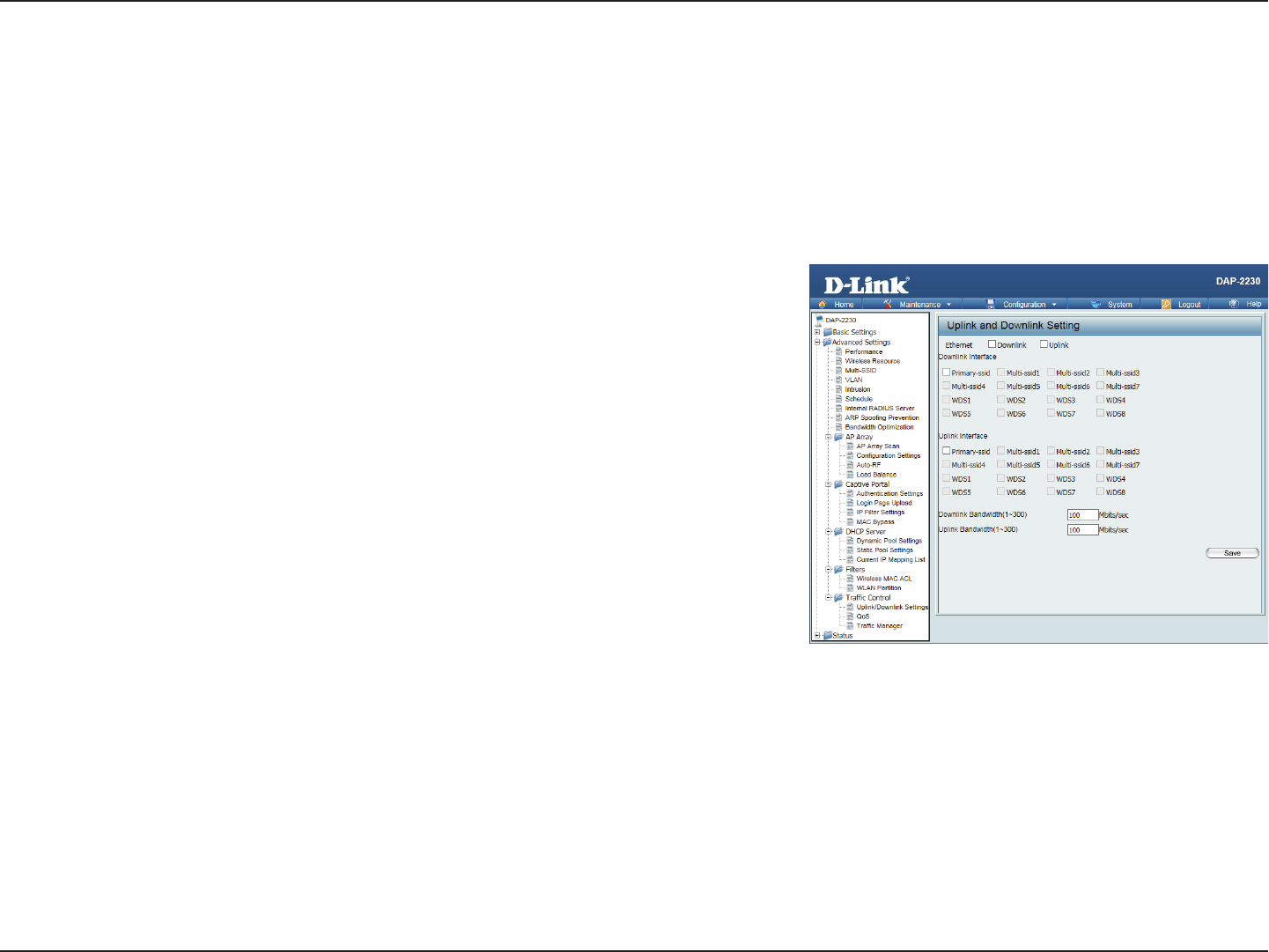
64D-Link DAP-2230 User Manual
Section 3 - Conguration
Trac Control
Uplink/Downlink Settings
The uplink/downlink setting allows users to customize the downlink and uplink interfaces including specifying downlink/uplink
bandwidth rates in Mbits per second. These values are also used in the QoS and Trac Manager windows. Once the desired
uplink and downlink settings have been selected, click the Save button to let your changes take eect.
Downlink
Bandwidth:
The downlink bandwidth in Mbits per second.
Uplink
Bandwidth:
Uplink Bandwidth: The uplink bandwidth in Mbits per second.
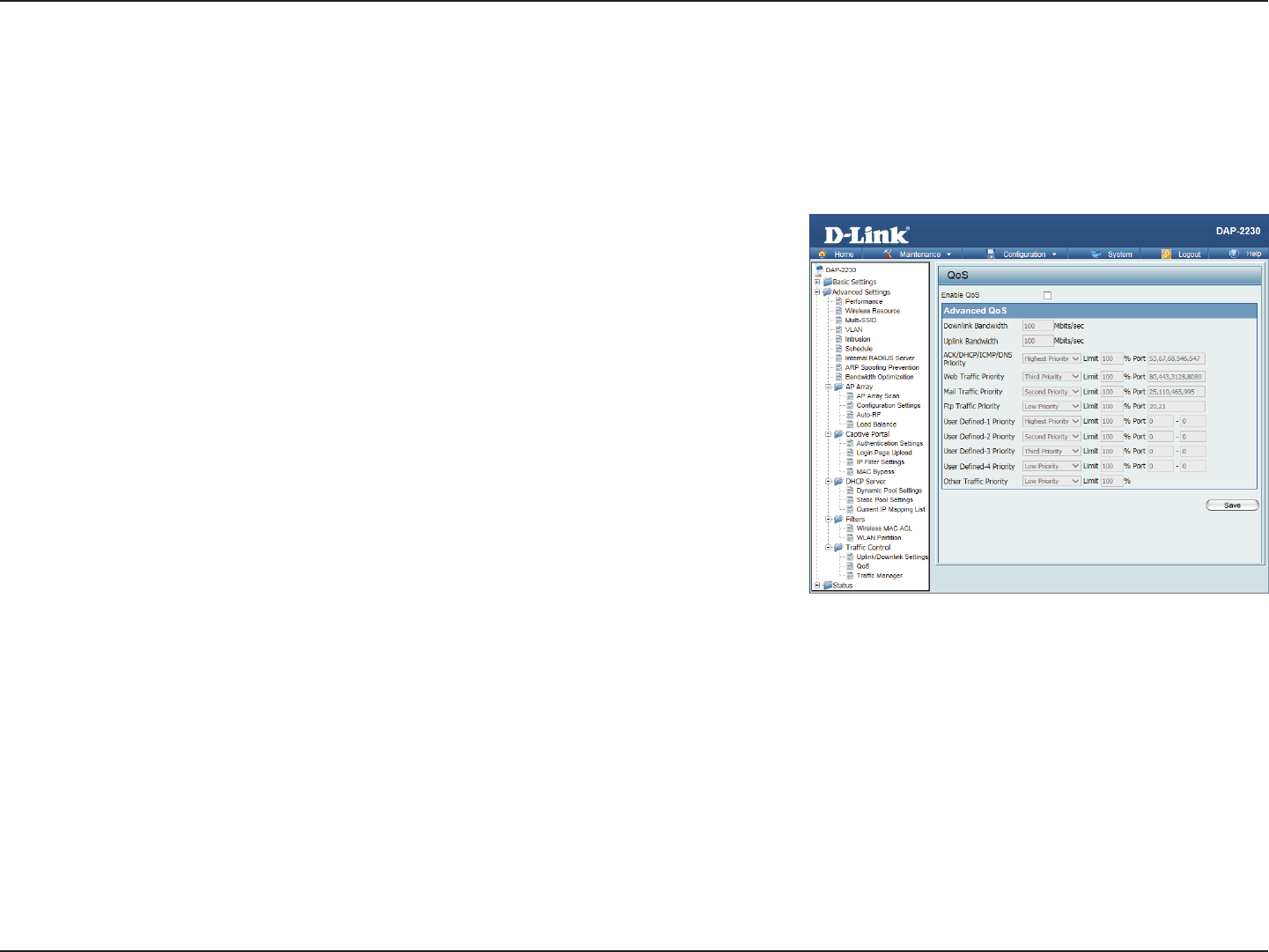
65D-Link DAP-2230 User Manual
Section 3 - Conguration
QoS
Quality of Service (QoS) enhances the experience of using a network by prioritizing the trac of dierent applications. A QoS
Rule identies a specic message ow and assigns a priority to that ow. For most applications, the priority classiers ensure
the right priorities and specic QoS Rules are not required. QoS supports overlapping rules. If more than one rule matches a
specic message ow, the rule with the highest priority will be used.
QoS
(Quality of
Service):
Enable this option if you want to allow QoS to prioritize your trac Priority
Classiers.
HTTP: Allows the access point to recognize HTTP transfers for many common audio
and video streams and prioritize them above other trac. Such streams are
frequently used by digital media players.
Automatic: When enabled, this option causes the access point to automatically attempt
to prioritize trac streams that it does not otherwise recognize, based on
the behavior that the streams exhibit. This acts to de-prioritize streams
that exhibit bulk transfer characteristics, such as le transfers, while leaving
interactive trac, such as gaming or VoIP, running at a normal priority.